Collett’s Corner Stage 1 Competition Public Vote

Collett’s Corner Stage 1 Design Competition Invitation
June 15, 2018
Tūmanako Pledgeme Campaign Launch
June 27, 2018COLLETT'S CORNER CONCEPT DESIGN COMPETITION
PUBLIC VOTING IS CLOSED
RESULTS ANNOUNCED JULY 6th
About the Collett's Corner Competition
For more details visit this page: https://ohu.nz/portfolio-item/colletts-corner/
The other three votes come from a three person jury:
Andrew Turner - Deputy Mayor and Christchurch City Councillor for the Banks Peninsula and former owner of the Empire Hotel
Tony van Raat - New Zealand Insititute of Architecture Auckland Branch Chair
Camia Young - Founding Partner of Ohu and project steward for Collett's Corner.
https://www.youtube.com/watch?v=cLCCbr0hF8Y&feature=youtu.be
Location: XCHC at 376 Wilsons Road, Woolston
Opens: 10 am July 4th
Closes: 7pm July 4th
Note: Public discussion with the design teams from 5-7pm
Public online voting for Concept Idea finalists: July 2nd 8am - July 4th 10pm
Announcement of three finalists: July 6th
Stage 2 Developed Concept: July 9th - August 31st
Public online voting for preferred Develop Concept: Sept 3rd 8am - Sept 6th 10pm
Public presentation by each design team: September 6th 6pm venue LAF - Lyttelton
Announcement of wining team: September 14th
Te Whare O Te Manawa
ADQ
“The House of the Shared Breath”
To create a design that is rooted into the urban context, inviting the connection between people. Acknowledging the necessity of harmony between people and place, coming together as a shared breath.
[showhide type = "1" more_text="Find Out More..." less_text="Show less..."]
The design is derived from the concept of connection. Connection at a social and personal scale, between people and place. Knitting together an innovative design with the urban fabric, through spatial design, evoking new experiences and interactions between people and place. Dynamic spaces will be intertwined through the manipulation of form and function, in the creation of Dramatic place which is sympathetic to the contextual vernacular.
To evoke the notion of consecutiveness within architecture, understanding the importance of the journey is key. To leave one foot in the past, while moving forward to create architecture of the future which is reminiscent to the stories of the journey that the people and place have to be here. Ensuring the wellbeing of the people and the creation of an emotional connection to place.
[/showhide]
Chance Encounters
AHHA
The concept is based on creating places and spaces for chance encounters and interactions with others. This is a place that stimulates conversation and will become a hub for community gathering.
[showhide type = "2" more_text="Find Out More..." less_text="Show less..."]
AHHA’s proposal for Collett’s Corner endeavours to be not only from & for the people but from & for the place. With a nod to Lyttelton’s past the design seeks to embrace it’s topography, it’s culture and it’s people. A sculptural and textured form blended with a well thought out mixture of business and community programmes gives the building a presence that will not only be seen but also felt by the people of Lyttelton.
The inspiration for the concept has taken cues from the nearby Port where regular movements of log piles come and go. The collections of logs are built up taking shape from the shoreline like landforms in themselves. Vivid colour and crevasse inversions create a solid/void relationship similar to rock ends off the edge of a plateau. Each length of piles undulates on its own while contributing to the broader topo-surface. These features are considered on the site when approaching the division of the form to the street, the laneway connections and the continuous roof surface that all move independently but contribute to the whole.
Each activity housed in the building interacts with one another through internal courtyards, interwoven activities, lane-ways and engaging architectural forms. Creating a destination not just for certain activities but also for social gathering.
[/showhide]
Rangatahi
Akau
Designing Collett’s Corner with Rangatahi
[showhide type = "3" more_text="Find Out More..." less_text="Show less..."]During a 3-day creative workshop with local rangatahi and community members we (ĀKAU) will develop a meaningful design response to the community generated brief for Collett’s Corner. Ohu will have an opportunity to meet rangatahi during the workshop and hear their ideas for the project.
In the following weeks ĀKAU will develop their concepts into a cohesively designed piece of architecture, with on-going rangatahi collaboration. Rangatahi will be involved in presenting the developed concept design to Ohu two weeks prior to the final submission date, and any feedback will be incorporated into the design.
[/showhide]
The Lodestar
Alessandro Baptiste Kerryn
The massing provides an inclusive open space to serve the surrounding local environment with the creation of a lane in between the building blocks.
[showhide type = "4" more_text="Find Out More..." less_text="Show less..."]
The design creates an open vertical circulation to encourage the people to 'own' the building by using it at anytime. Open decks at all levels are provided for the community use, while views through the voids are visually linking the different activities to each other.
The design seeks a dialog with both the different scales of the urban environment and the wider Lyttelton harbour. The lower floors are maintaining the surrounding scale, while the upper block is designed as a landmark.
The fabric of the building aims to celebrate the duality of its identity. The lower part is empathetic with the context with the use of a combination of recycled bricks reminiscent of the Lyttelton red stone colour. The upper part is a shiny metallic shell to attract reflections from natural and surrounding lights to act as the Lyttelton lodestar.
[/showhide]
Discovery
Cymon Allfrey Architects
Connection is fostered by drawing the community in through a sense of discovery.
[showhide type = "5" more_text="Find Out More..." less_text="Show less..."]
The CAA concept draws inspiration from many references that have made Lyttelton what it is today. The connection to the community is fostered through the concepts transparency - an effort to draw the community in through discovery. The concept is based around the existing brick-barrel pipe running on site, with an open terraced laneway - designed to entice people in and to discover the additional open space down the hill. Through multi- purpose open space at the base of the terrace, the market is given an opportunity to expand through this area, possibly leading to a revitalisation of Oxford Street. Active building typologies have been placed near London Street, Oxford Street and in the Laneway, cultivating a positive street scene.
This intends to provide a sense of continuity with the character of London Street. Conversely, residential areas are placed higher, to promote privacy from the street and enhance views, air and light. Within the concept, playful massing resembles Lyttelton’s unique do-it-yourself community. The ground floor houses high-use functions; retail, co-working, and a restaurant. Level 2 contains the cinema, a bar and residential space detached from the active uses, level 3 is also allocated residential area. The basement, which is semi excavated into the site, contains roman baths, the positioning of which references the ancient Ōhinehou Pā, located near the modern day tunnel mouth.
[/showhide]
Port Crane
Fatina, Mickey and Matty
The design is derived from understanding the local context.
[showhide type = "6" more_text="Find Out More..." less_text="Show less..."]
When viewed from above, the town of Lyttelton can be rationalised into three distinctive contextual layers: 1. Mountainscape; 2. Residential fabric; and 3. Industrial port. Each of these layers were stripped down to a rationalised ‘inceptive’ form. Such as the stacked containers within the port, the rationalised forms are harmoniously integrated together to create the various programmes. The iconic elevation of the port crane is rationalised into a structure frame.
[/showhide]
Congregate, Aggregate
Field Studio
Architecture is social: a building is first and foremost a congregation of people coming together around design, construction and inhabitation.
[showhide type = "7" more_text="Find Out More..." less_text="Show less..."]
For a building to emerge meaningfully from a unique context the design process needs as many voices talking and listening as possible. Lyttelton is remarkable for its strong community groups with much to contribute and architecture is one thing people can congregate around, by having a voice in the making and through inhabiting a building that is open and has well considered social space.
With Ngāti Māmoe settling over 700 years ago, and the present urban grain largely established in the 19th century, Lyttelton is a material and spatial aggregate with distinctive history, urban scale, character and meaning. Considering the project not as a single building, but as smaller buildings congregating on site creates a more intimate scale and one that is consistent with the historic scales of London St. This spatial move also suits the projects rich and unusual aggregate of programmes, each with specific internal needs and the potential to develop independent and expressive identities. Rather than fitting these into a unifying building, an aggregate proposal allows the parts to retain strong voices and places emphasis on designing the relationships between the parts. These gaps open the site to the street and glue the parts together with social spaces.
[/showhide]
Challenge Everything
4 Walls
The ever-changing and dynamic nature of the local community is at the core of this proposal.
[showhide type = "8" more_text="Find Out More..." less_text="Show less..."]The proposed submission centres around a free-standing scaffold-like structure, with no intrinsic cladding, roof or floors. The intention is to provide a simple serviced framework that can easily be altered according to the requirements of the time, one that reflects the crane and container nature of Lyttelton as a port town. Permanent gantries could be included in order to make change easier.
[/showhide]
Shafts of Light
Fulton Ross Team Architects
Our concept acknowledges this deeper geological timeframe and draws its inspiration from the natural features and forces that have shaped the landscape of Lyttelton.
[showhide type = "9" more_text="Find Out More..." less_text="Show less..."]Put simply, Lyttleton is a town that sits inside a volcanic crater and we want to celebrate this. With this geomorphological concept in mind the building is designed as a rock with shafts of light projecting from its core. This rock holds the heat, the light, the pressure, the steam, the sound, the energy and the life of Lyttelton. The building then, with all its programme becomes the molten hub of the town, with its cinema, bath house, cafe / informal space, its accommodation and its retail will bring life and energy to this part of town.
[/showhide]
It's Social!
Hamish Shaw
Gathered around a sheltered courtyard, the site becomes the heart and health of the community!
[showhide type = "10" more_text="Find Out More..." less_text="Show less..."] It’s a ‘social condenser’ for Lyttelton with a hybrid mix of live/work/ wellness/education/entertainment. This ring of stacked functions is shaped like ‘prismatic blocks’ that nestle into the built fabric and natural environment alike. Projecting a contemporary and lasting history for the future.
[/showhide]
The Bowline Knot: Te Herenga Tangata
Harbour Locals
Rather than isolating the programs, like the Bowline our programs are tied together.
[showhide type = "11" more_text="Find Out More..." less_text="Show less..."] The ‘king of knots’ is possibly the most commonly used knot on both commercial & recreational vessels & its history predates that of the wheel. Like the Bowline our programs are tied together. Both spatially & functionally these intersections create spaces where people can meet & create meaningful memories & connections, grow & strengthening a sense of community. Read in plain, the core of the Bowline represents circulation through the various programs of the building, connecting spaces together.
[/showhide]
The Hive
In-Flux
The Hive is a city within a town, a microcosm of Lyttelton & its community; a modular & permeable hub of interconnected activity.
[showhide type = "12" more_text="Find Out More..." less_text="Show less..."] While the Hive is uniquely large in scale to house the multiple functions & create a civic presence at its prominent location, its volume was carved out & modulated to reflect the grain of London St & allow permeable sun-filled spaces – a contrast to the typically dark introverted buildings.
A modular grid of 2.9m- an efficient module for hotels/apartments & small retail spaces – allows a strong foundation to support the more open cinema spaces at the top floor with spectacular views over the harbour. The stacking & interconnecting modules are reminiscent of the port. It is imagined that sustainable & prefabricated structural systems such as CLT be used for the bones of the building, timber also being an important & transitory character in the town. Insulated glass skin allows transparency & daylight. Floors are generally divided by function, but connect through courtyards, terraces, bridges & sculptural vertical circulation. A large central courtyard & alleys cut through the building at ground level protecting from harsh winds. The rooftop farm provide an ideal educational space, suitable for Lyttelton’s microclimate.
[/showhide]
The Wharf and Jetty
Ignite Architects and Beca
A new ‘wharf and jetty’ are created at the edge of London Street, where three vibrant vessels are docked, floating above the public baths below.
[showhide type = "13" more_text="Find Out More..." less_text="Show less..."] Inspiration is drawn from the maritime forms and iconography of the port, as well as its historic bustle, energy and activity. Some of the ever-present logs will be retained on land and utilised for the building’s structure.
A welcoming and meaningful landmark building that identifies with the Lyttelton community to foster a sense of belonging and provide a place of connection and wellbeing. Represented as a series of vessels, the design is a nod to the history of the Port and the town of Lyttelton. Key historical features including the heritage stormwater drain have been celebrated as part of the design narrative. The design ensures longevity and enables a regenerative economic structure through the adaptability and flexibility of spaces, which can be used in a variety of ways without altering the building fabric.
The ideology of looking after one another’s wellbeing, as well as the environment, has been intricately woven into the design methodology. To ensure the landmark development promotes sustainable living, Ignite has collaborated with Beca to investigate solutions for achieving a Carbon Zero building. The accreditation would target a net zero energy emissions for the ‘vessels’, while the undercroft, which houses the baths, would promote sustainable and energy efficient features.
[/showhide]
Tihei Mauri Ora
Jasmax
Our principle is:
Keep it simple sweetie!
[showhide type = "14" more_text="Find Out More..." less_text="Show less..."] Jasmax are Architects, Landscape Architects, Interior Designers and Urban Designers. Green, Sustainable, Bicultural are all pre-integrated. We have designed and delivered swimming pools and hospitals, fales and maraes, homes, schools and church halls, rail stations and bus stops, memorials and gardens, streetscapes and national museums, pavilions and theatres. We have a great deal of experience, we would love to co-create Collett's Corner with you. Something amazing!
[/showhide]
Community on Display
Jeff & Tao
Through this space planning approach, people are able to have a complete view of all the activities that are happening in the building all at once.
[showhide type="15" more_text="Find Out More..." less_text="Show less..." ]
We have created a series of “in-between” spaces where different functions meet. For example, a “co-work spill out” zone that is placed between workplace, retail and the restaurant, where workplace functions or parties can be held; A cosy “Backpacker’s Lounge” space that is a part of the accommodation where you can sit back, relax, read books and mingle with people. Spaces are connected together through a continuous multi-functional staircase that is placed centrally in the building. The stairs connect different zones and can be used for a range of activities, such as hosting small presentations, quiet reading spaces, lounges, viewing platforms, dinner parties etc. By bringing life to the stairs, vertical connection is created to connect different levels together.
[/showhide]
Ōhinehou
Matt Bourne Design
My concept for this design draws on the original Maori name of Lyttelton—Ōhinehou. The name refers to a young girl who was abducted by the Patupaiarehe and changed into a new person.
[showhide type="16" more_text="Find Out More..." less_text="Show less..." ]
Design reciprocation from existing hills and surroundings are a feature throughout; forming the basis of the language. Flowing vertical gardens following burgeoning hills is transparent in the form, and offers a sense of belonging whilst materials relate to the existing structures.
[/showhide]
We Dine Together
Oto Group
We arrived at a collection of buildings embracing a generous public space which we feel reflects the character of Lyttelton.
[showhide type = "17" more_text="Find Out More..." less_text="Show less..."]
We want our outdoor spaces to act as an extension of the community, and are large to accommodate this. The courtyard is an excellent space for summer activities and also becomes part of the markets every Saturday. The roof garden is open all day and night, turning from a sunny deck, into a cinema, and open for late night love-scapades. The urban design offers sustainable solutions through water management and biodiversity while the roof garden purifies water and keeps the building warm.
From our studies and experiments, we arrived at a collection of buildings which we feel reflects the character of Lyttelton. We wanted to add to the vibe of the area, not create a solid block. We want the hotel dwellers to feel a part of the community, with views down to the courtyard and London Street as well as connected to the Dining room via a bridge. The Co-work space is also linked to the Dining room for more informal collaborations and meetings, and has a generous plan for maker space, tables and other facilities. It would be designed to foster connections and provide inspiration for others.
[/showhide]
The Colonnade
Patchwork Architecture
Our concept design is for a building with porous edges, which extends the footpath into the site, and encourages the public to interact with the building and it’s occupants.
[showhide type="18" more_text="Find Out More..." less_text="Show less..." ]
The branching columns which wrap the full extent of the street frontage of the site create not only a highly recognisable street corner presence, but also offer a flexible screening device which ensures that privacy can be provided where it is required within the building.
These branching columns form part of a large verandah at street level, and then expand to enclose and screen, the upper level balconies and create the balustrade of the roof terrace.
The glazed link and void through the centre of the building invites the public further into the site, and provides for physical links and views through the site - including through to the harbour below.
The proposed design concept is for a building that can easily accomodate a variety of uses, in a variety of configurations, allowing for the community to inhabit it as required.
[/showhide]
Courtyards and Piazzas
Phil Redmond Architecture + Urbanism
The hybrid program allows for a shared circulation zones which manifest as courtyards and piazzas.
[showhide type="19" more_text="Find Out More..." less_text="Show less..." ] A city block is scaled to exist with a singular site. Overlapping and shared spaces engage interaction between visitors. This is the key focus for our concept.
It is our intention that the interaction/overlapping of programs exists in section throughout the building.
Historic and lost Lyttelton buildings are referenced within the new project, creating a familiarity with locals, and archiving lost character. The materiality of the new building will be precast concrete, brick and weatherboard. These materials will be used to break down the scale of the development and tie to the urban fabric.
[/showhide]
Collett's Yard
Rennie Dowsett Architects
Create an attraction in Lyttelton where local people can meet up in a way that reinforces the already strong community and adds to it's "gritty ambience" while also welcoming visitors.
[showhide type="20" more_text="Find Out More..." less_text="Show less..." ] We have family connections to Lyttelton and are frequent visitors. We experienced the "first" earthquake on one of these visits. On the morning after, we walked with the family into town, where the strength of community was obvious. There were very many caring social interactions that took place that day, and with the ongoing physical helping out over the following days. The devastation of the later February earthquake and the upheaval and loss to locals has been pretty relentless so it's wonderful to see an initiative like this one, by Ohu, for a "Property development with a soul", that creates a building that is collectively owned.
[/showhide]
Volcanic Cone
Sheppard & Rout
The environment the site sits in – a port town within a dormant flooded volcano – has informed the design decisions.
[showhide type="21" more_text="Find Out More..." less_text="Show less..." ] A red pigmented concrete cylinder open to the sky with a public hot pool at its base provides a community and urban focus to the building, while poetically evoking the volcanic origins of the setting and the industrial funnels of the maritime environment.
A transparent ground floor allows a connection from London Street through the building to the port beyond. The hovering faceted façade of the upper floors evoke the folded planes of the crater rim around the harbour. It also gives an urban anchoring mass to the important corner reminiscent of the large heritage buildings there previously.
Key material decisions we envisage at the moment include the use of local red volcanic stone for the basement, pigmented concrete core, LVL timber technology structure and a green roof. It is a building for Lyttelton that is all about the unique character and quality of its location and the local community.
[/showhide]
The Power Station
Solarchitects
A new development for Lyttelton with it’s own power station sees innovative technology used to create real community power.
[showhide type="22" more_text="Find Out More..." less_text="Show less..." ] A new Ohu and community-led development with a vibrant and somewhat eclectic mix of facilities is planned for Lyttelton’s main street. The London Street proposal, on the Collett’s Corner site, is to be knitted into the local community and the buildings are to be designed to reinforce this. The development will also be designed to meet the local District Plan requirements as well as perhaps adding a few new ideas. The regeneration plan for Lyttelton will be integrated and the building will link to planned laneways. The unique combination of activities that the Ohu development pulls together brings a real opportunity to create one of the most sustainable and ecofriendly buildings in the country. Lyttelton’s reputation for caring for its environment will be enhanced, local jobs will be created and the development provides a real opportunity to provide for strong and viable, health and well-being centred, community facilities.
[/showhide]
Dry Dock
South Pacific Architecture
The idea of the building is in response to the increasing number of locals and visitors descending on the port town.
[showhide type="23" more_text="Find Out More..." less_text="Show less..." ] This project explores the possibilities of using the metaphor of the Dry-Dock as a container for urban activity and facilitating the connection of people to foster community. Received within a generous urban square, this is Dry dock architecture, a space between two buildings, where an intergenerational community can come to Occupy (flood) the basin between the two buildings, a space for social maintenance and repair, a place to gather, (clean and inspect) restore and renew. All the terraces have different heights, and they will all be alternately flooded (with people) following the fluctuation of programme and events, offering opportunities for diverse recreation facilities; from an ecological park of tidal marsh, shell farming, sheep meadows to saline agriculture, functioning as an urban garden where people can recreate.
[/showhide]
Collett's Common
Spacecraft Architects
The arched timber structure creates an open, playful rhythm of visually connected spaces.
[showhide type="24" more_text="Find Out More..." less_text="Show less..." ]
Offering shared amenity and attraction alike, this proposal expresses openness and belonging to place. The building is a gathering place, an exemplary landmark and an interpretation of Lyttelton’s built history lost to the earthquakes. The vaulted basement pools, public plaza, light-filled courtyard, timber structure and rooftop viewing platform combine to form a building rooted in and growing from its community.
The ground floor of the building forms a public plaza, opening to London and Oxford Streets, and the proposed laneway to the West of the site. This extension of the public realm will serve as a community hub accommodating the restaurant, shared workspace and retail, along with temporary activities such as overflow for the Farmers' Markets, emergency coordination, public performance, outdoor dining, chatting and lingering to name a few. Barrel vaults in the basement baths form a strong foundation to the building and support the public life above. The existing brick-barrel drain is exposed as a scupper to fill the public bath, bringing the sound of flowing water. From this solid base the arched timber structure creates an open, playful rhythm of visually connected spaces. These structures reference the arched language of lost heritage buildings (on site and environs), updating this with cutting edge structural timber technology. The grounded base and timber superstructure connects to both Māori and Colonial timber building traditions in NZ while the break along the northern facade references the prior sites of Collett’s Chemist and The Empire Hotel and General Store.
[/showhide]
Loom Lyttelton
Stephenson & Turner
Weaving: the process of forming cloth or fabric on a loom by interlacing yarn or thread.
[showhide type="25" more_text="Find Out More..." less_text="Show less..." ]Our hearts are driven by our ears. We know that any well resolved urban community project must bring a design team focused on listening. Our design team specialises in social architecture which makes us used to active listening, focused heavily on great social outcomes that contribute on as many social, urban environmental and economic levels as possible.
[/showhide]
The Plaza
Strachan Group Architects
We envision Collett’s Corner as an extension of the street, a chance to draw the public beneath the melodic canopy into a plaza surrounded by a hub of community-oriented activity.
[showhide type="26" more_text="Find Out More..." less_text="Show less..." ]The canopy is an ode to the historic context of London Street, using the language of the former archways which permeated many of the facades of Lyttelton’s earthquake-devastated buildings.
The existing site’s use as an informal thoroughfare to Oxford Street is retained and encouraged, with the intersection of the proposed thoroughfare and services circulation doubling as a space for projecting cinema for the public, along with a connection to the main entrance to the public baths. This south shared zone allows future adjacent buildings the opportunity to open up and spill onto the same space, further activating and populating the new laneway.
Three prominent street corners are formed in the creation of the plaza and shared thoroughfare, offering opportunities to disperse small local businesses such as a coffee bar, a barber shop or perhaps an organic bratwurst kiosk for the late night cinema screenings.
Above this hive of activity sits the flexi-accommodation, topped with a private rooftop terrace to the West of the skybridge and a rooftop bar to the East (accessed via the skybridge), both opening to the views of the Lyttelton Harbour and the Port Hills.
[/showhide]
The Diagonal
Stuart Manning Architects and Hampton Jones
The concept adds a new diagonal “leg” to London Street, routed through to the heart of the retail space, articulated to the rest of the spaces by the vertical circulation.
[showhide type="27" more_text="Find Out More..." less_text="Show less..." ]The existing community footprint over the site, inspired our concept of the building permeability, which is reinforced with well placed vertical circulation, stimulating and facilitating a pedestrian presence through the building’s spaces. The concept presented a public square space at ground and first floor levels, plus a private balcony at the second floor, which opens the building to the west side of the site. It embraces London Street’s every-day-life, reinforcing & consolidating the street scene.
The concept is to have a place that is more than a building. It should be part of the local life: a place that strengthens and supports the day to day activities as well as celebrations in Lyttelton.
[/showhide]
The Grid
Thomas Associates Architects
Flexible building framework that encourages interaction and can be easily adapted for future uses. Regular economic structural grid that provides spaces without load bearing walls.
[showhide type="28" more_text="Find Out More..." less_text="Show less..." ]
Efficient central core. Sunlight filled Atrium linking internal spaces vertically and horizontally.
Defined context at each floor level providing an external understanding of the building activities.
Accessible to all users from street frontages and future laneway.
Set back from boundaries providing accessible landscaped areas.
Sustainable materials in keeping with the local Lyttelton environment including volcanic stone, steel, concrete, timber, prefinished metal.
Building users engaging with the local community through extensive glazing, balconies, roof deck and landscaped surrounds.
Acknowledging local Iwi principles:
Whanaungatanga – sense of family, connection and relationship through a shared experience and working together which provides people with a sense of belonging.
Kaitiakitanga – Connection to nature and caring for the environment.
Adhering to district planning rules.
Construction within budget allowance.
[/showhide]
Connections
Trengrove Architects
Emotional connection created not by symbol but by being a part of design process and creation of new approachable & accessible spaces and positive interactions with a spatial context.
[showhide type="29" more_text="Find Out More..." less_text="Show less..." ]Cultivation of community and emotional connection:
Effective design fosters connection between people and their environment, enhancing feelings of relationship, and a sense of membership in a meaningful community. Emotional attachments motivate people’s performance and productivity, and prompt us to identify with, value and sustain the places we inhabit.
Experience of space and places:
Overlap is the key to creating vibrant organic spaces which coalesce to form a place.
Connection with environment
Physical and mental wellbeing rely on the quality of the connections to the world beyond ourselves of which we still remain a part.
[/showhide]
Te Whakaraupo
unit Y
unit Y is set up by architects to enable students of architecture, recent graduates, and communities to realise their architectural ambition through building projects.
[showhide type="30" more_text="Find Out More..." less_text="Show less..." ]
“The man comes from the lips of the shore to gather rocks and shovel sand.
He needs the things as well. The man must build a house and so he does. He builds it out of rocks and sand and timber. He builds it with his own hands, working tirelessly until at last the house stands with his dignity.”
“Within this house he will love and be loved, raise children, host friends and family offer shelter, sanctuary, safety.
Small birds will nest beneath the eaves and he will exalt in the their singing.
Here is a place of mana.”
[/showhide]
The Melting Pot
Wilkie + Bruce Architects
The design for Collett’s Corner links this cultural backdrop with the wider geological context and landscape.
[showhide type="31" more_text="Find Out More..." less_text="Show less..." ]Lyttelton / Ohinehou is a melting pot, with layers of culture and meaning from Maori beginnings, to European settlers and an influx of influences from the port and its international maritime trade.
A visual connection is set up through the site to the Harbour / Te Whakaraupo below, and looking back up through the building to the hills. This view corridor generates a central laneway which lies on axis with Mt Herbert / Te Aahu Pataki and the underlying historic brick drain. It provides a central meeting, circulation and multi-purpose indoor/ outdoor space.
The folded canopy over the central laneway is te Rapaki o Te Rakiwhakaputa. The urban design strategy is to break the building form into four parts with linkages or lanes between. Accommodation and cinema/ bar functions are then stacked above this with bridges and walkways providing links.
Street activation is provided by small retail units on London Street and the restaurant is the key focus on the London St / Oxford St Corner. Like other venues on London Street, the upper south facing levels are given over to spectacular views out to the harbour. The proposed western laneway (by CCC) would open onto the co-working courtyard built out over the swimming pool.
[/showhide]
02-04 July 2018 – A collection of all 31 entries.
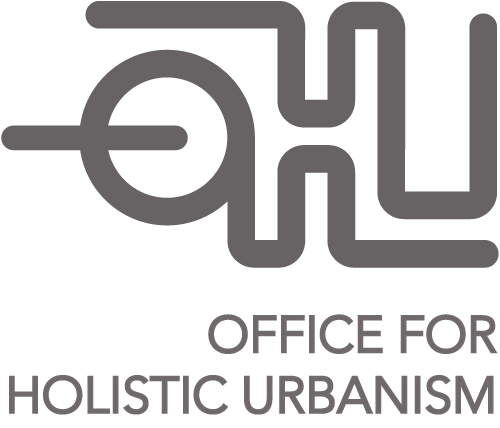
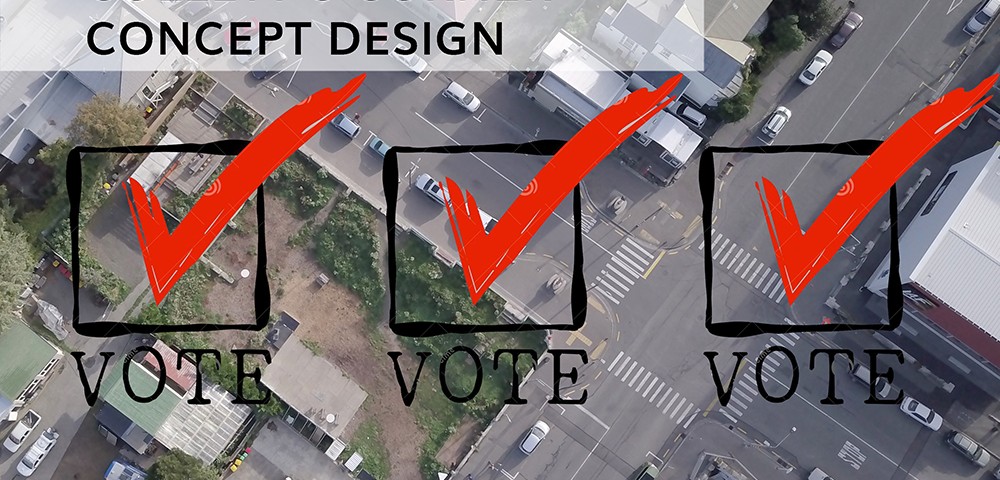
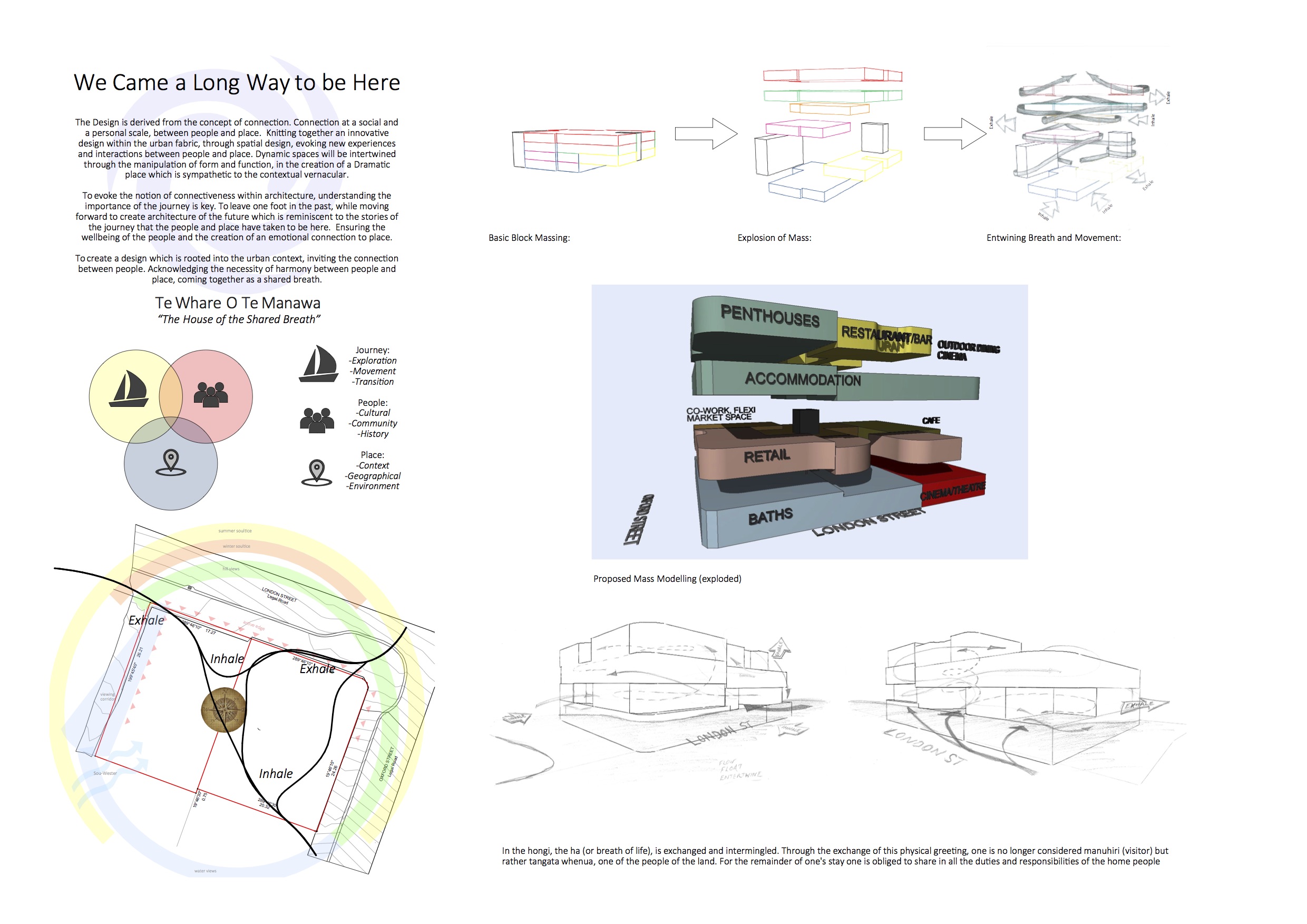
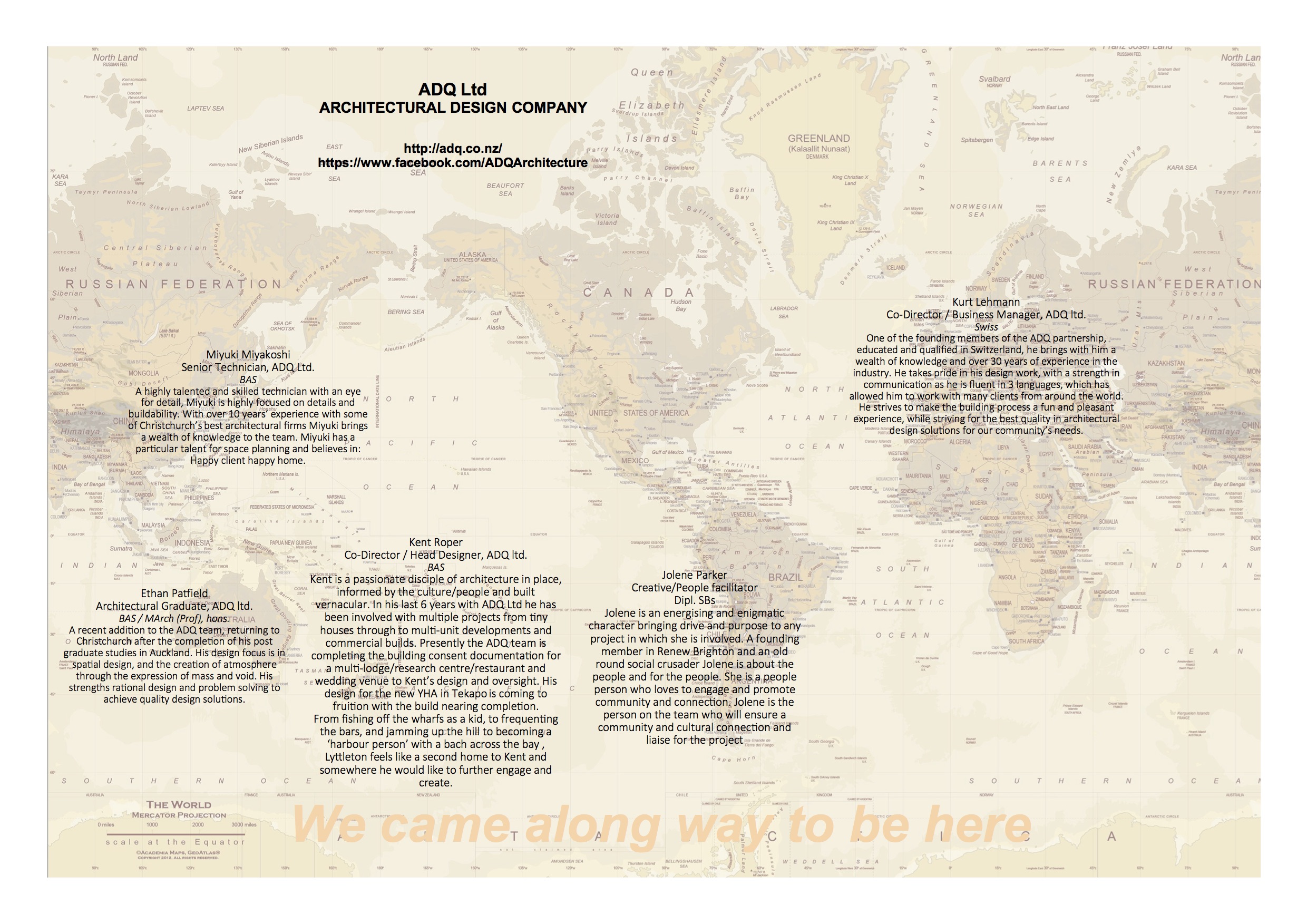
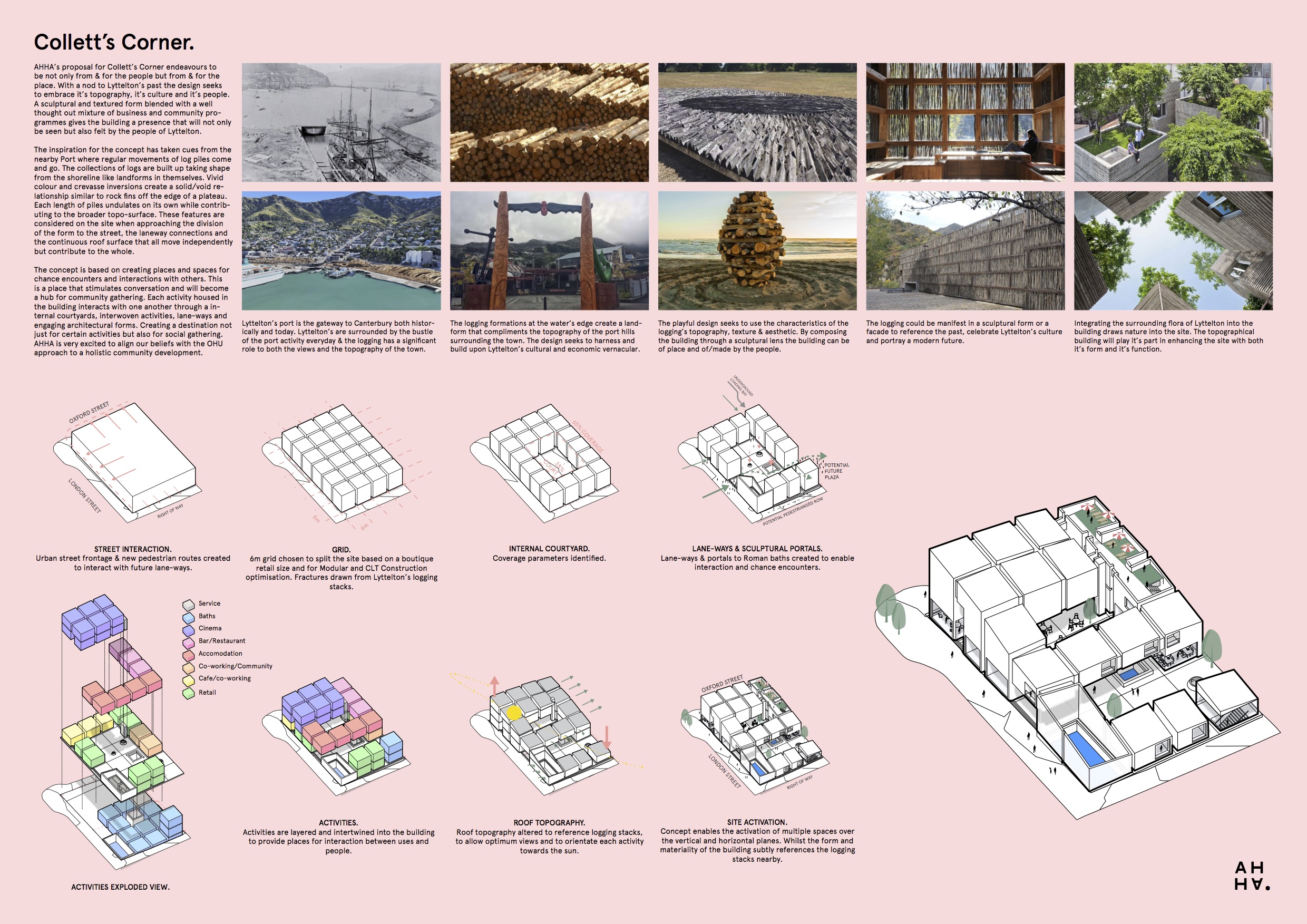
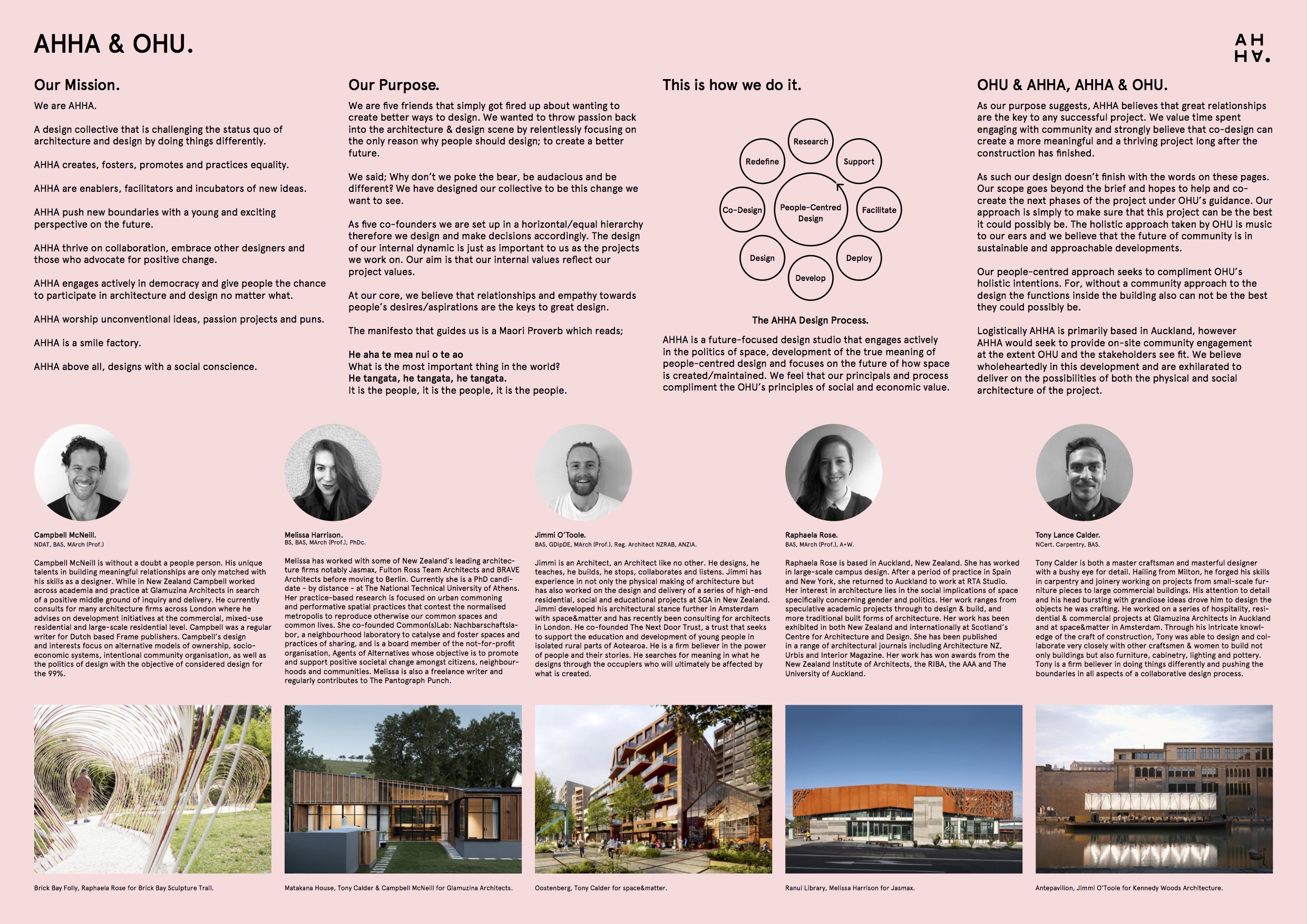

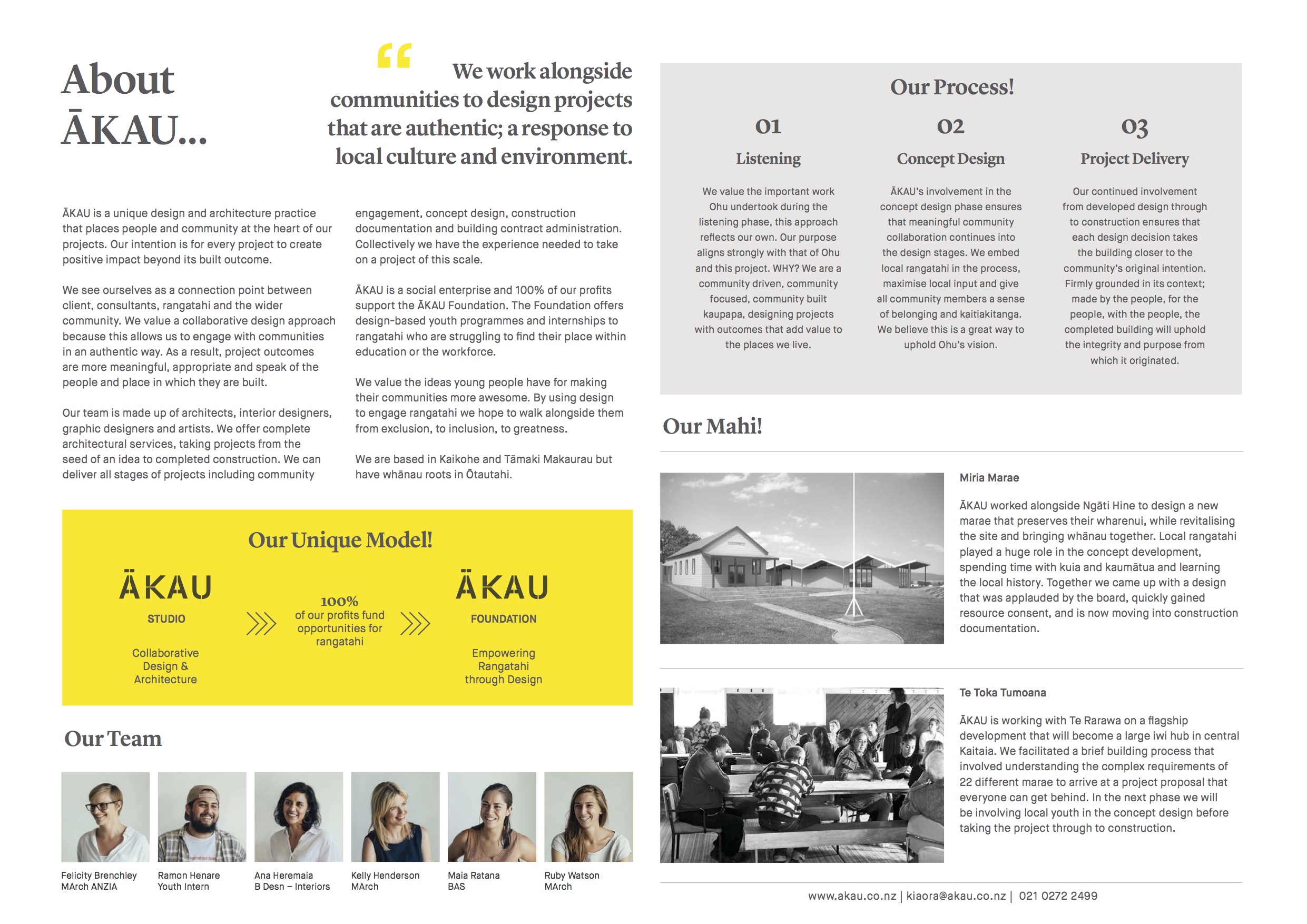
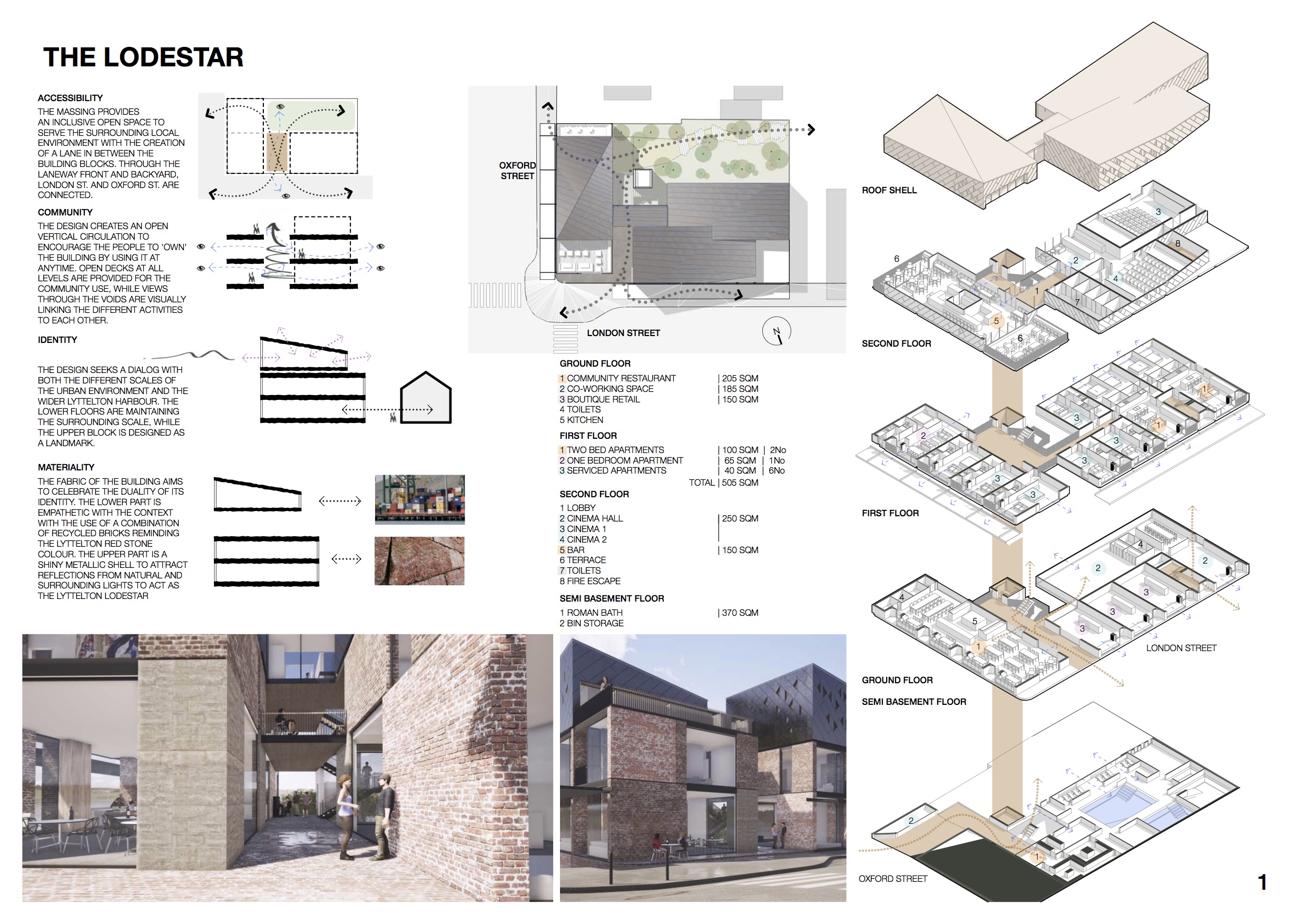
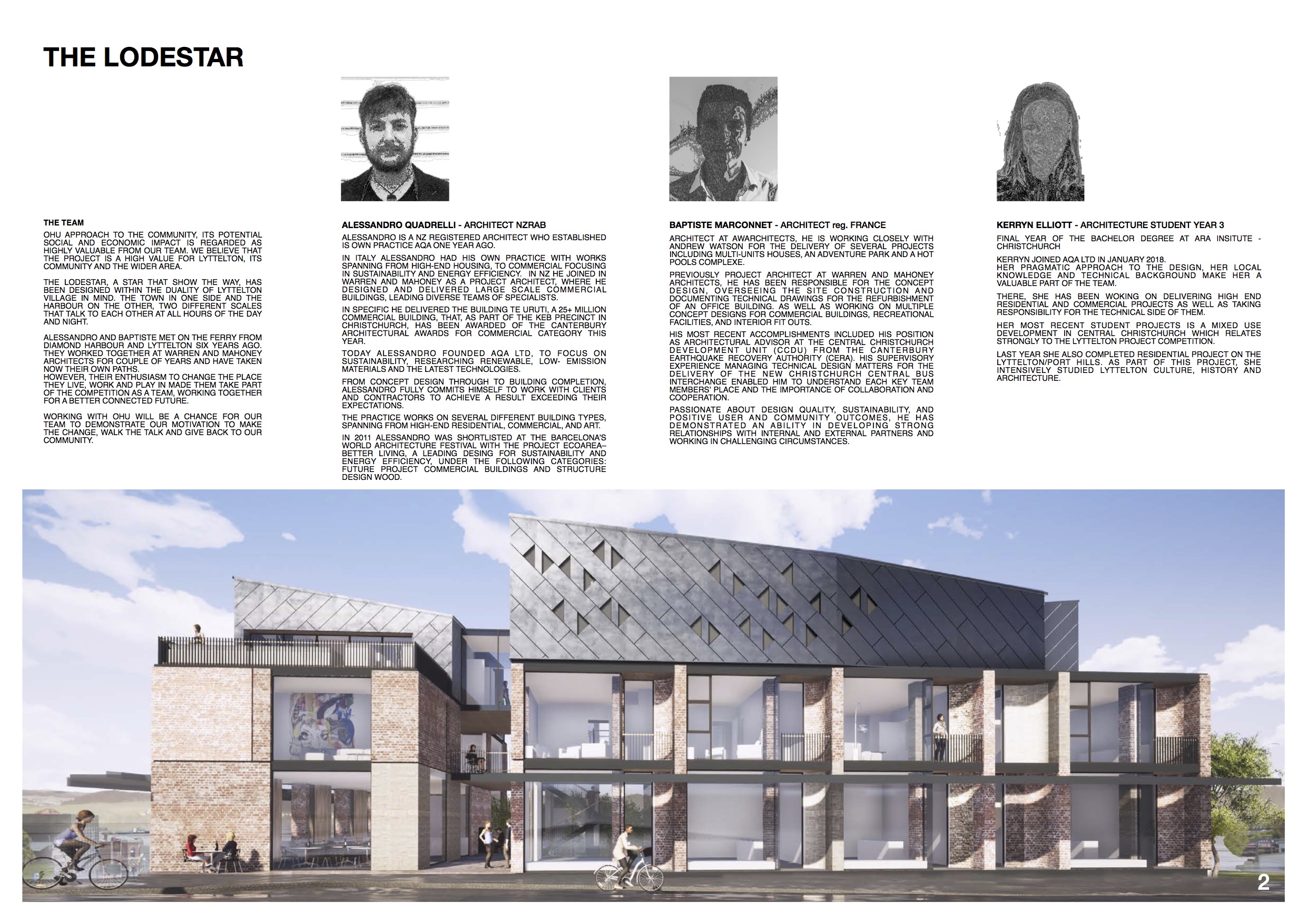
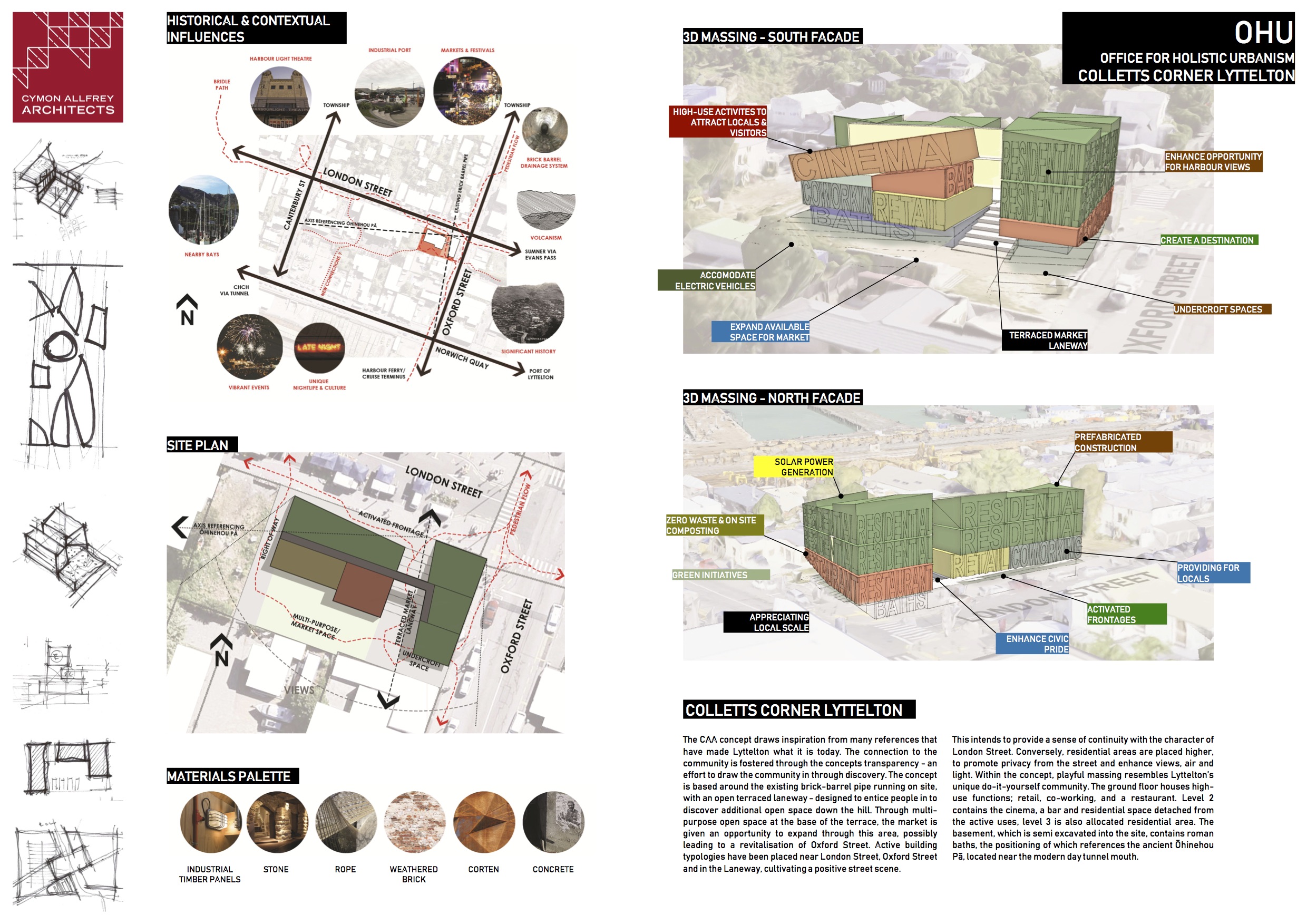
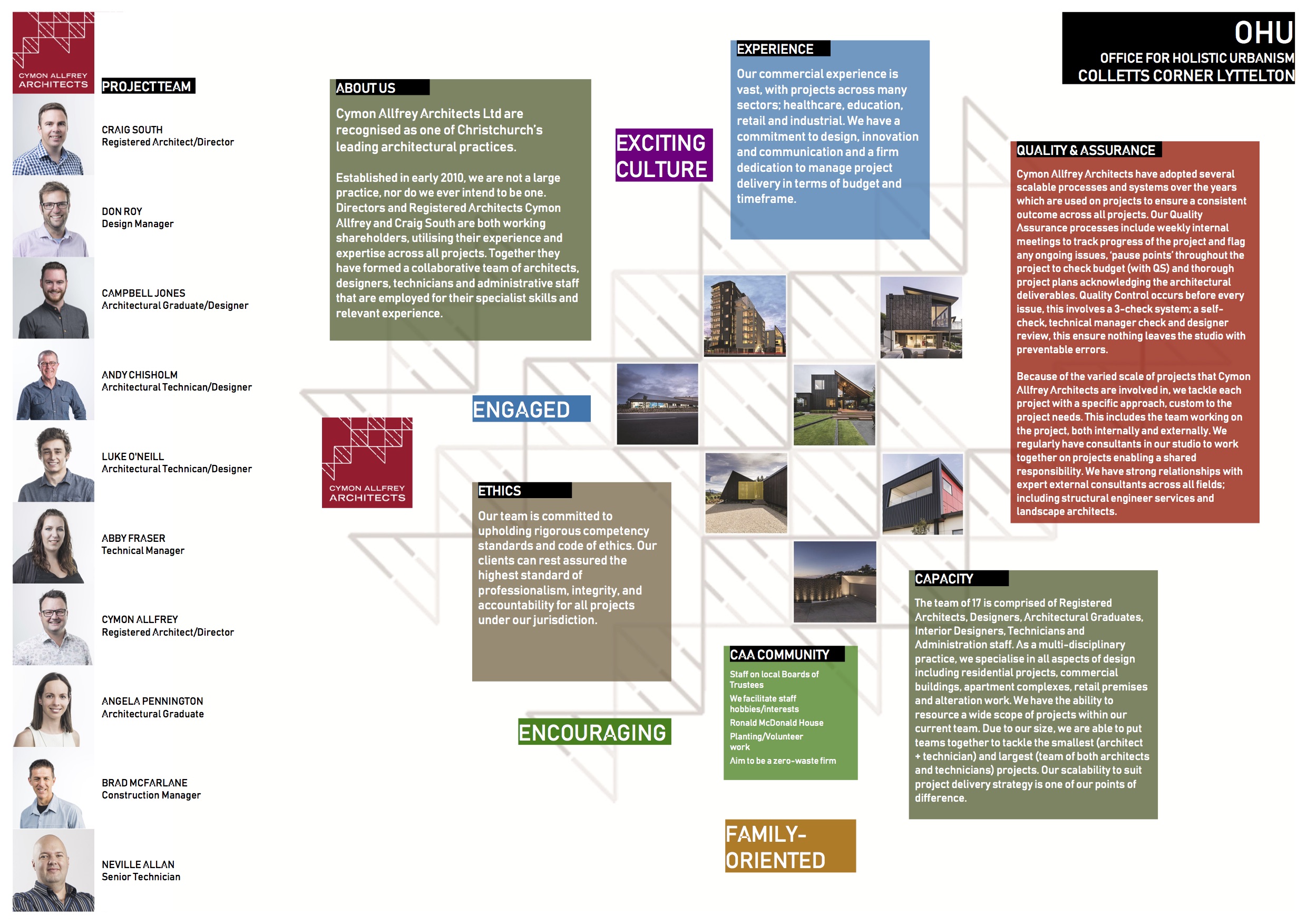
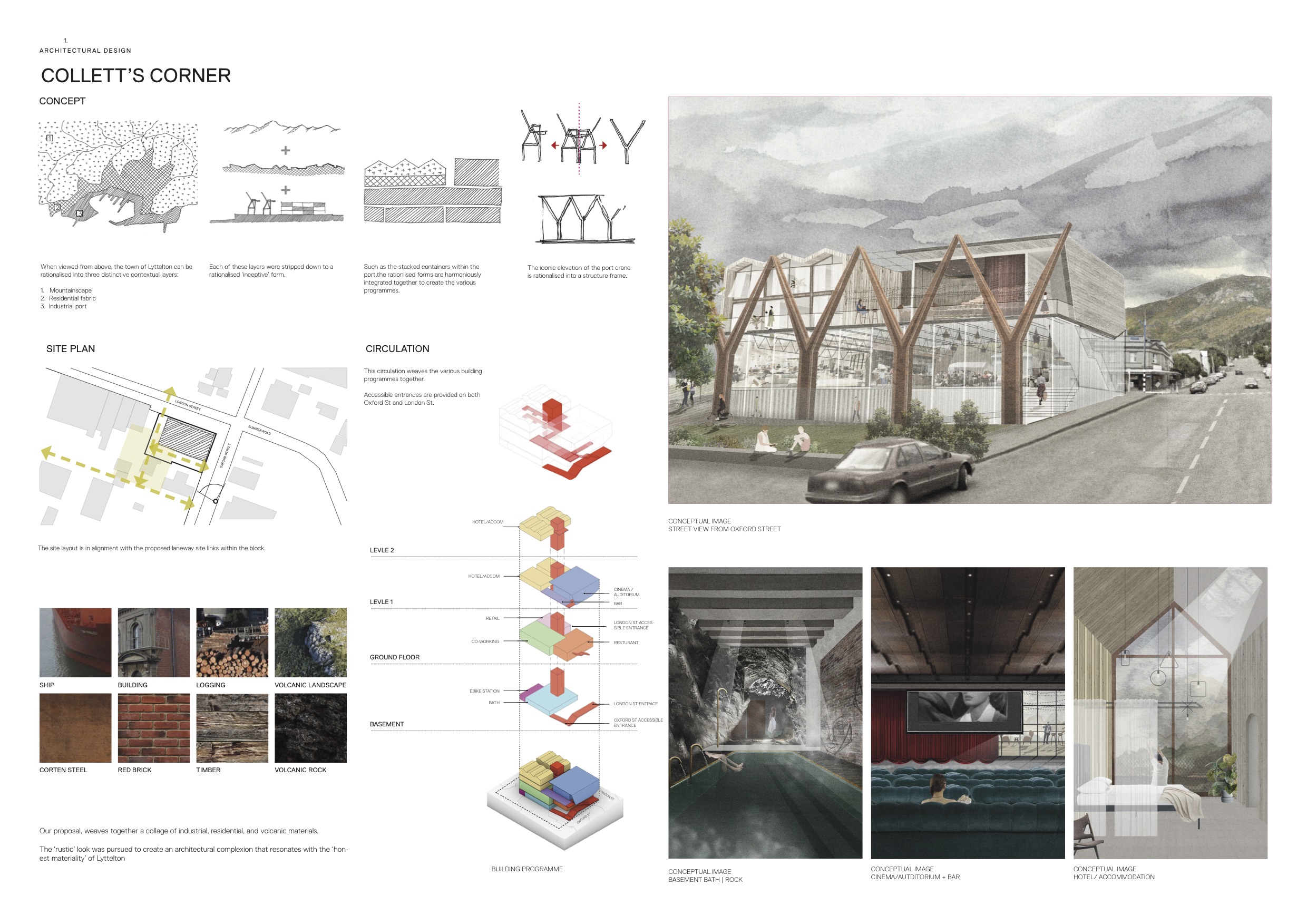
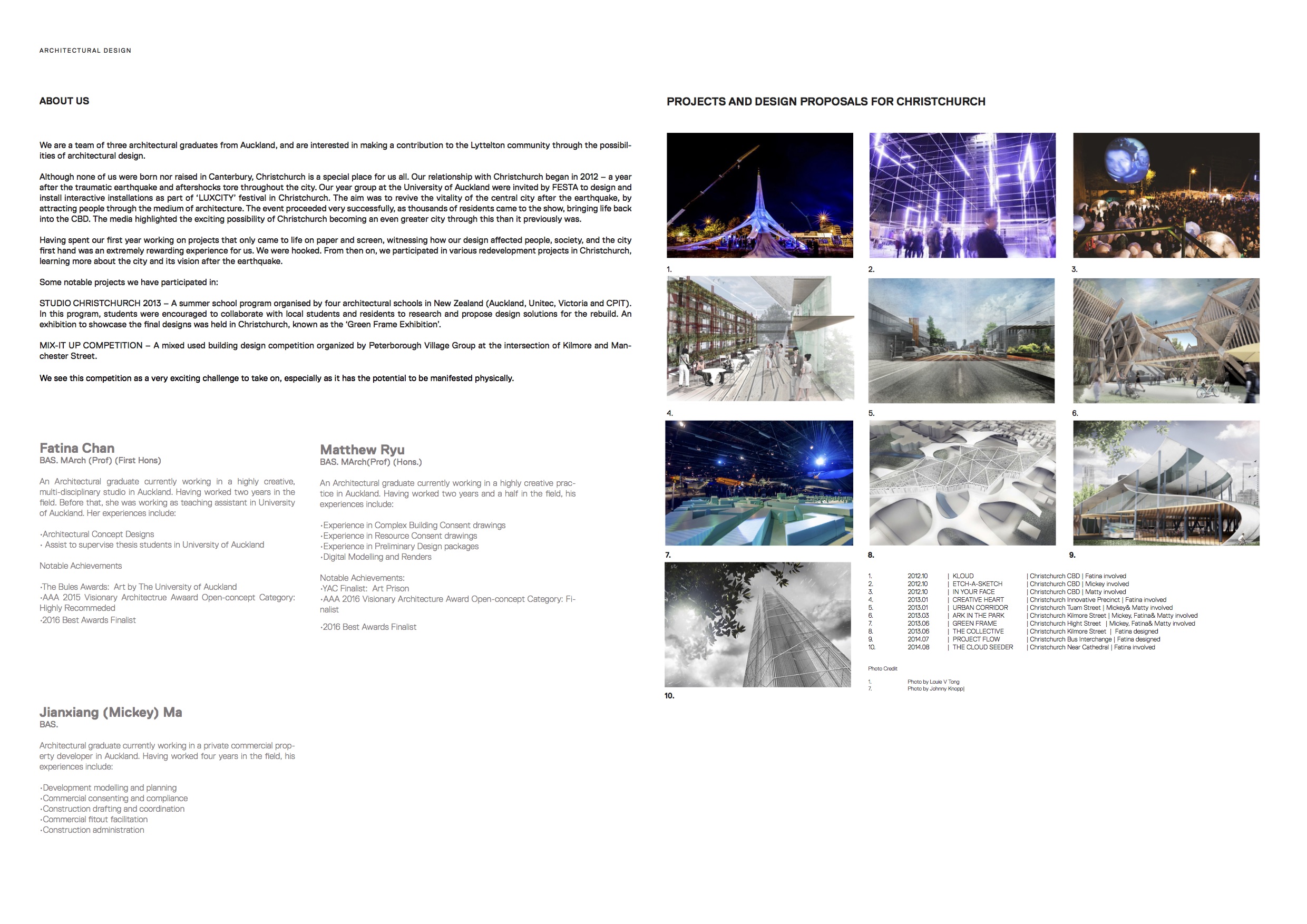
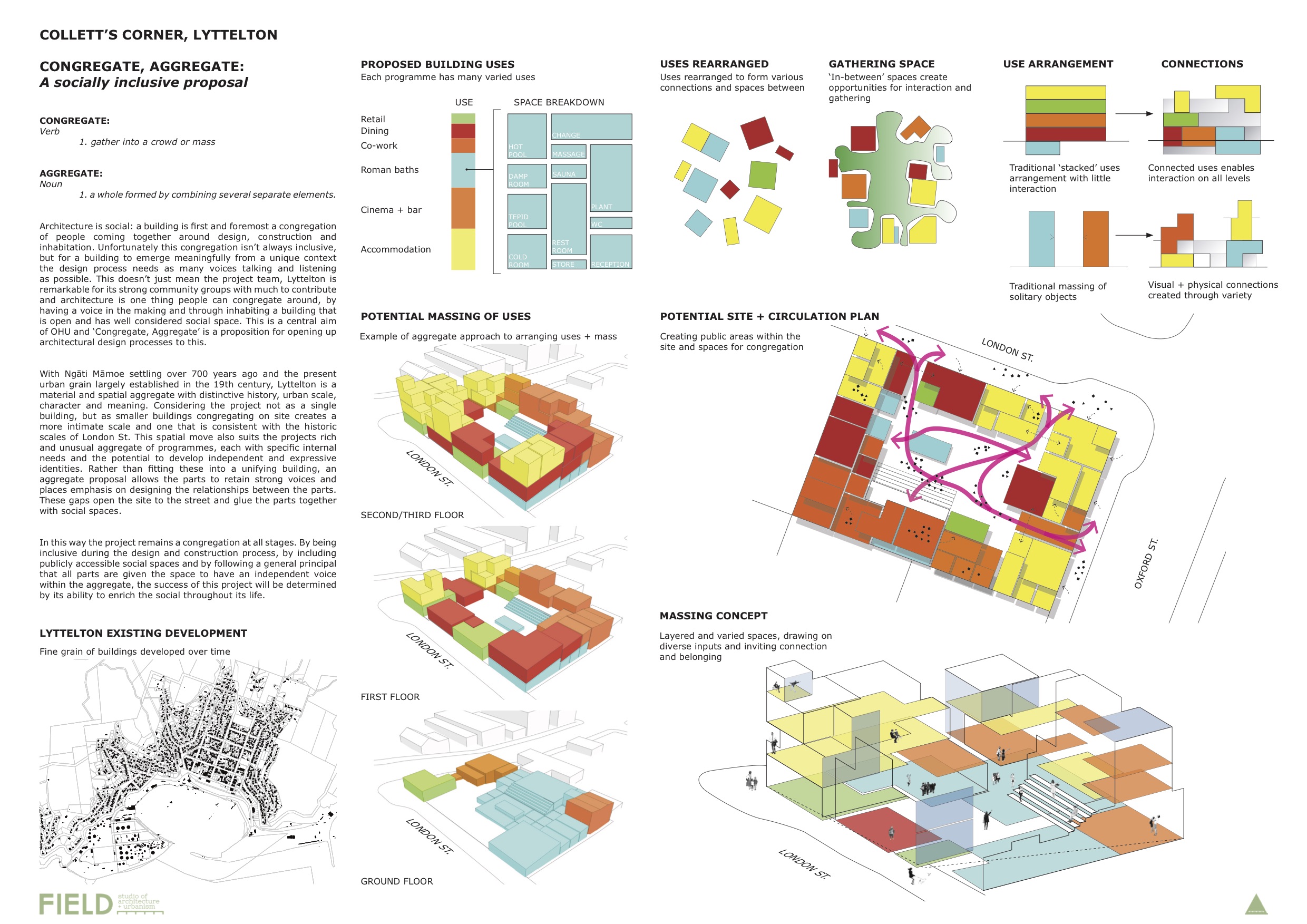
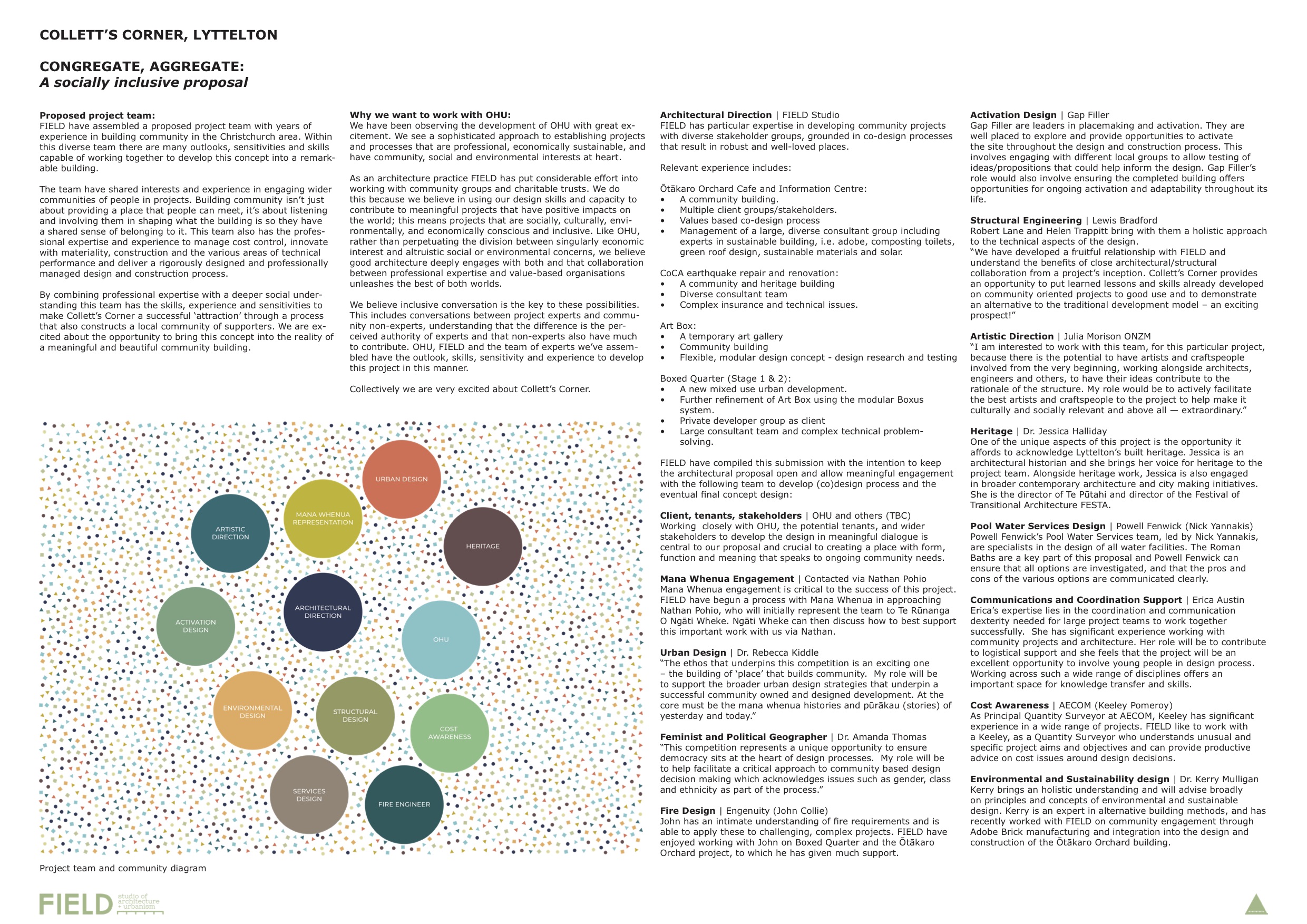

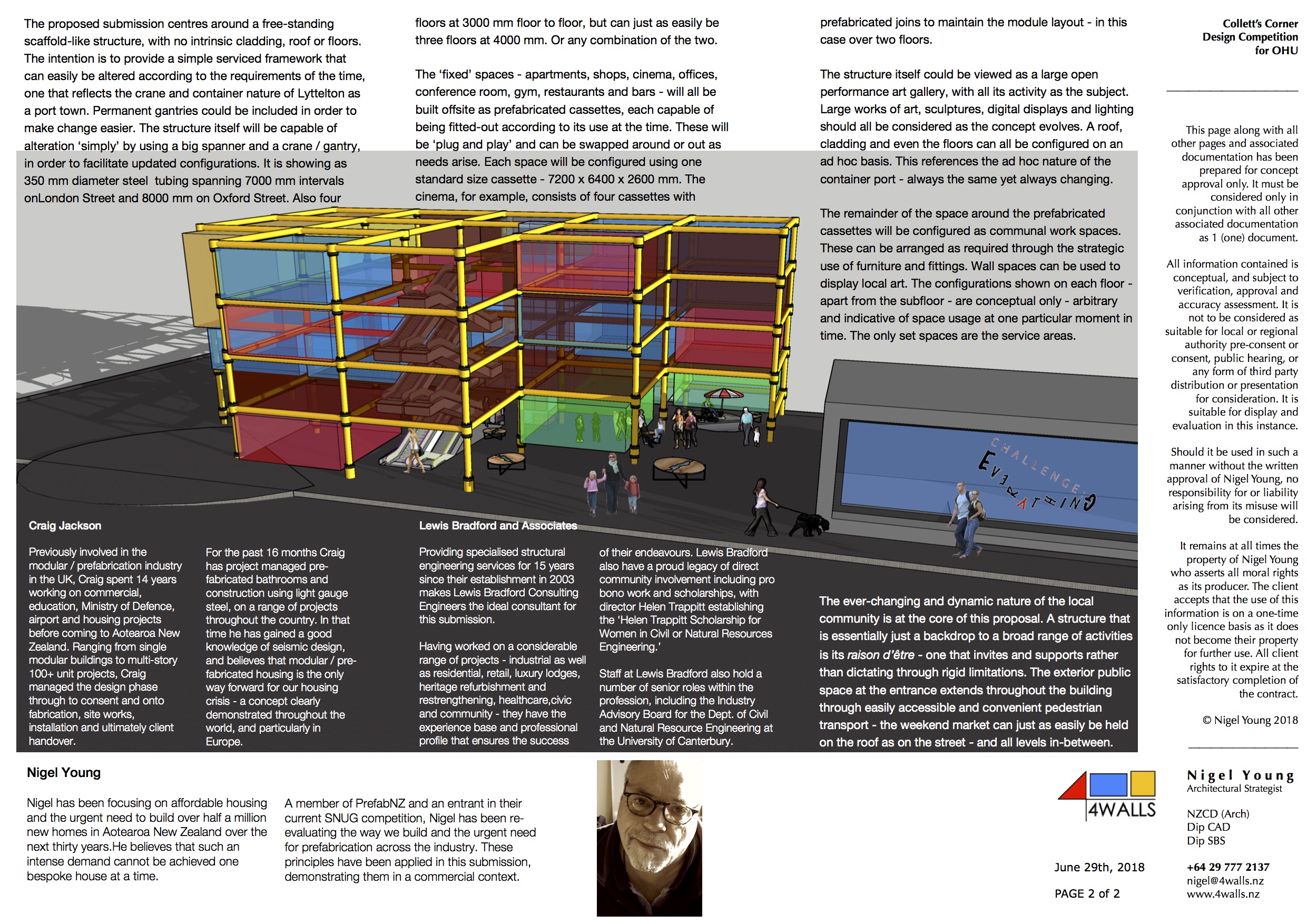
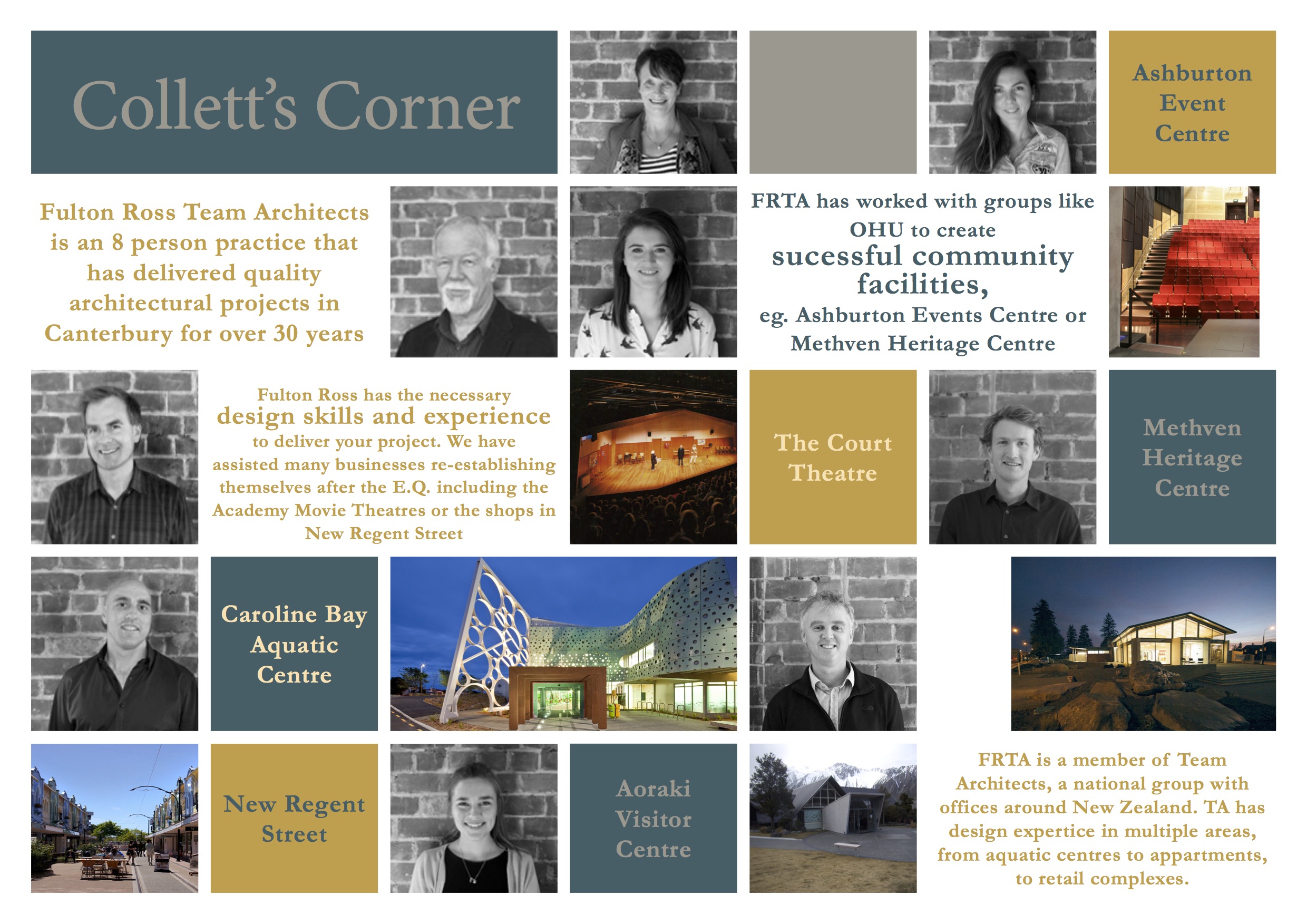
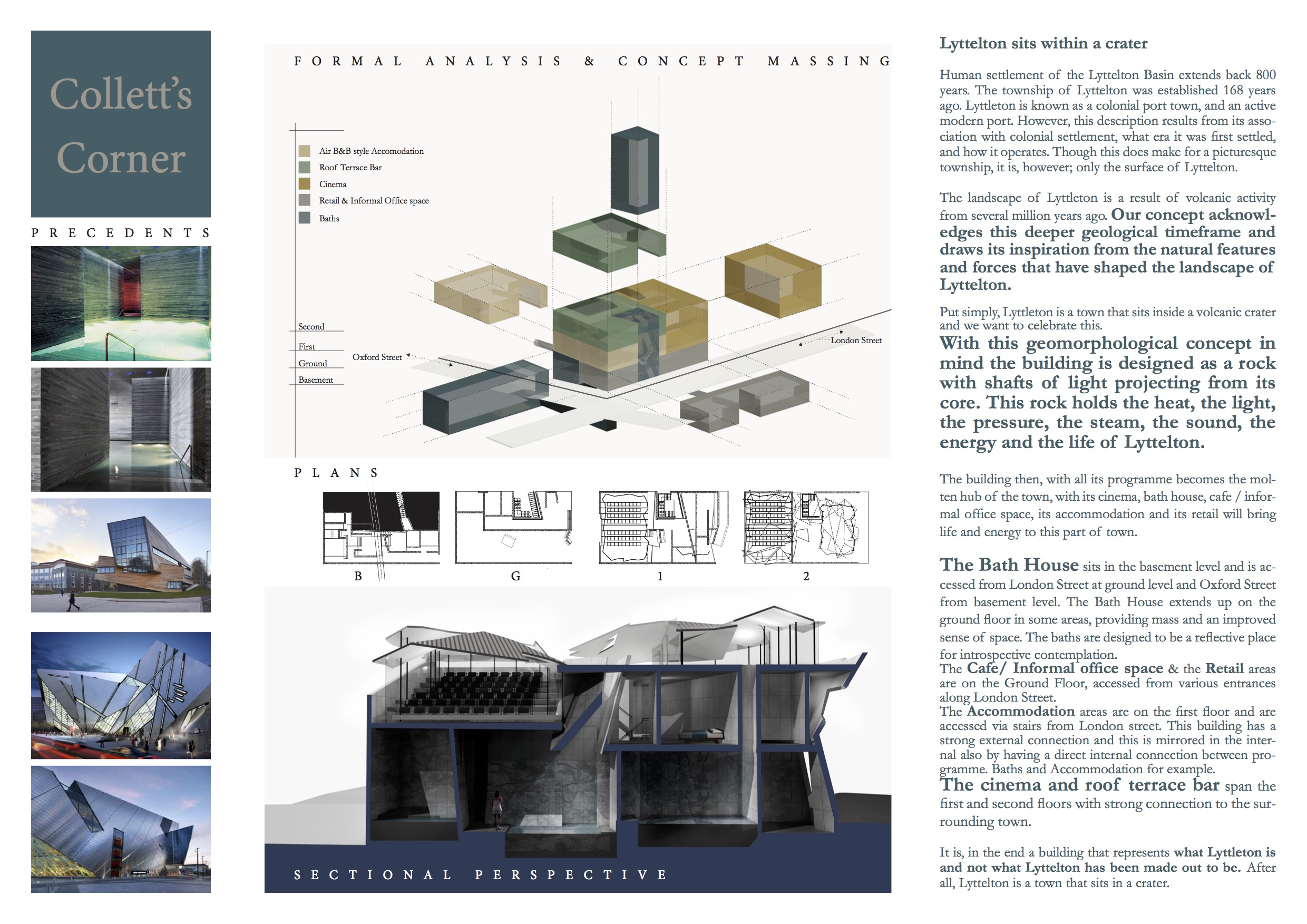
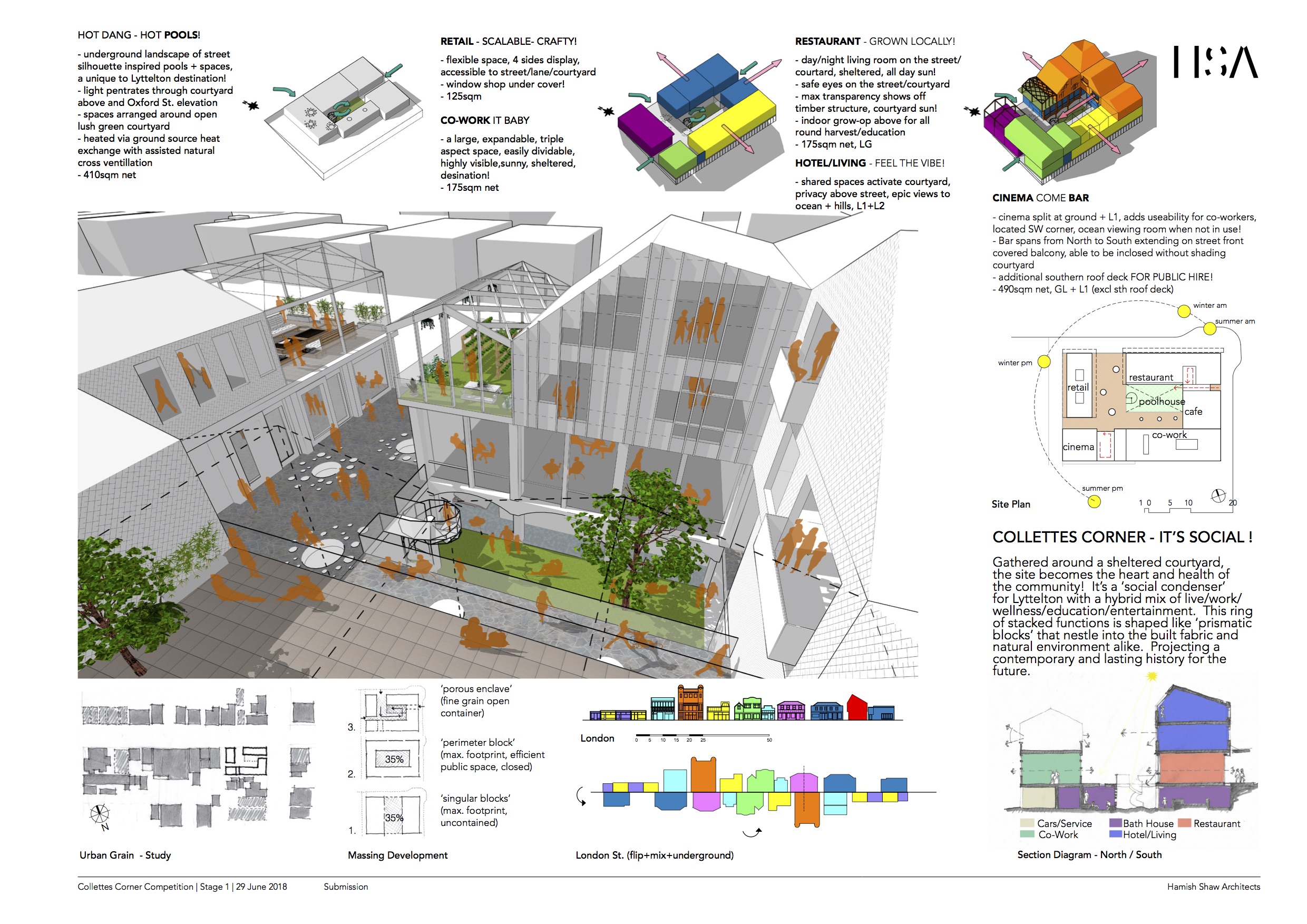
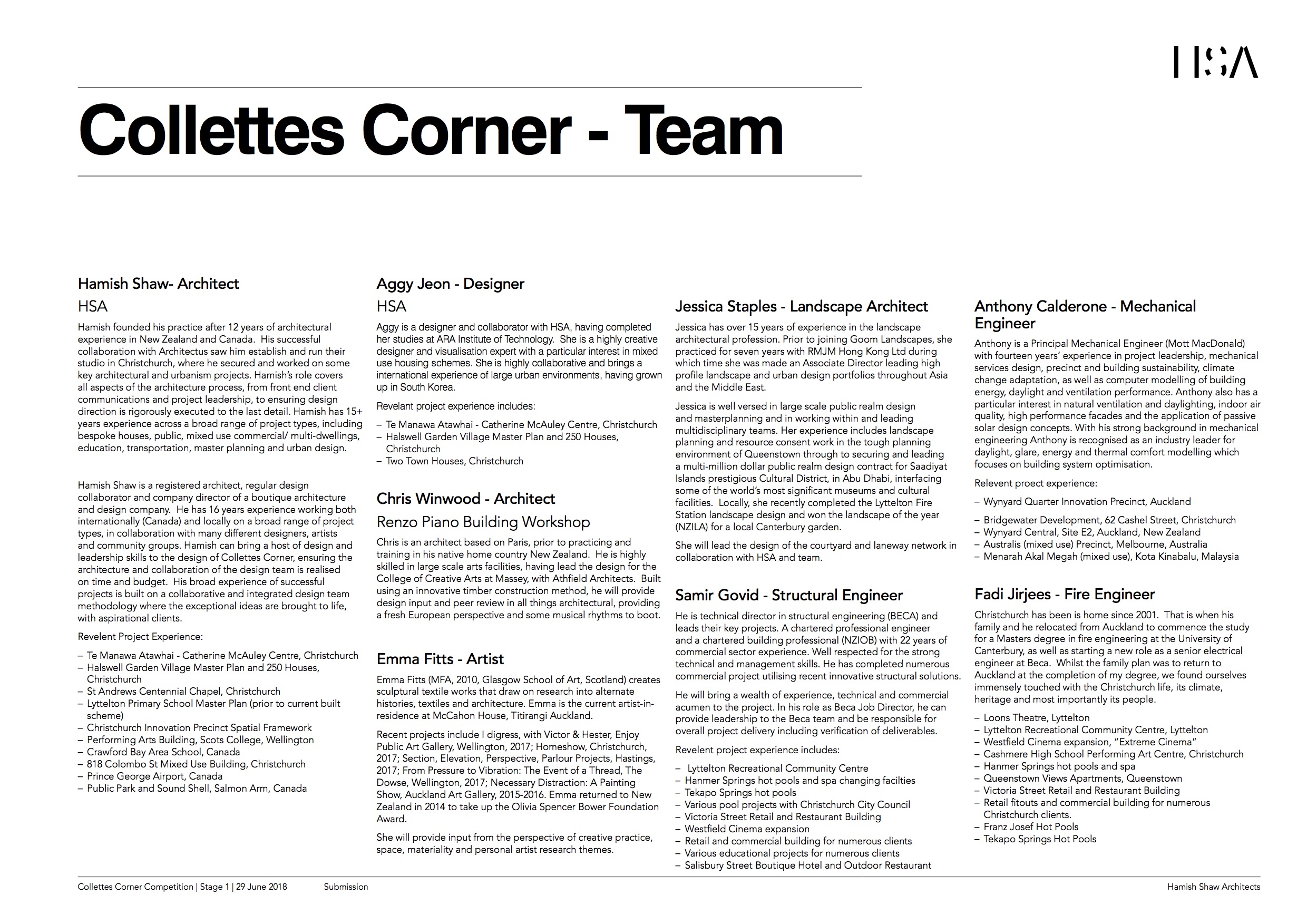
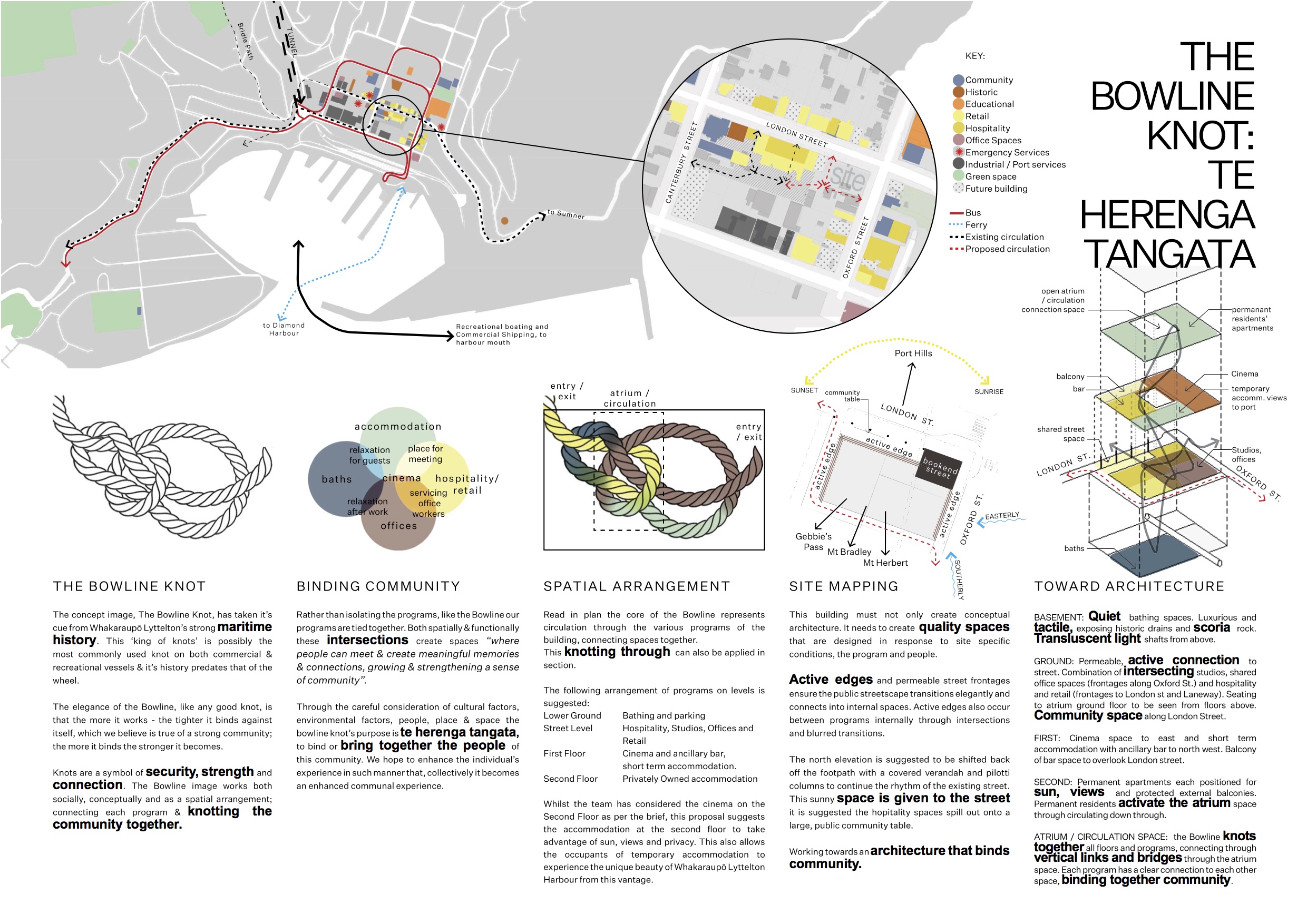
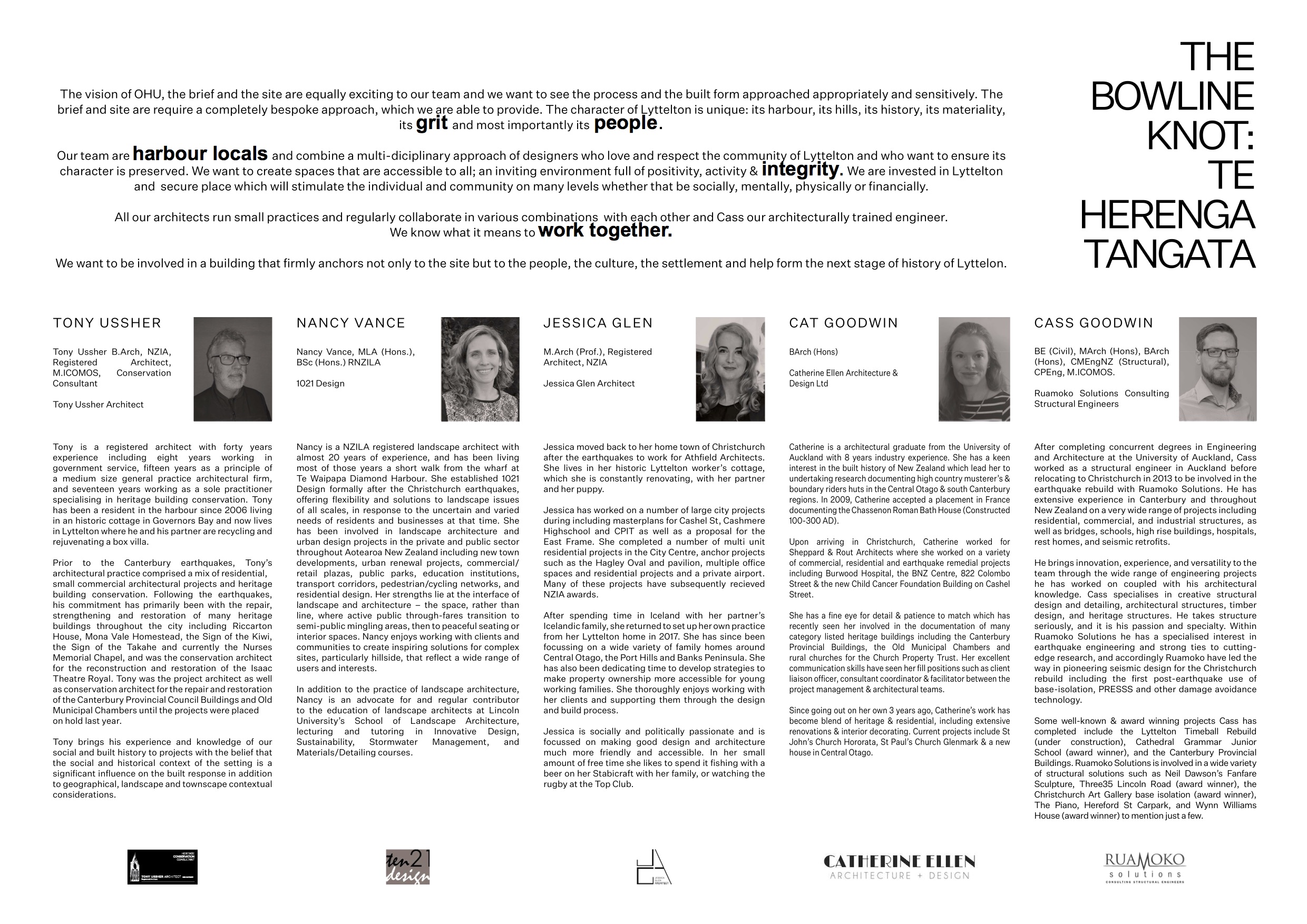
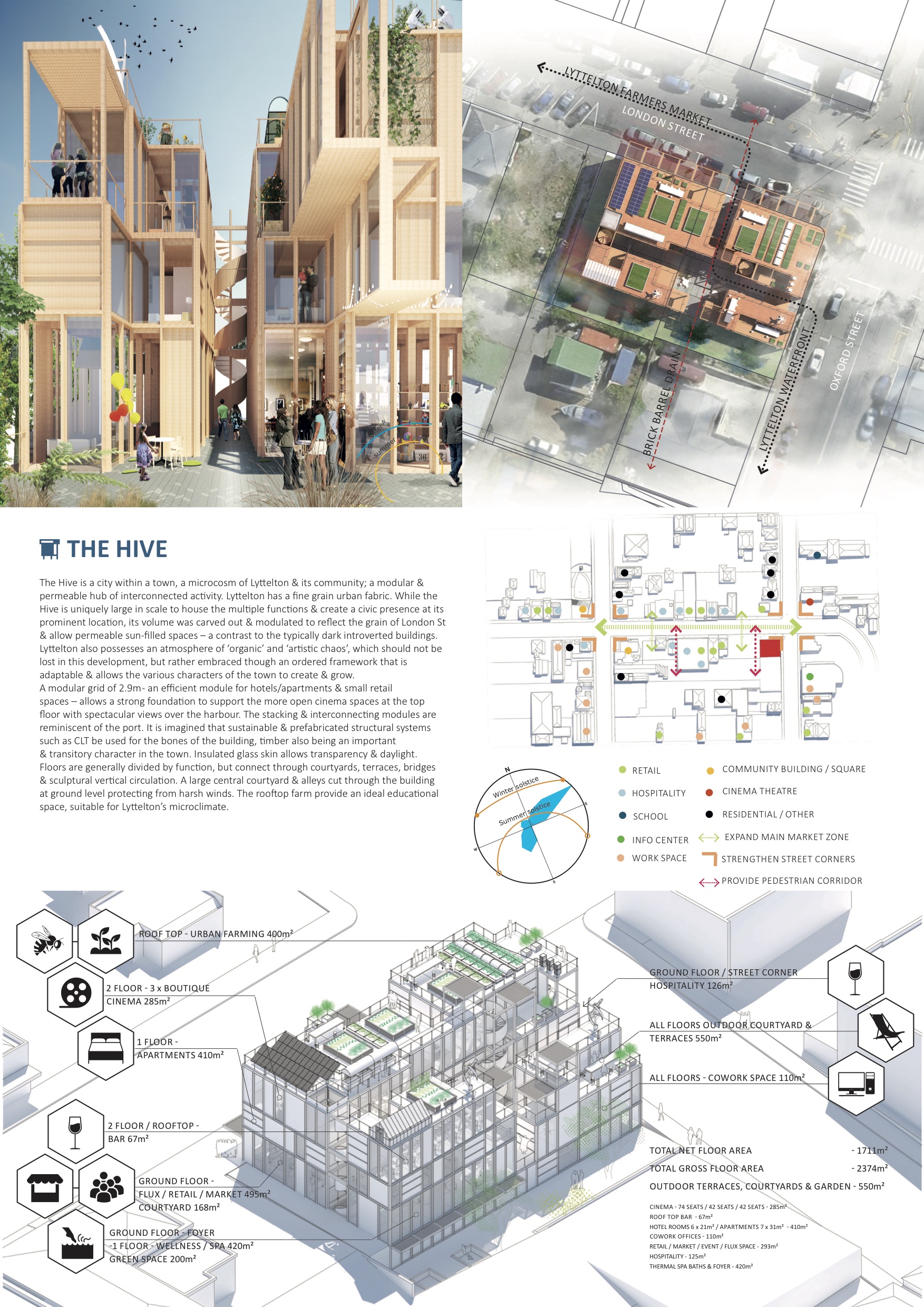
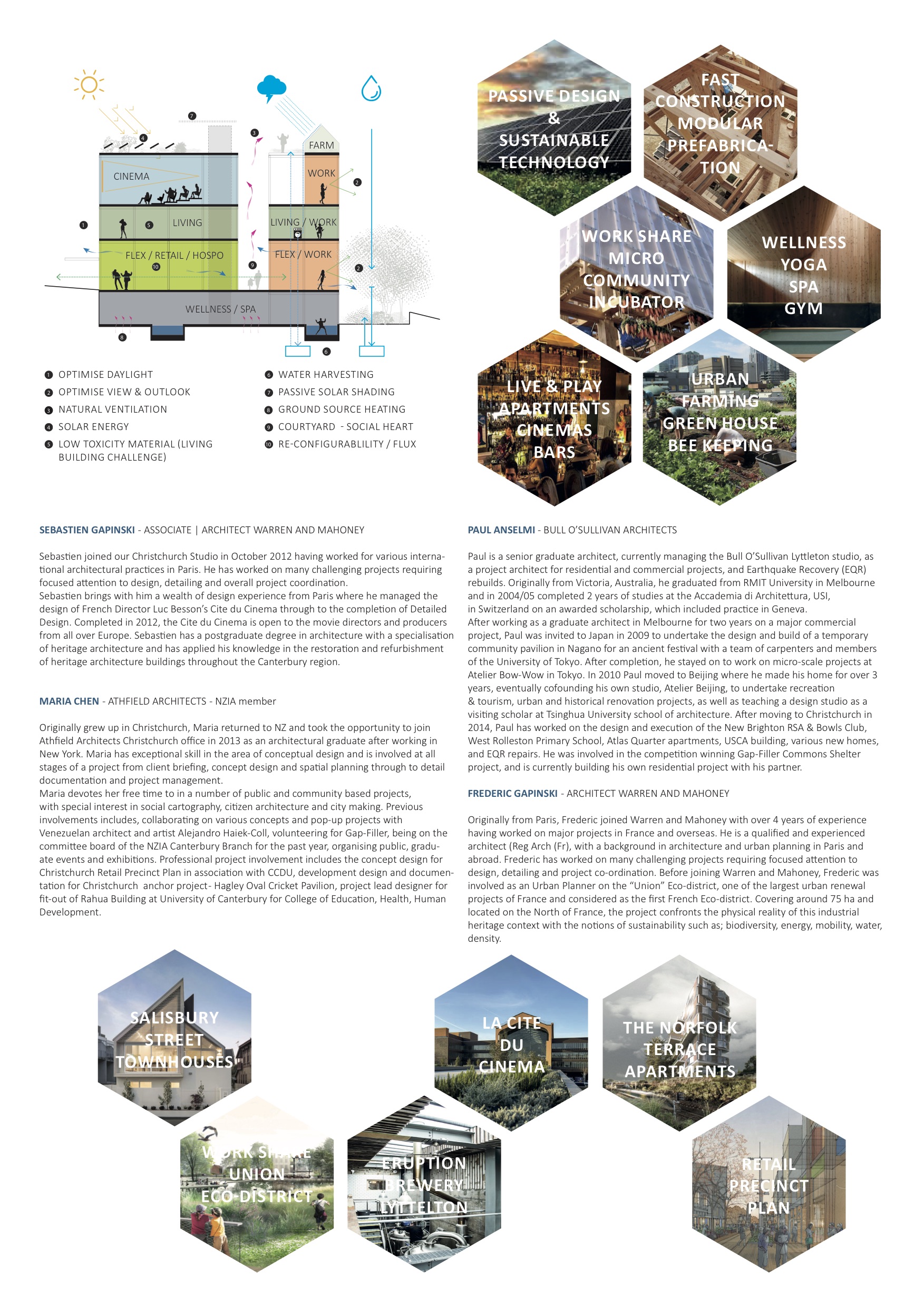

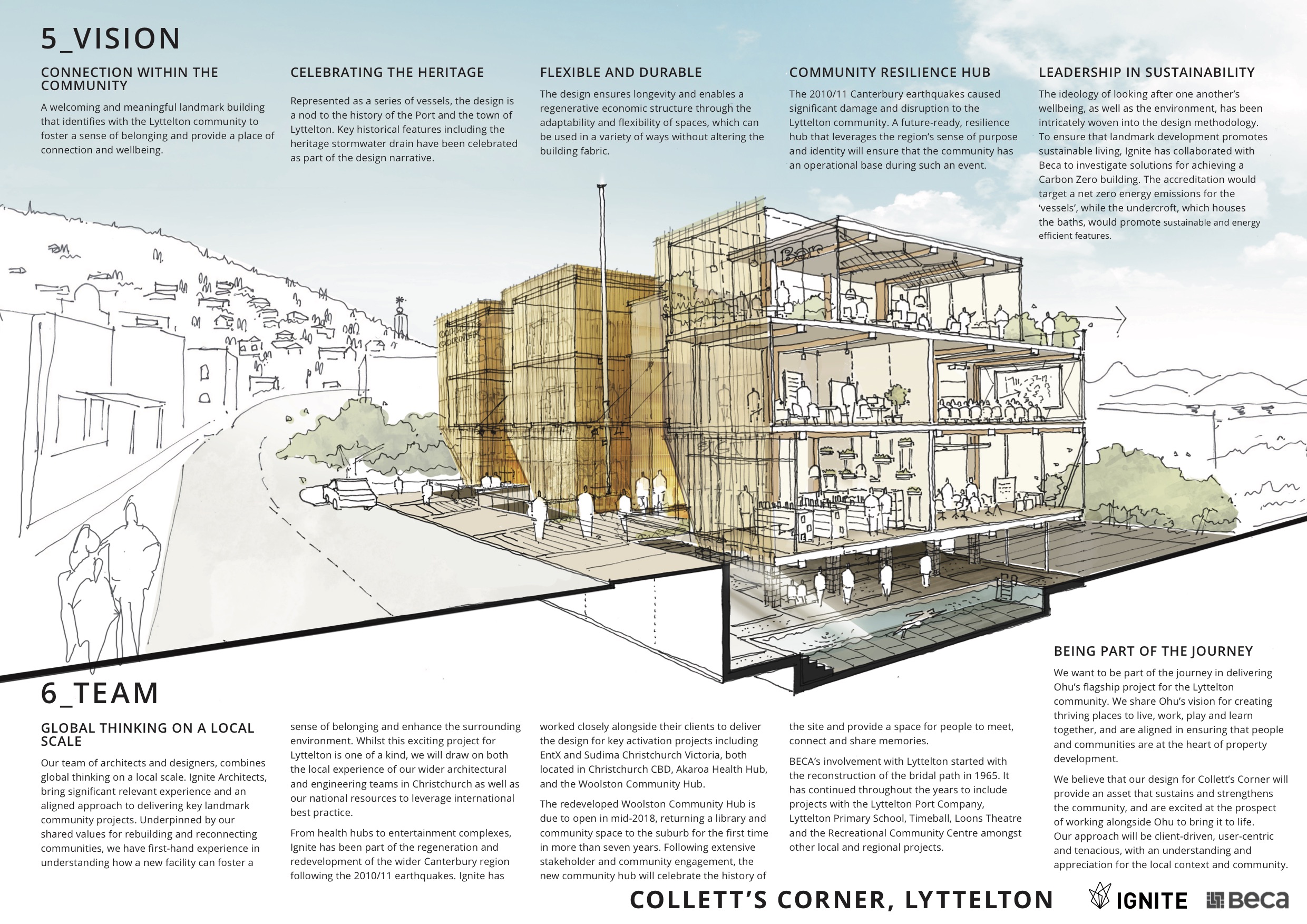
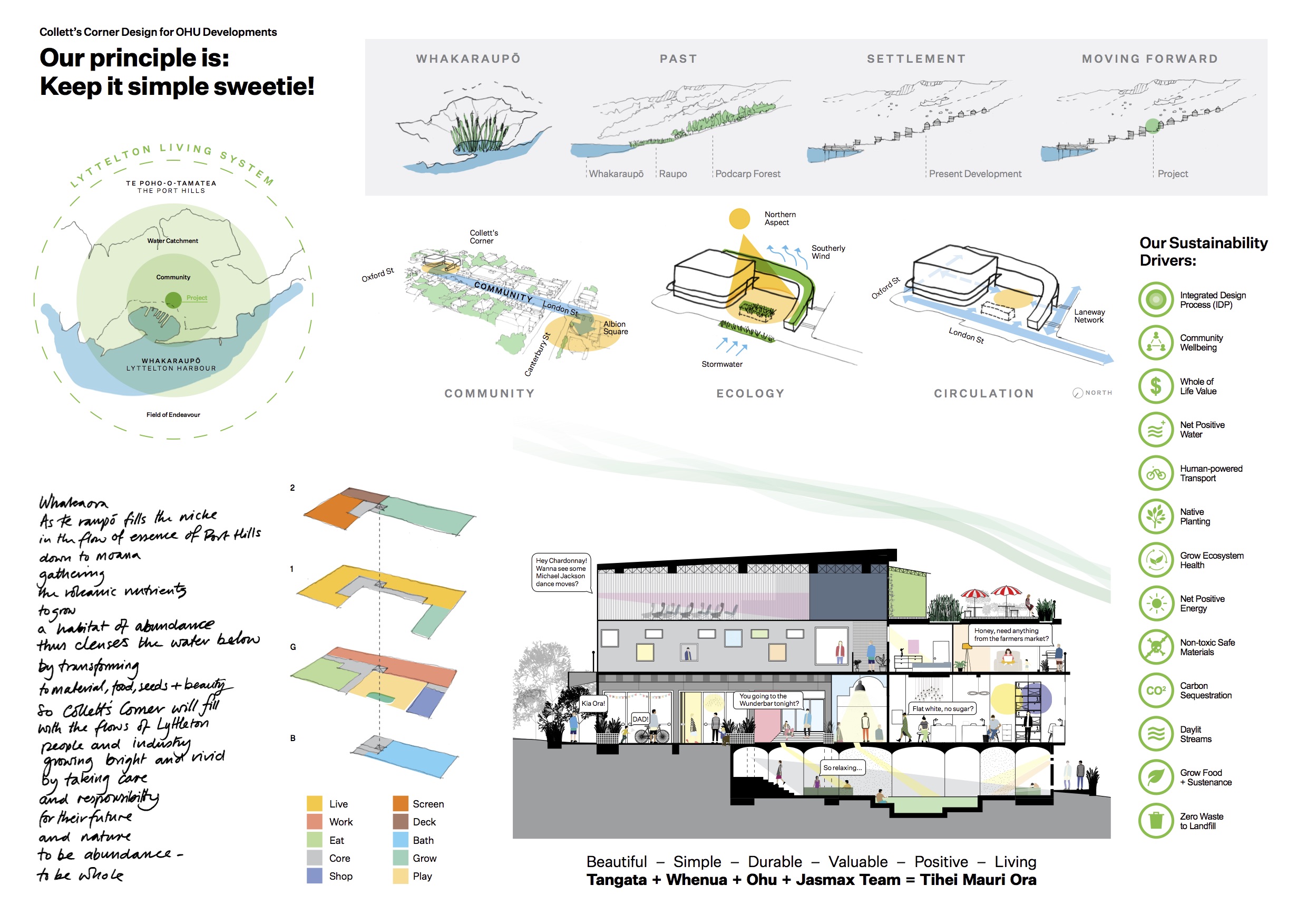
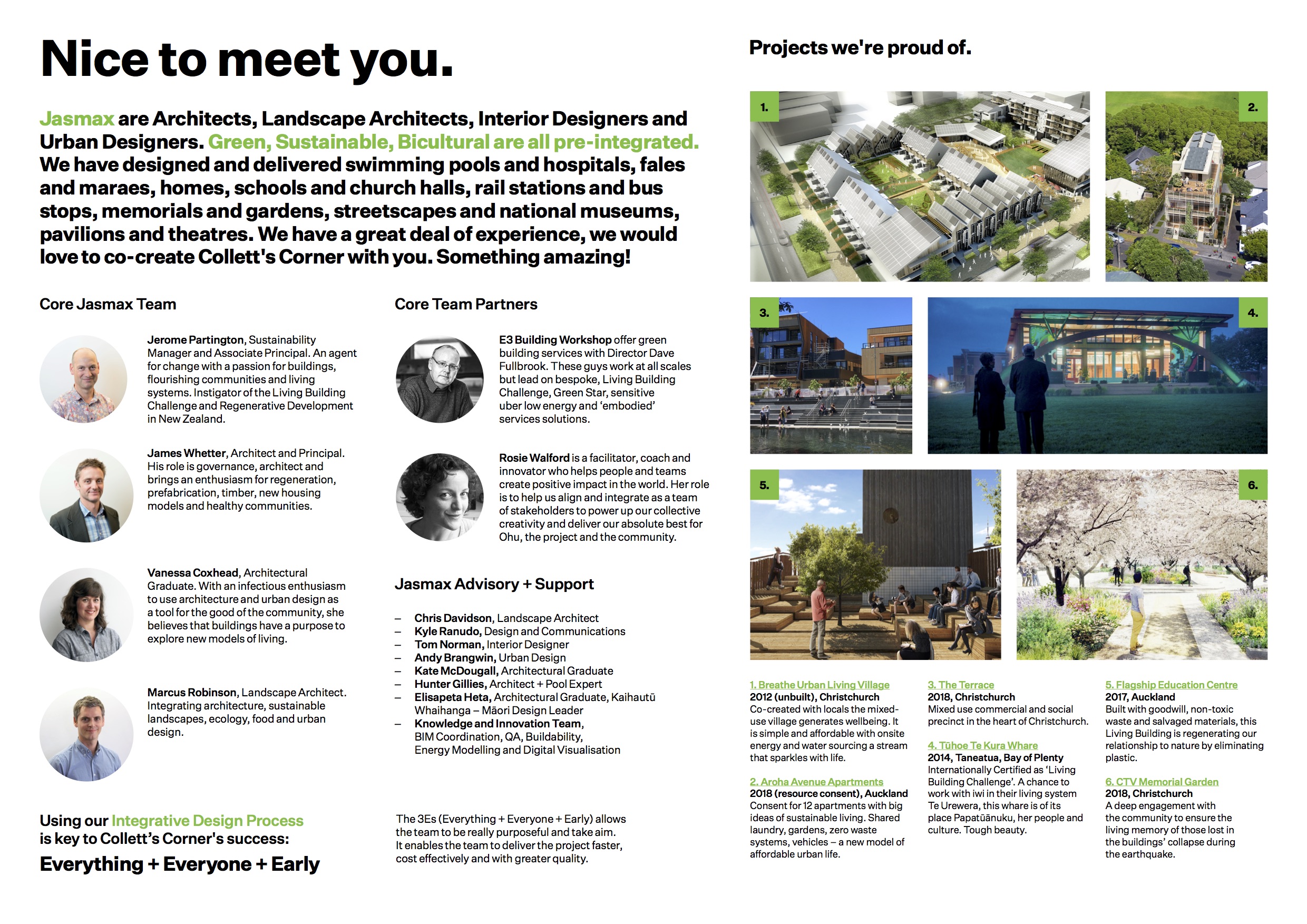
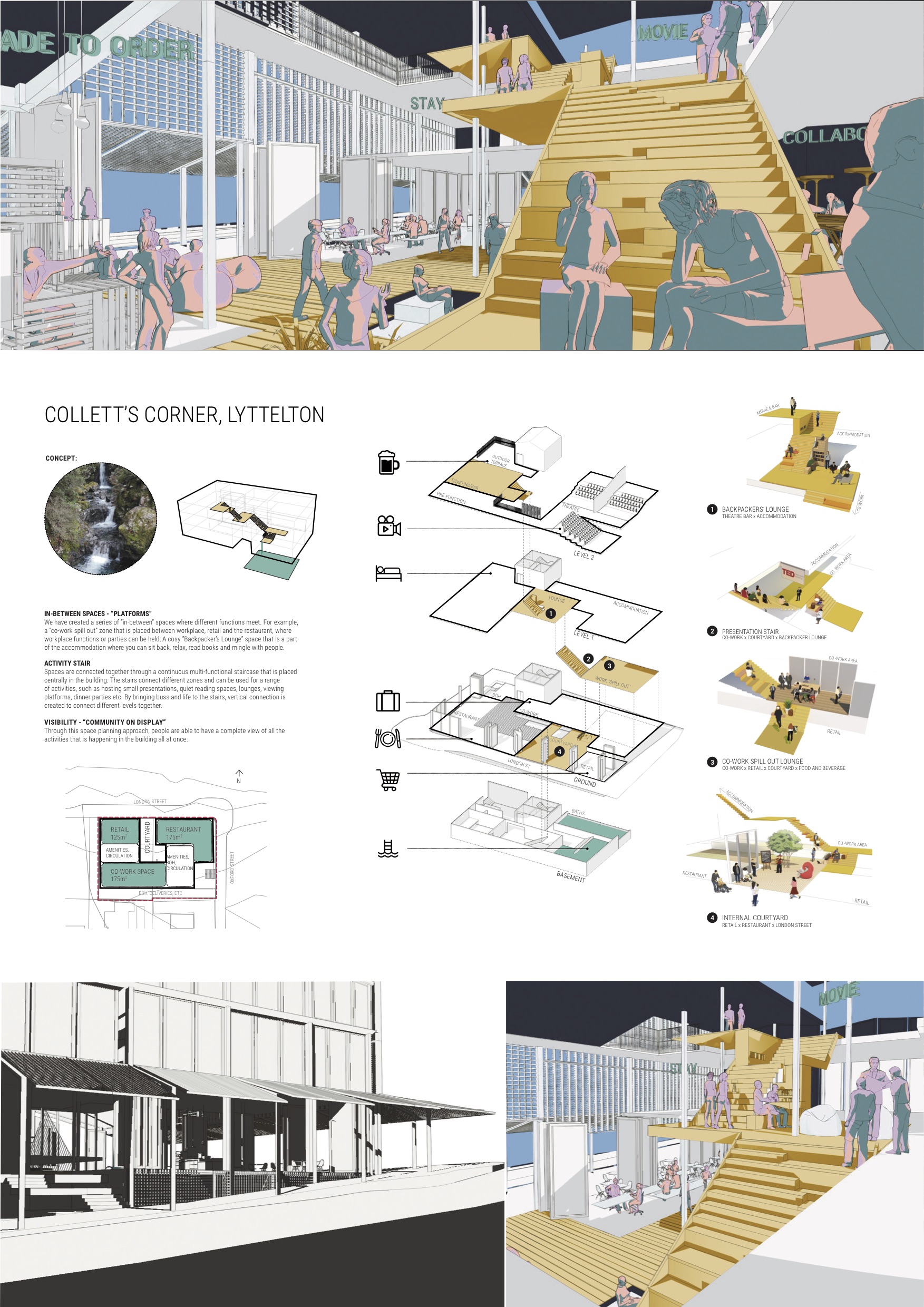
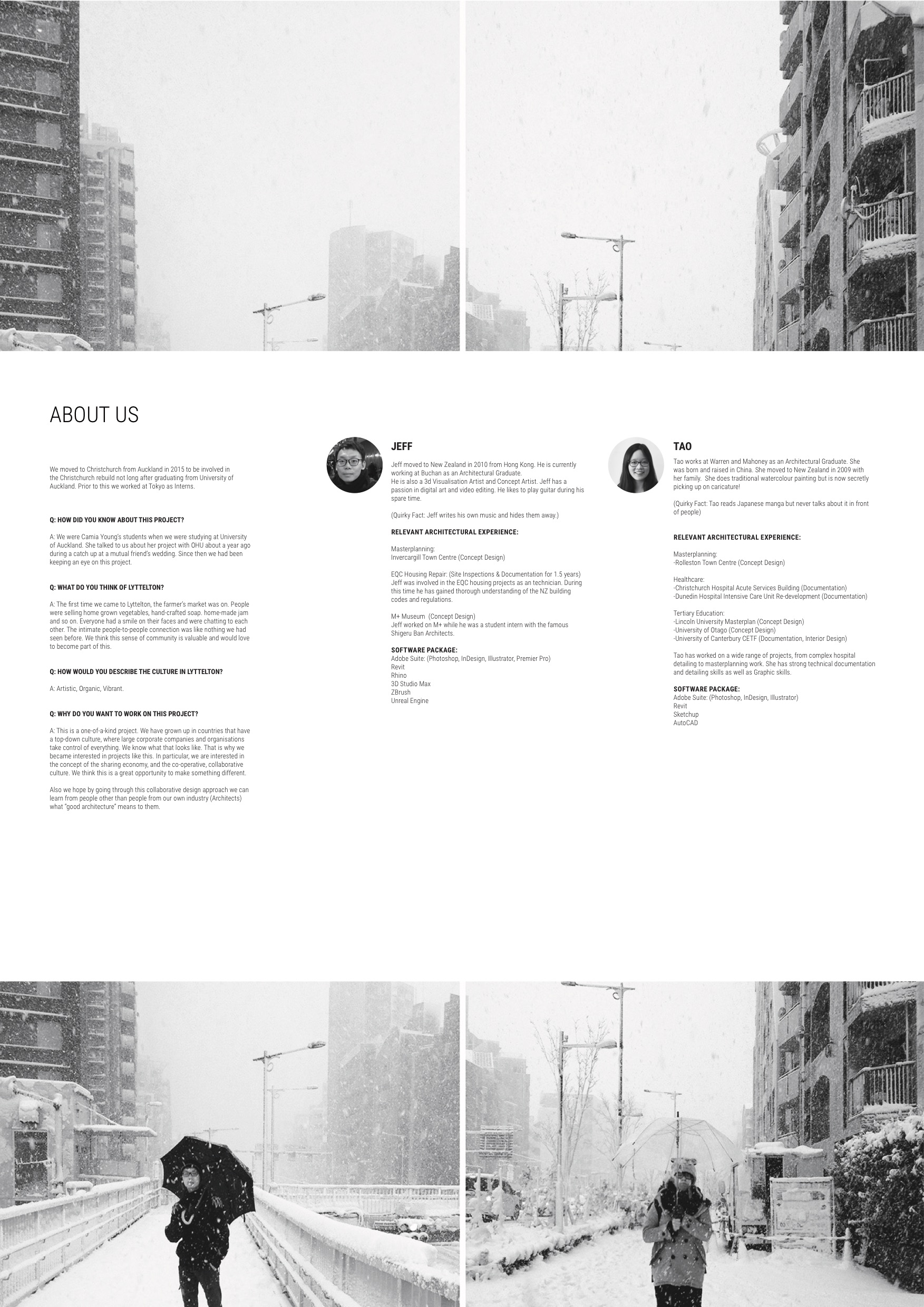
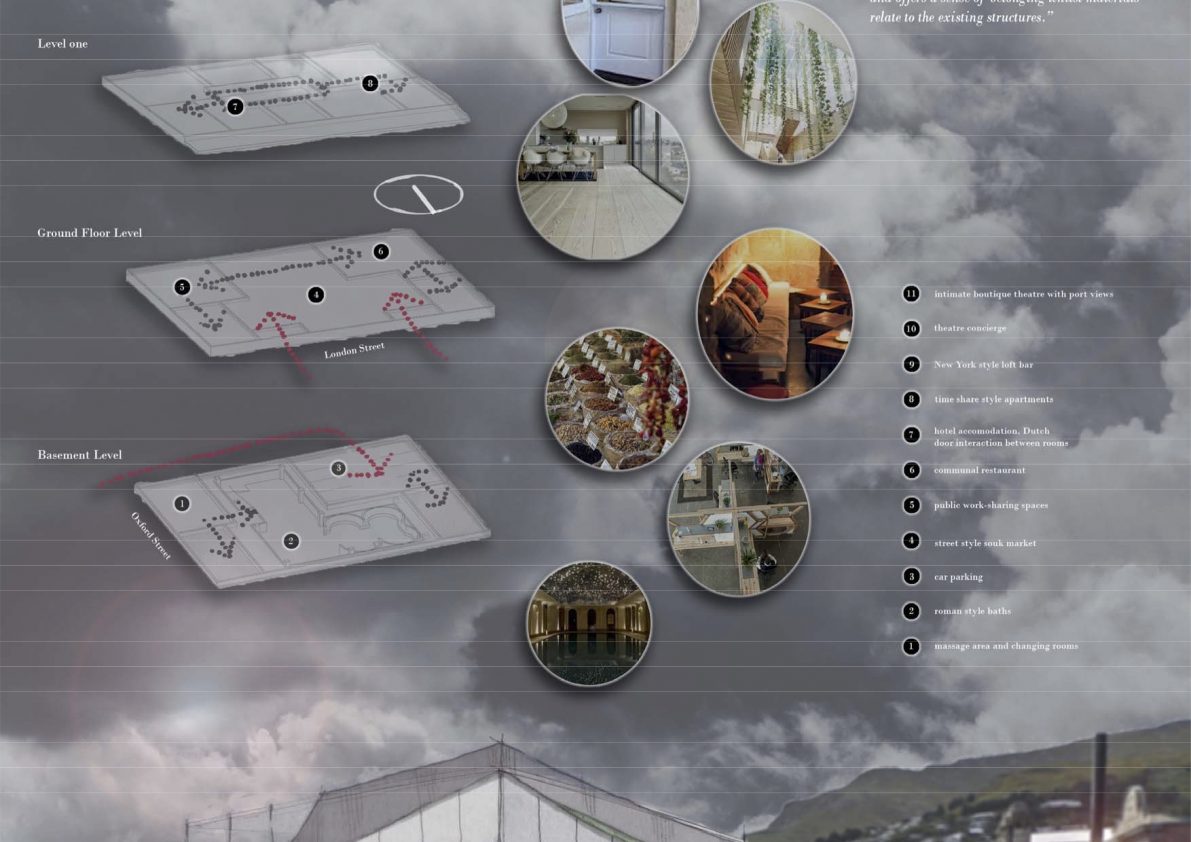
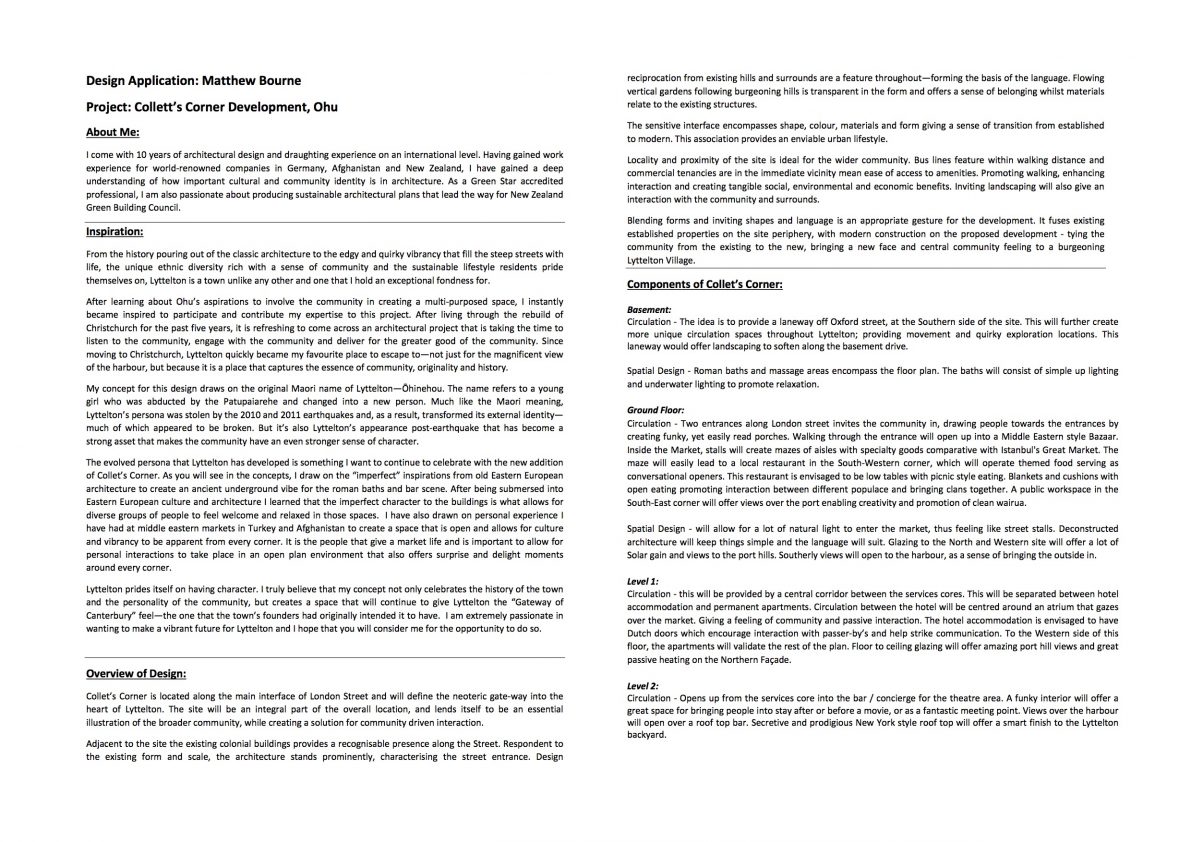
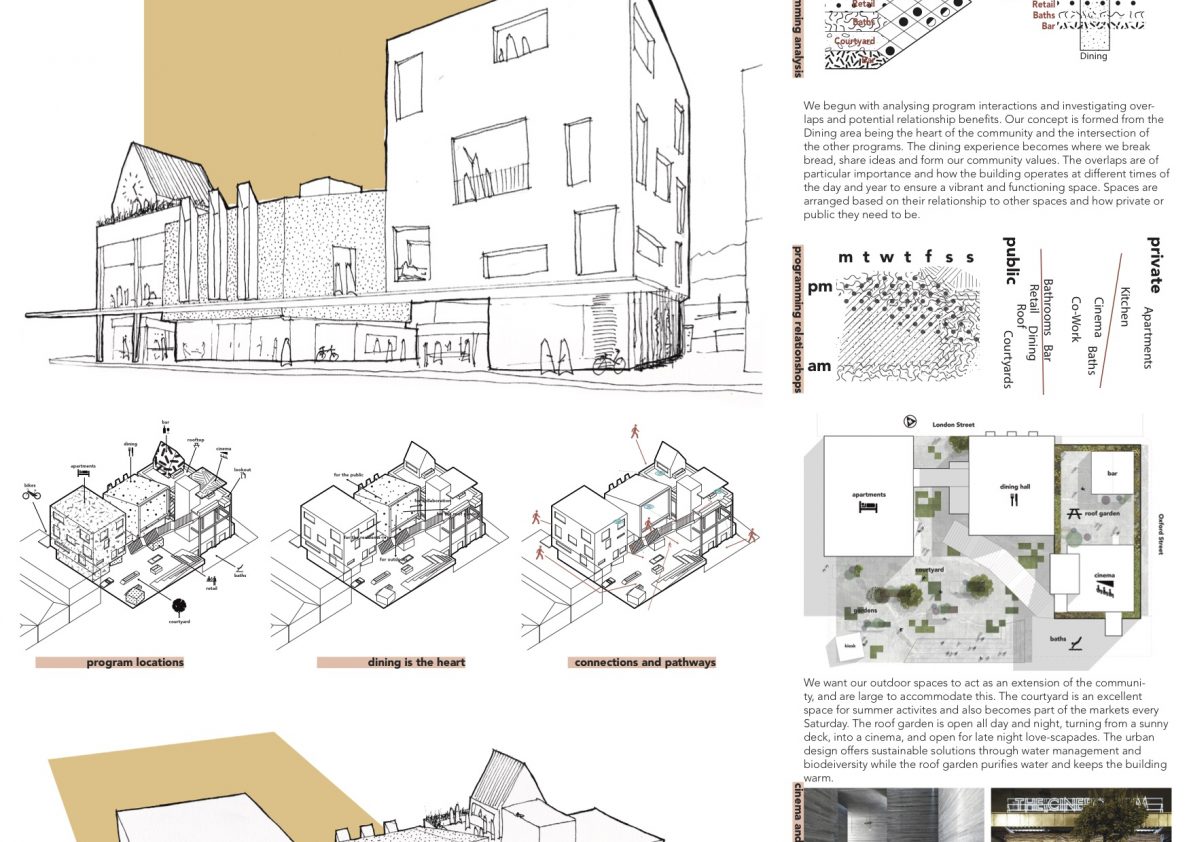
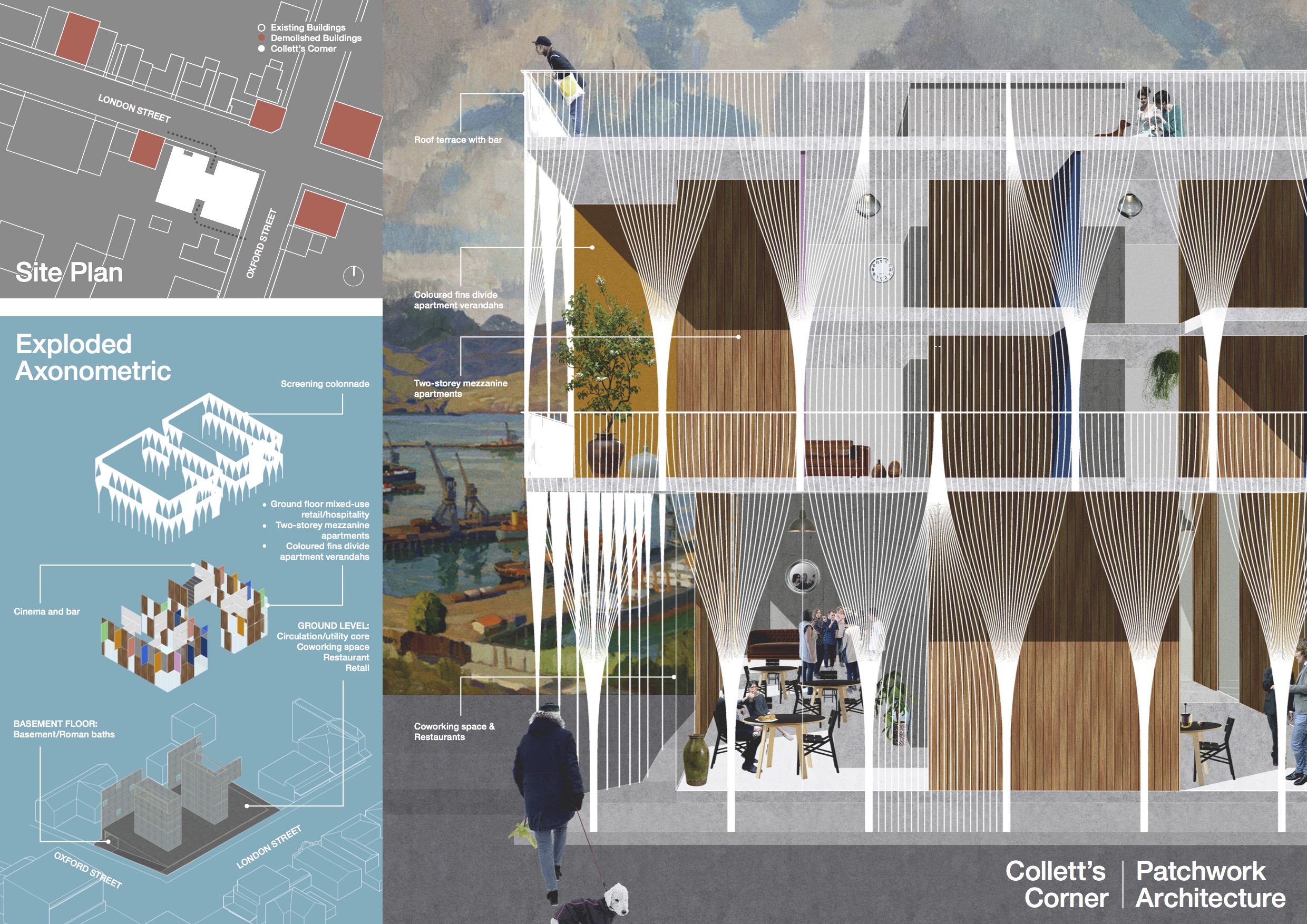
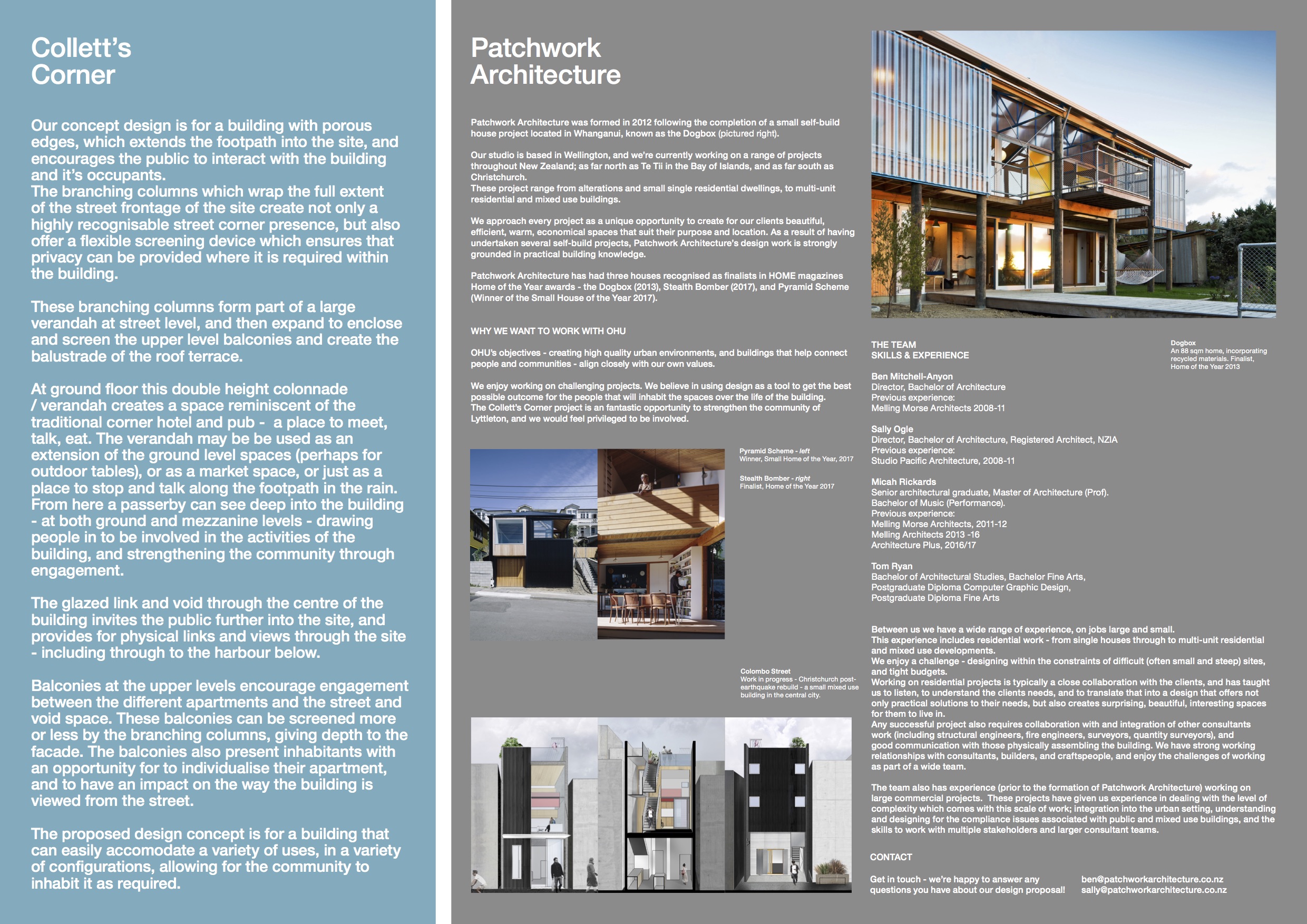
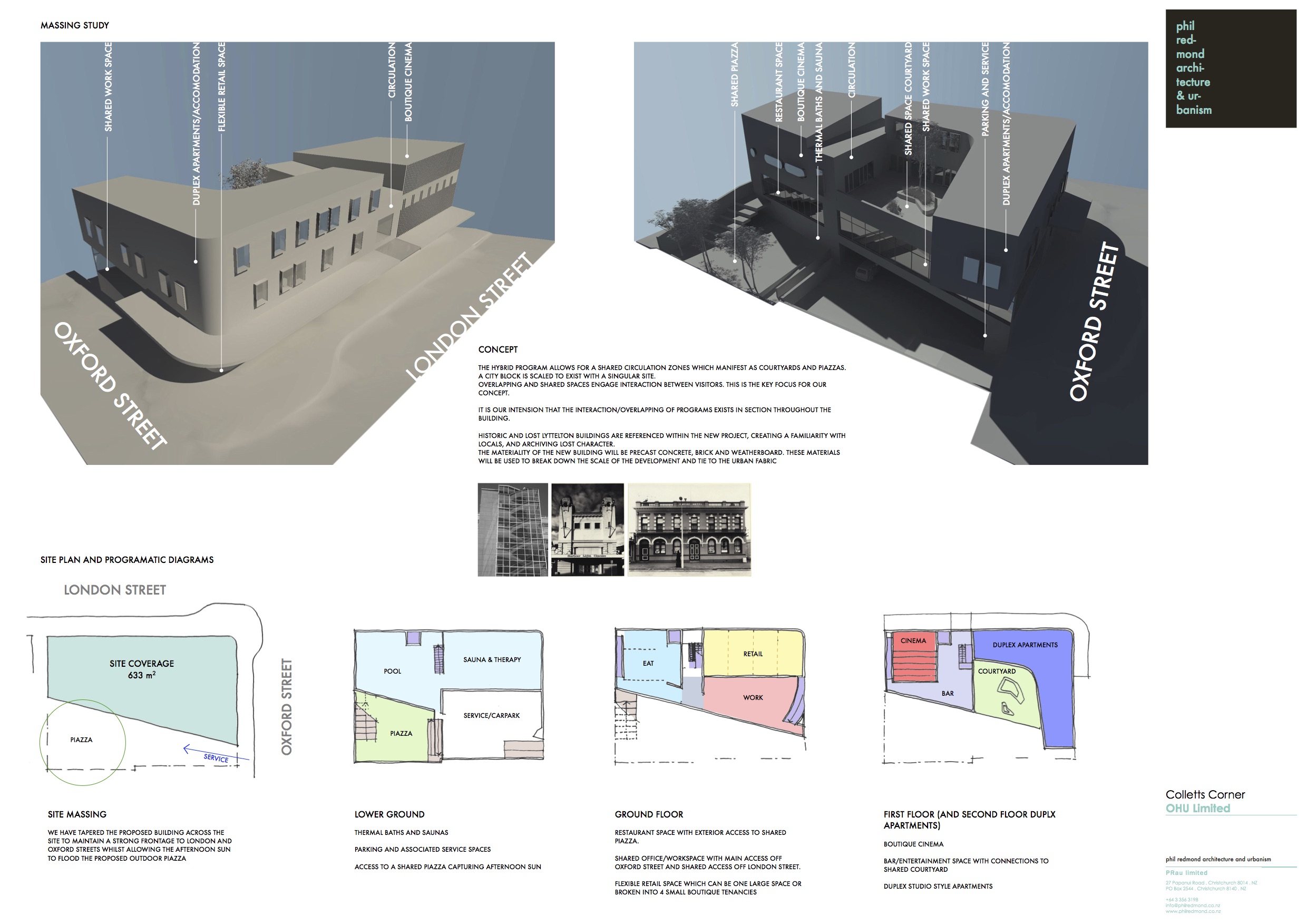
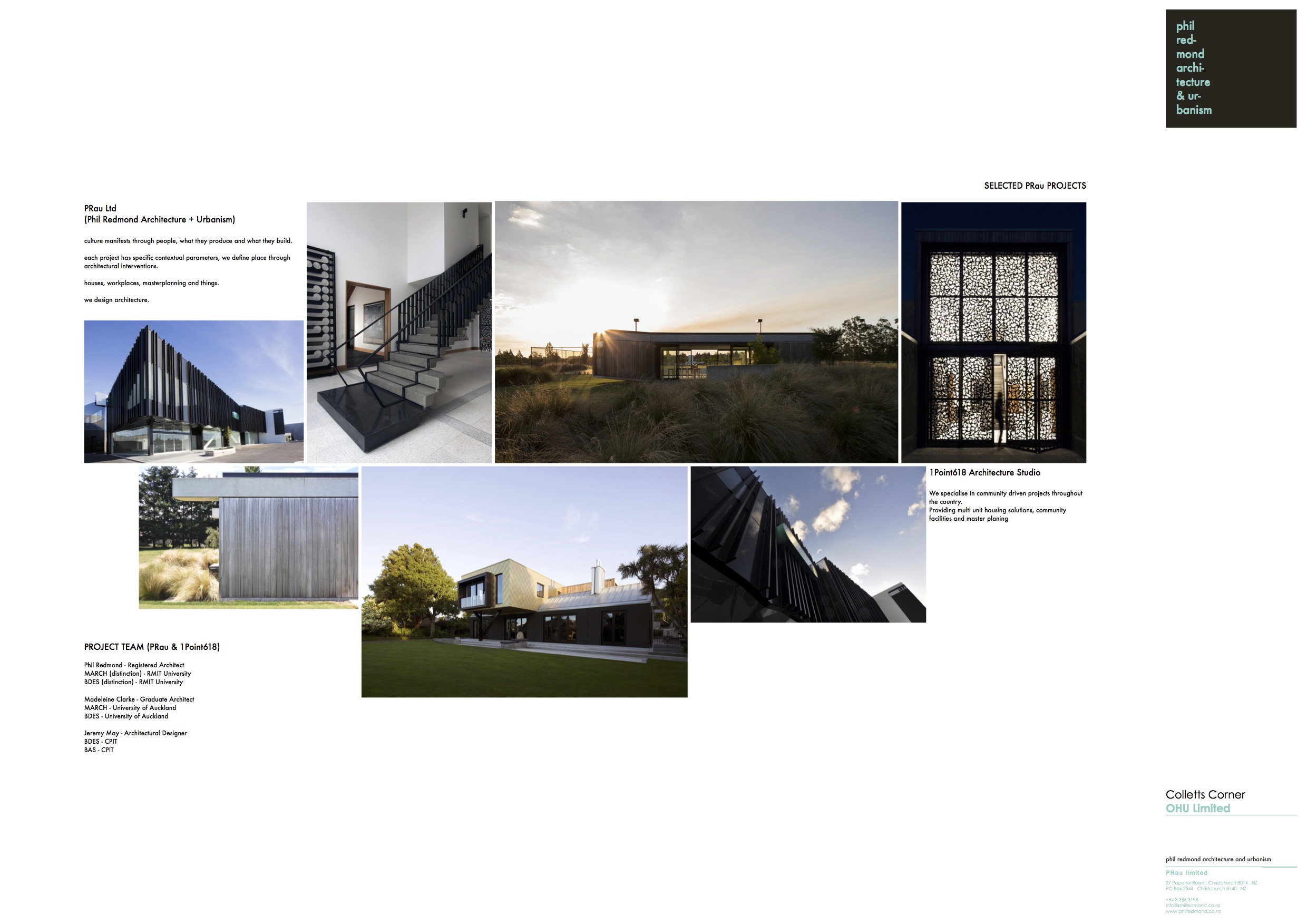
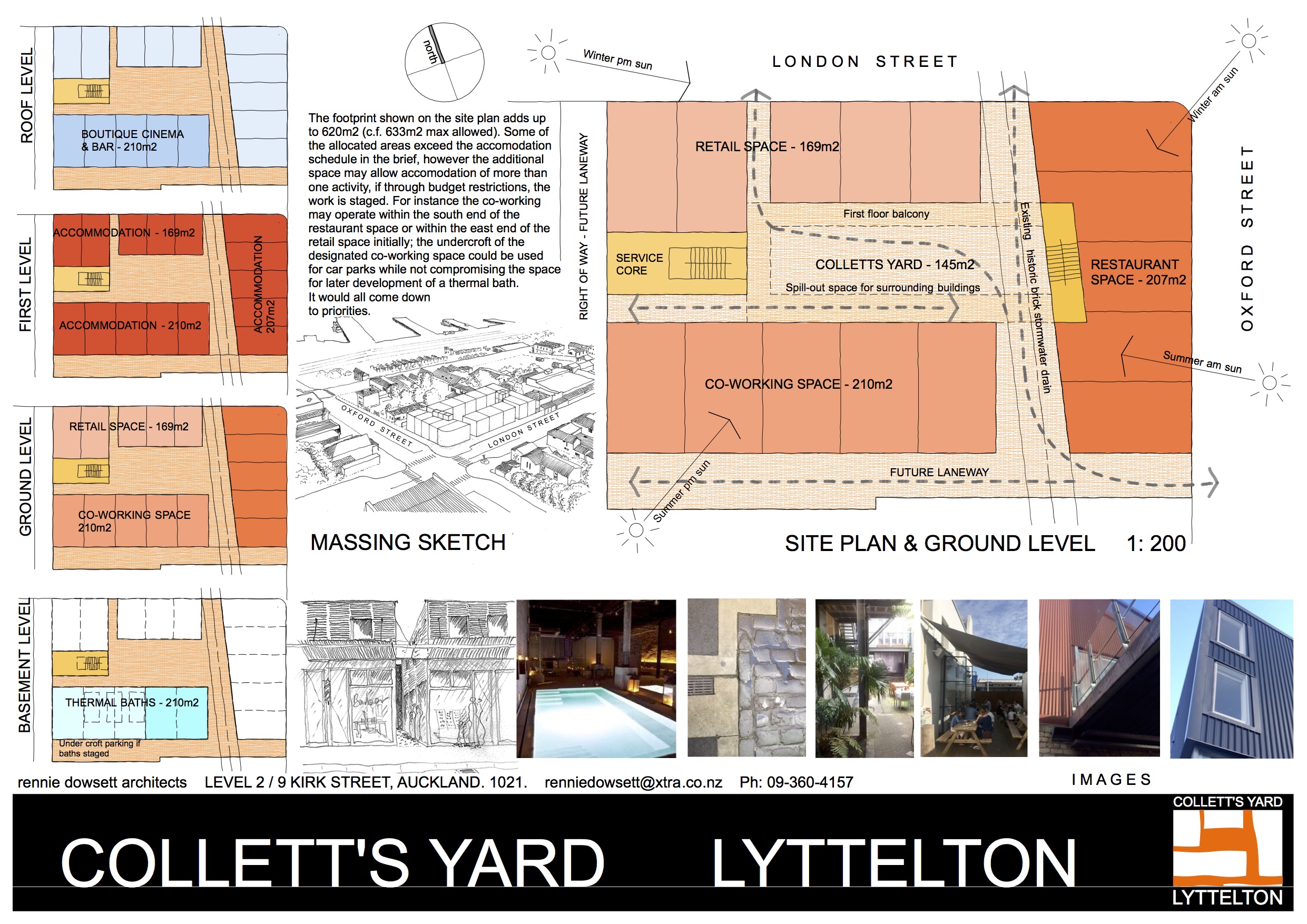
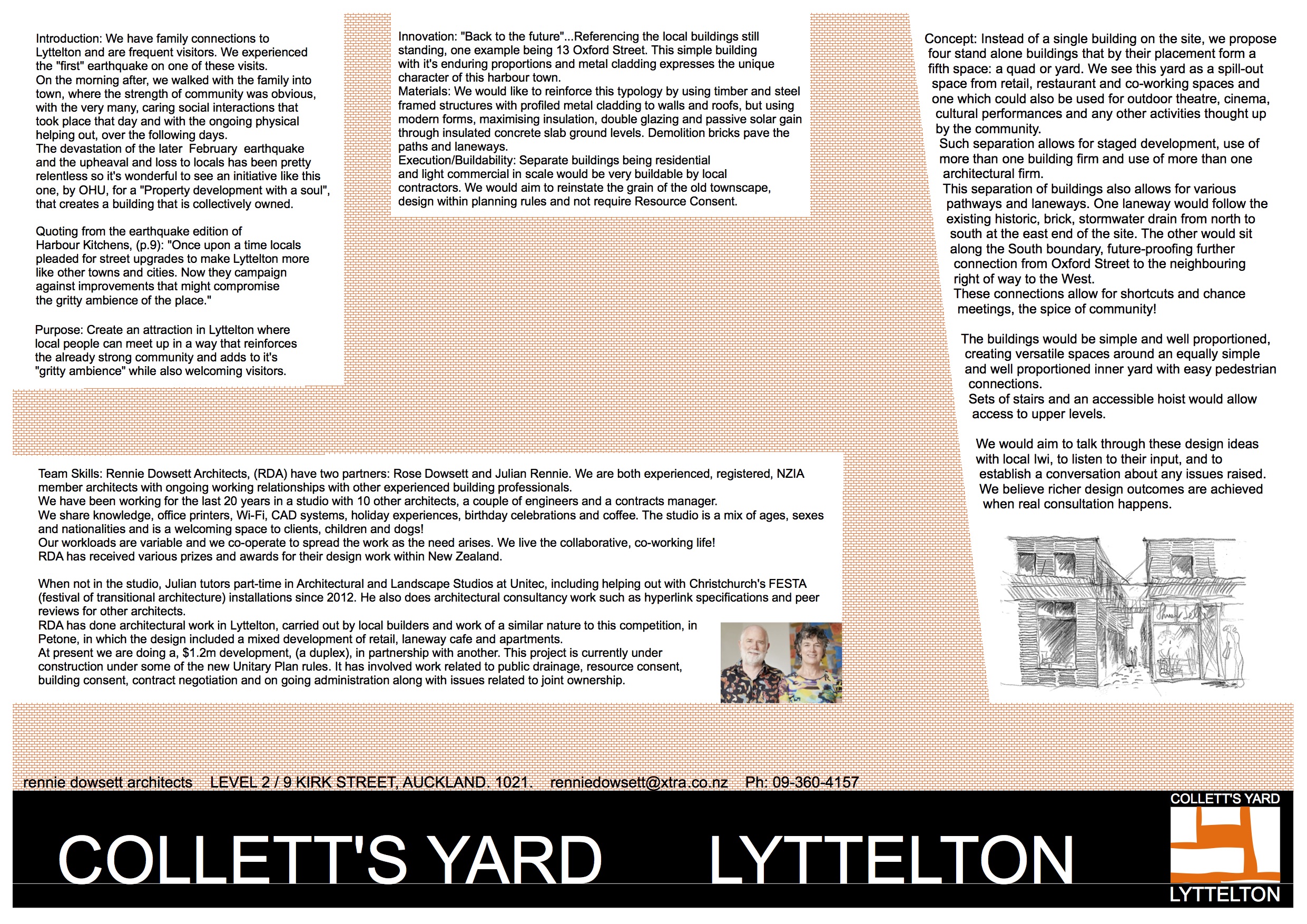
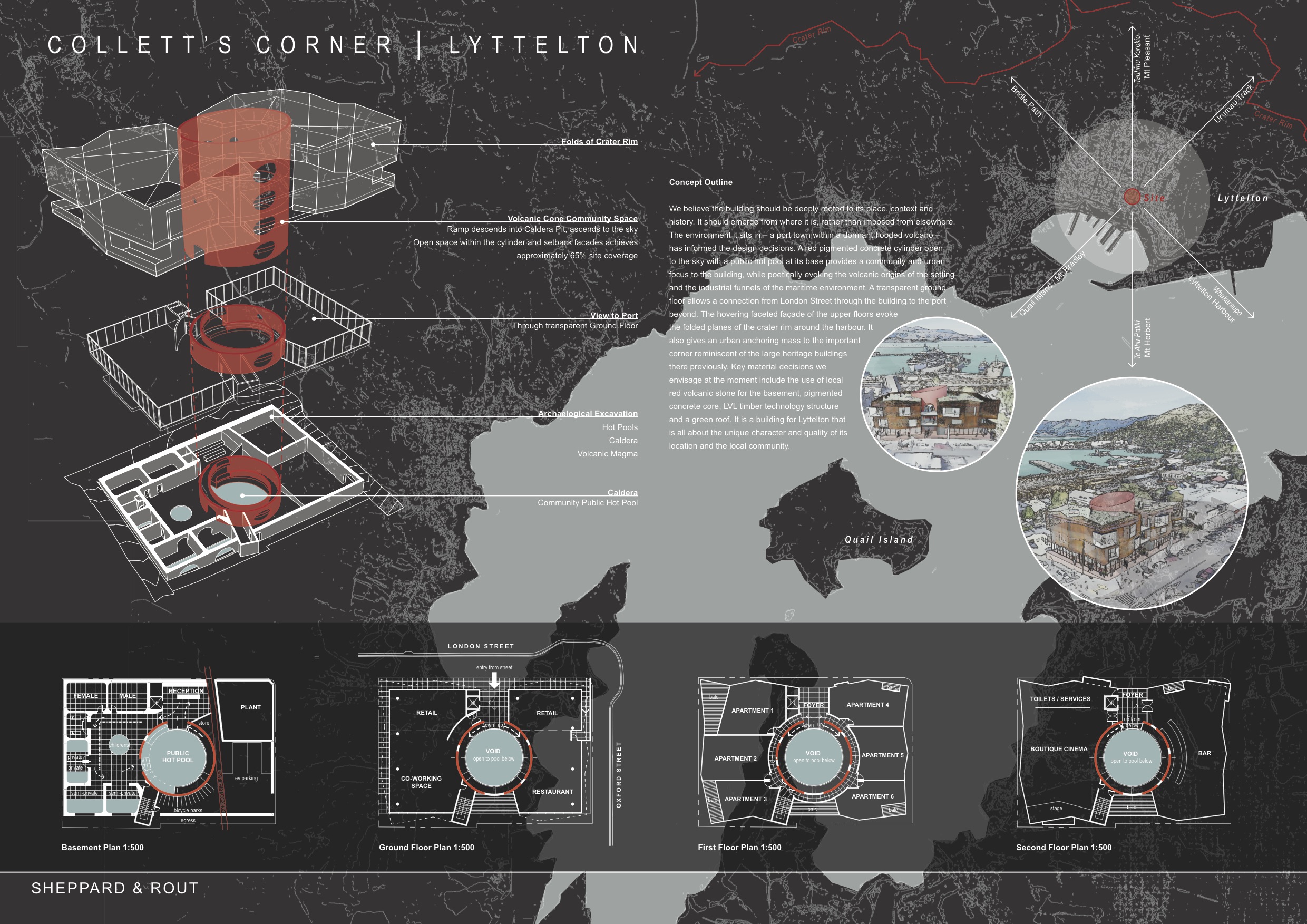
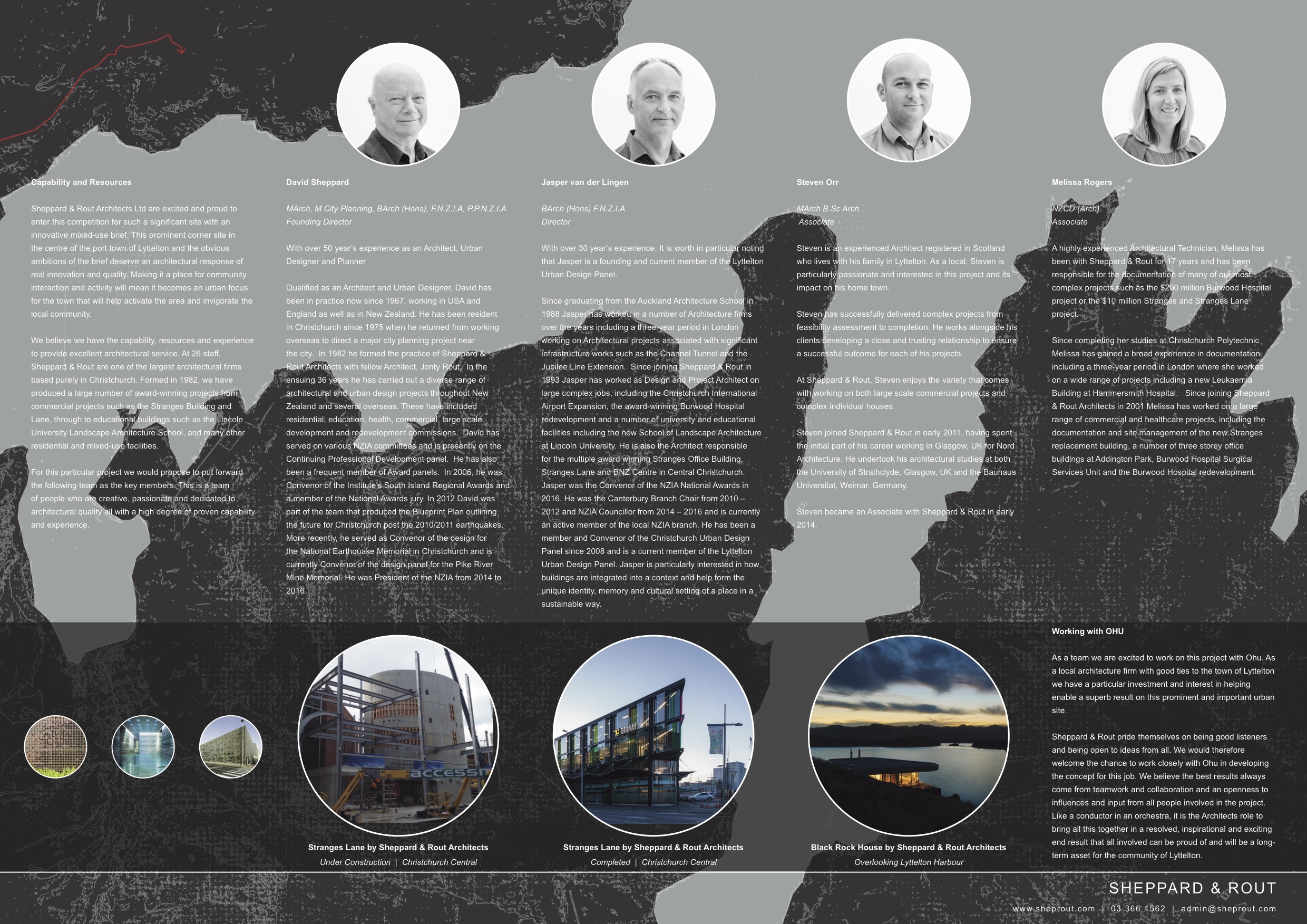

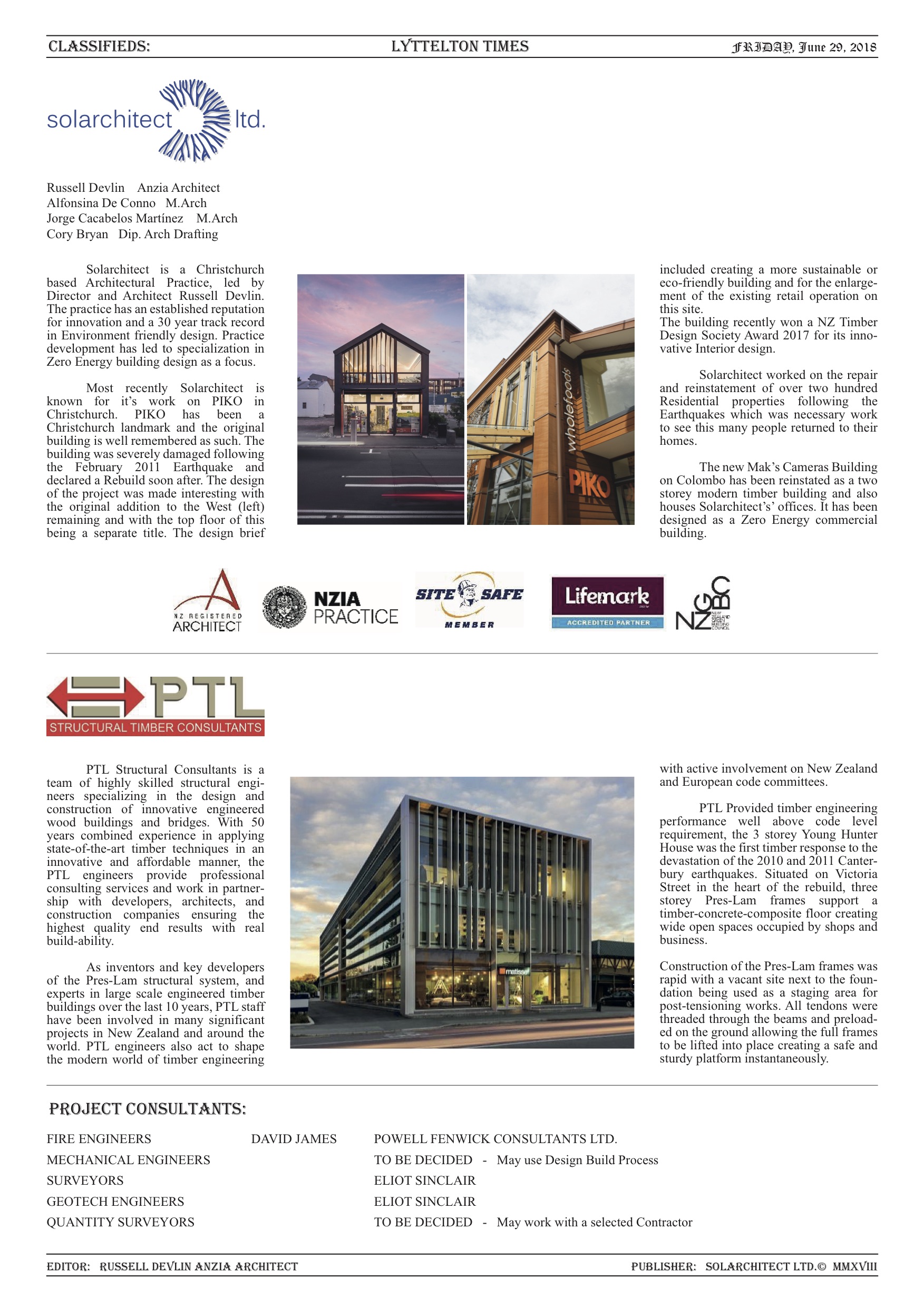
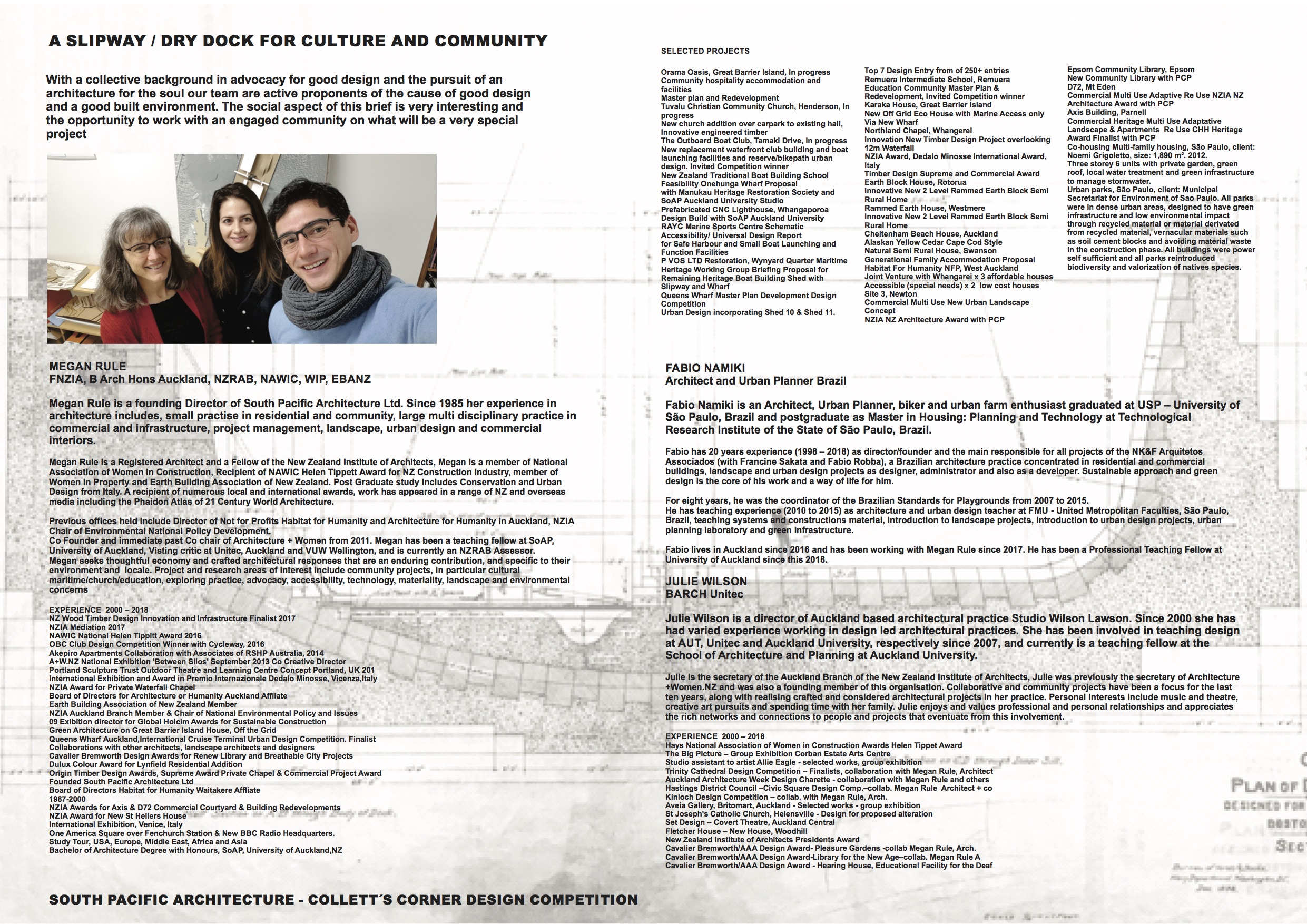
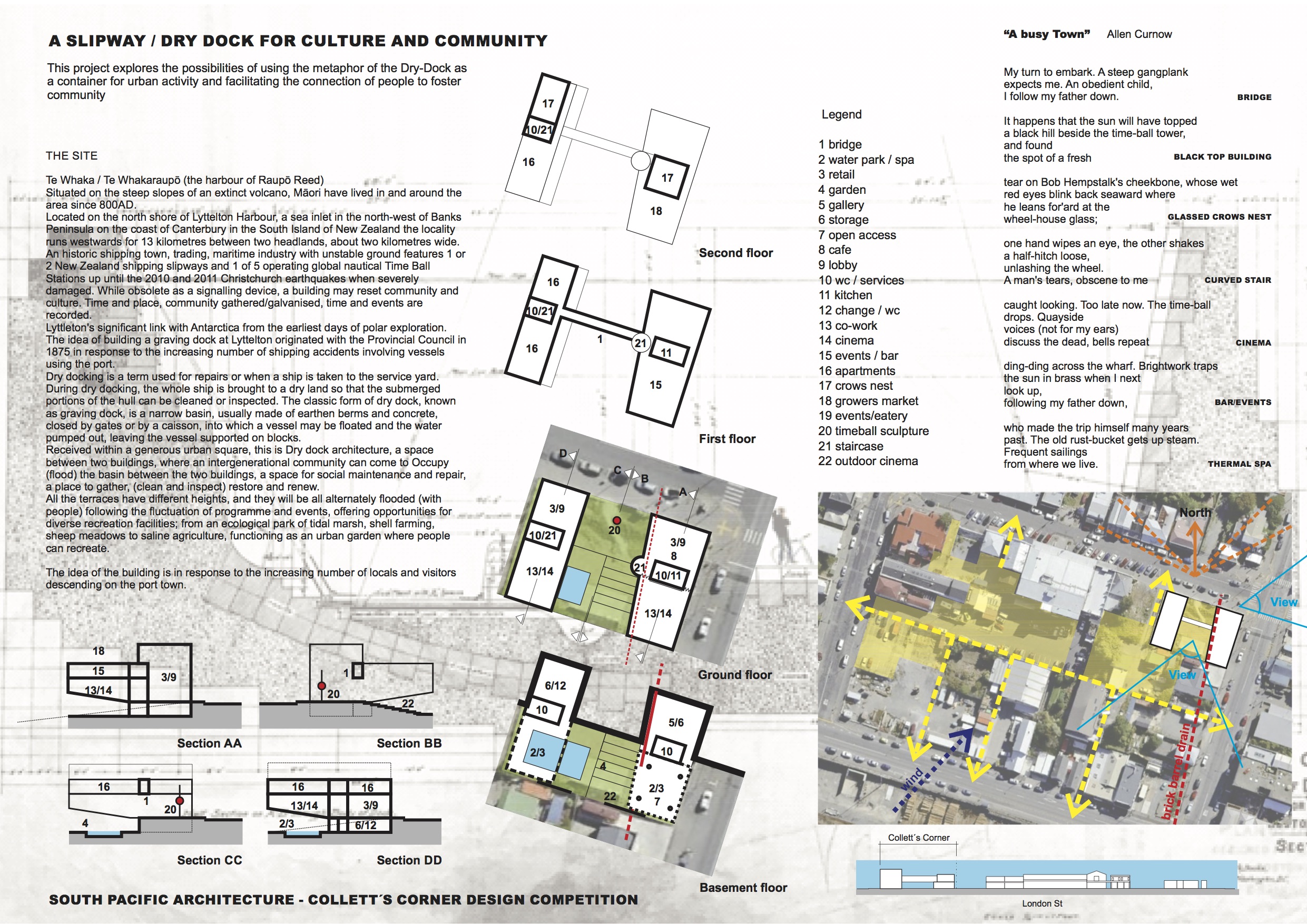
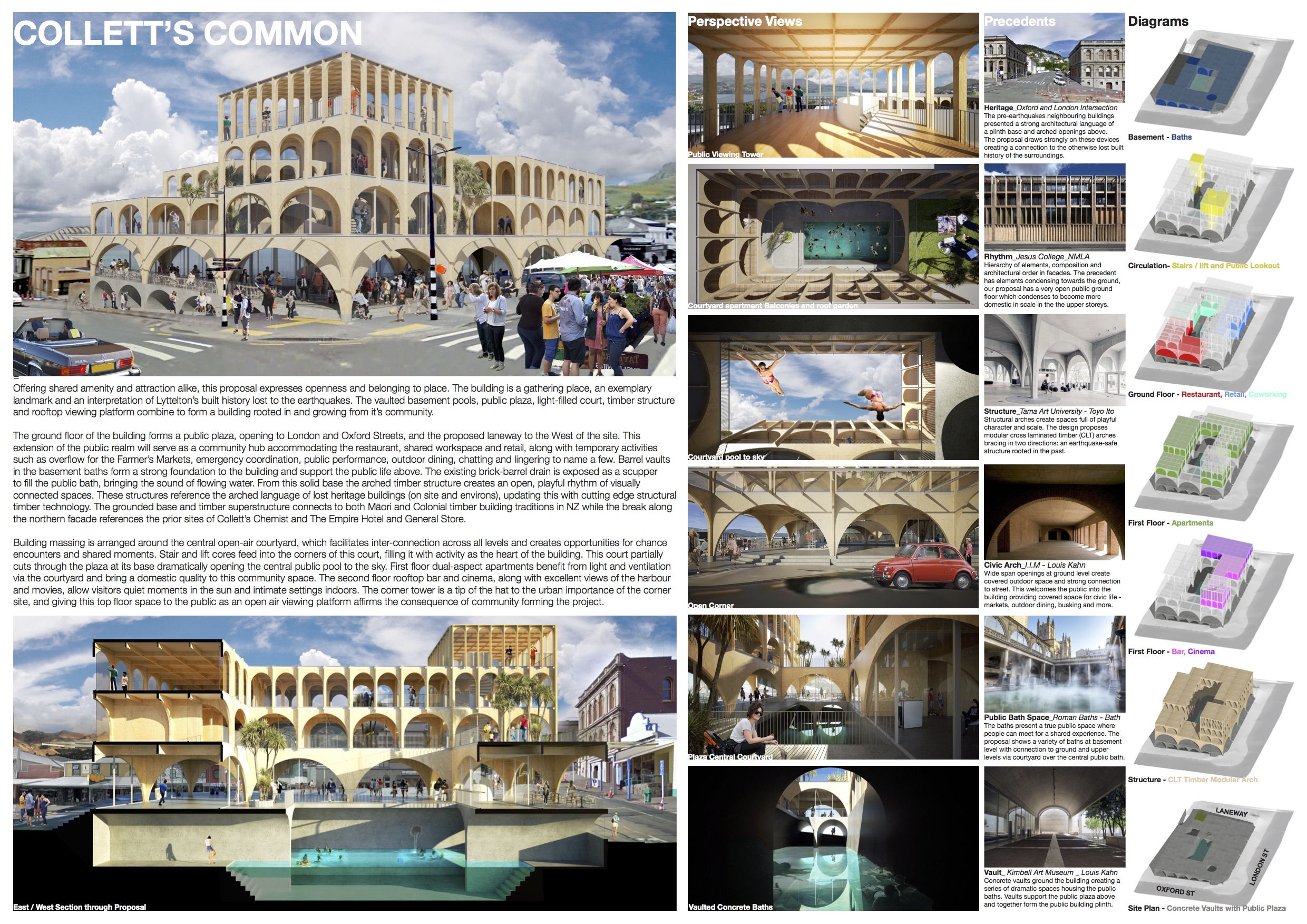
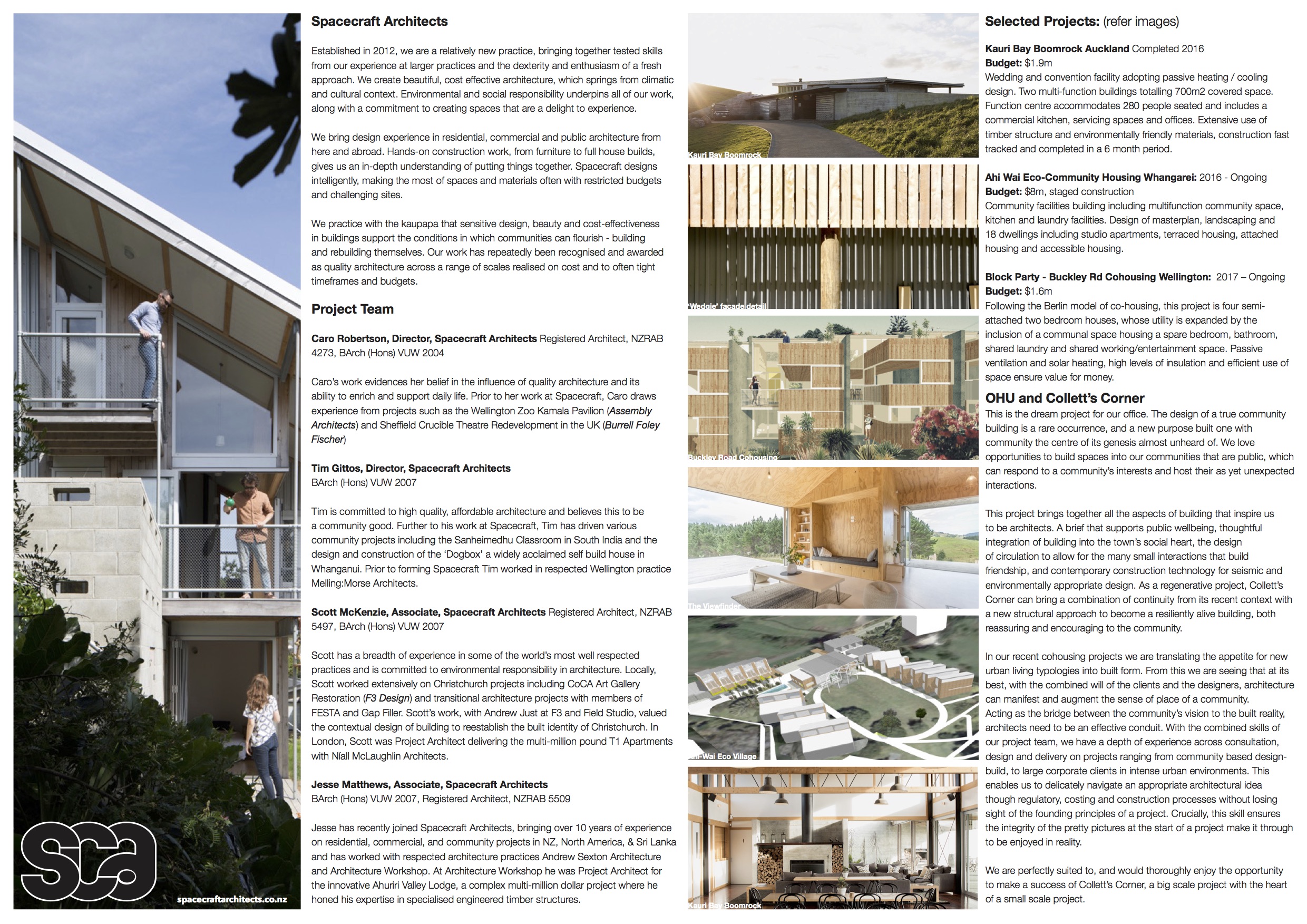
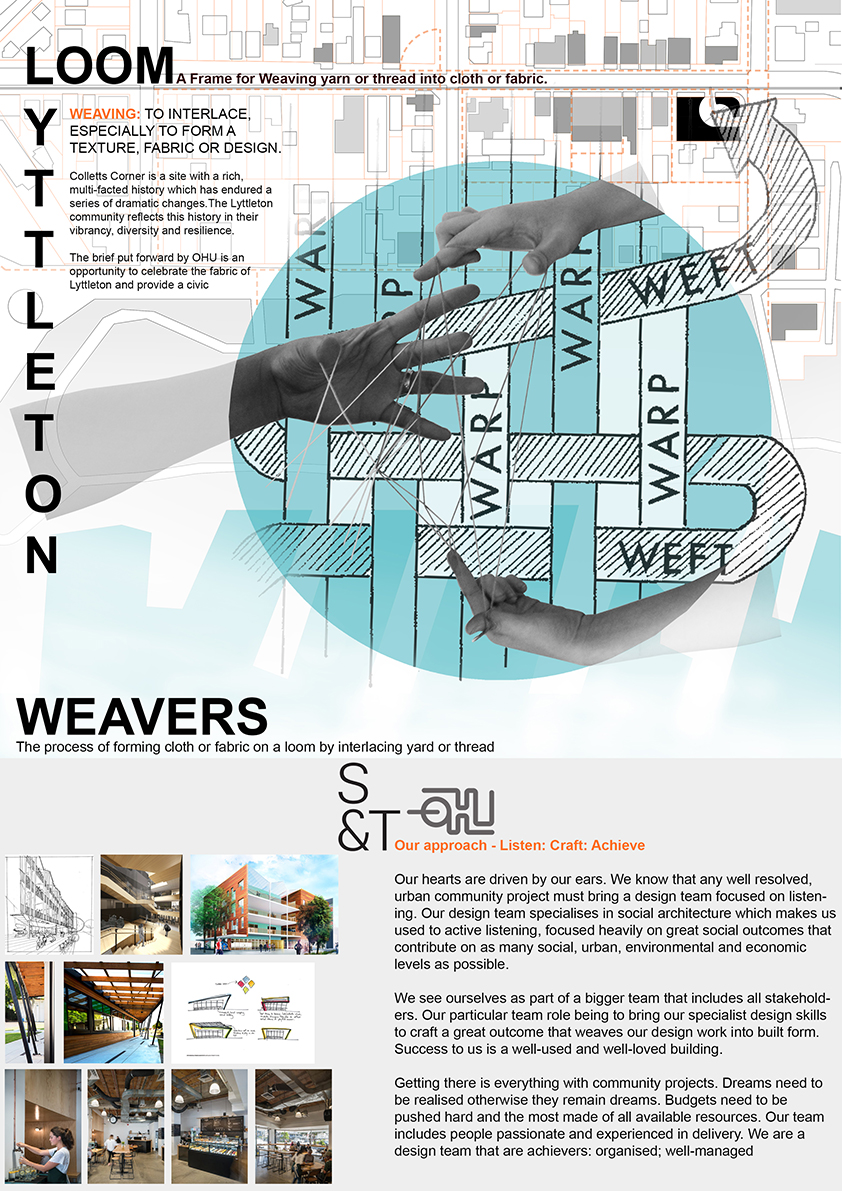
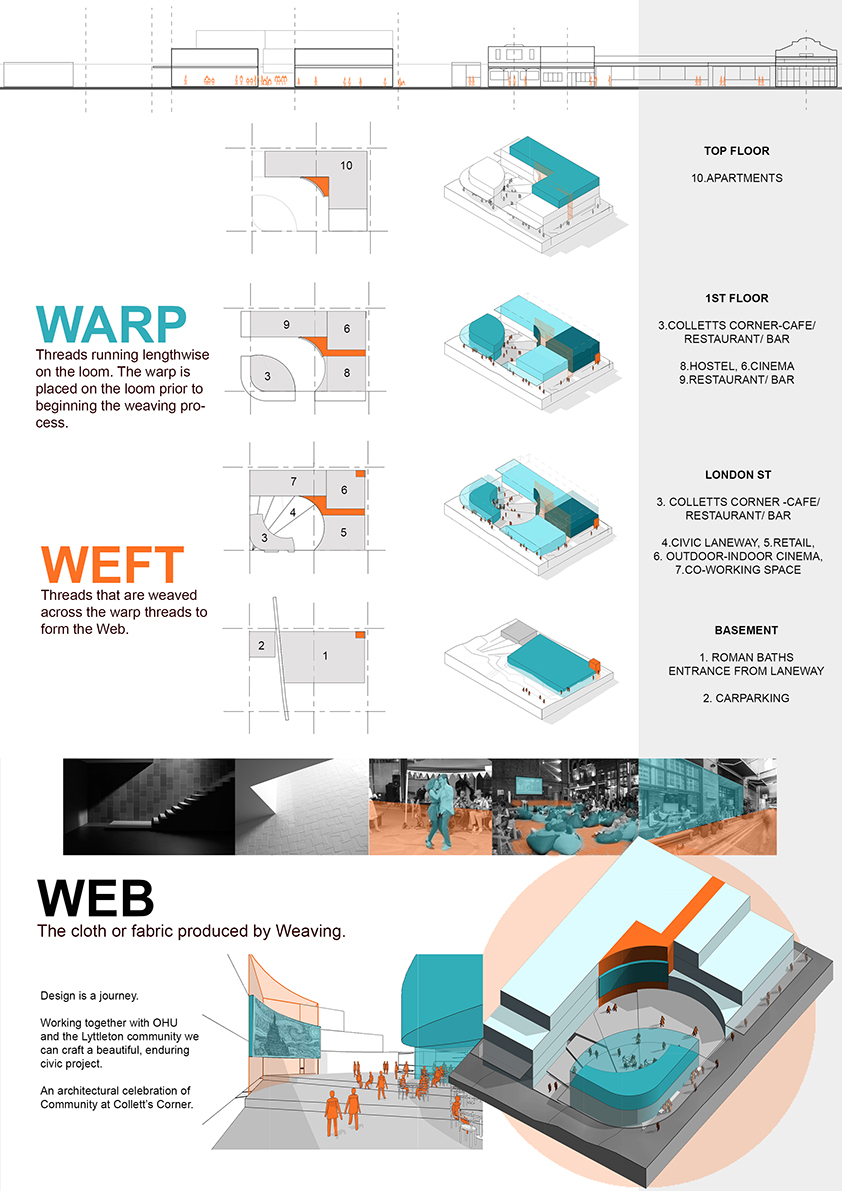
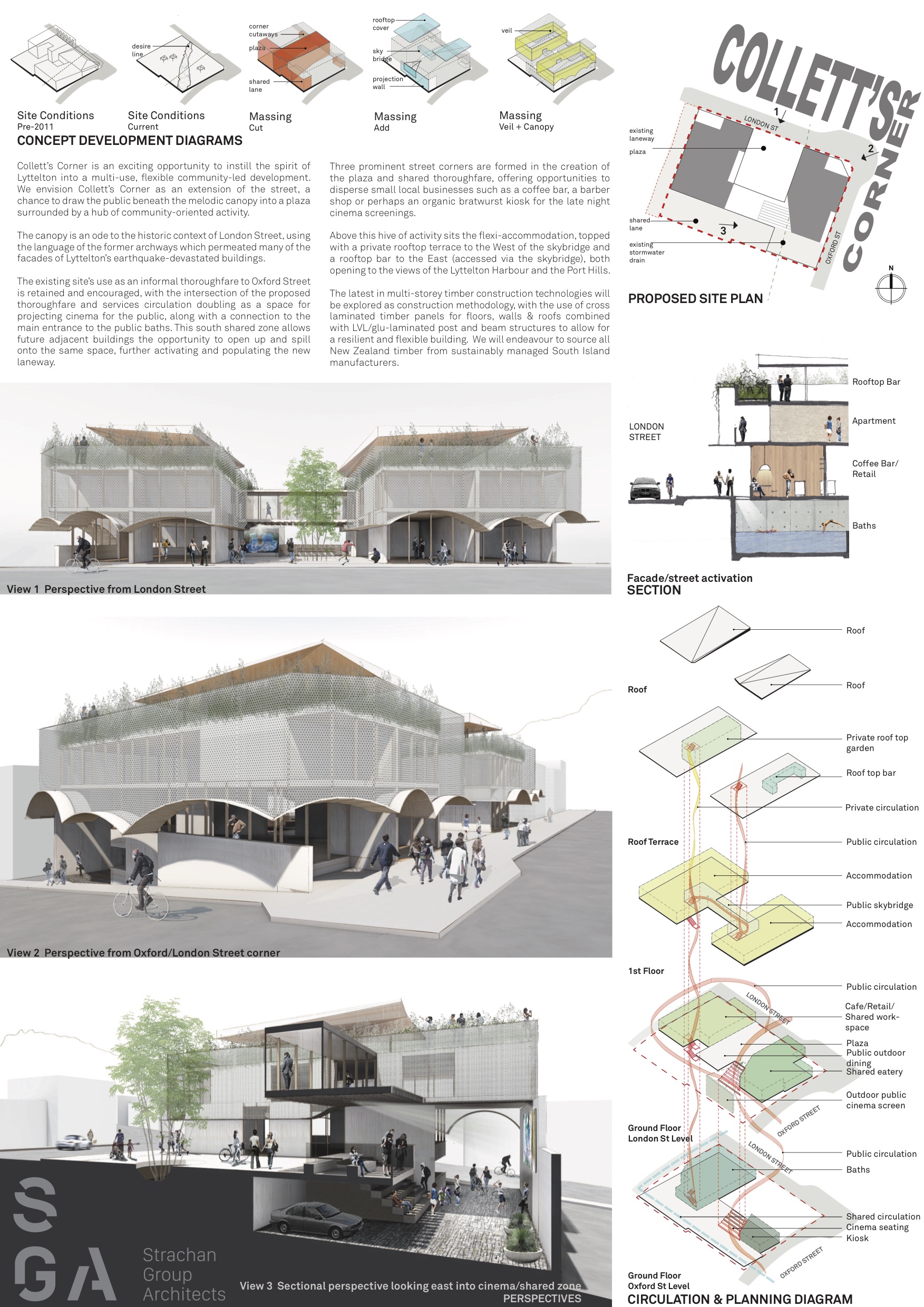
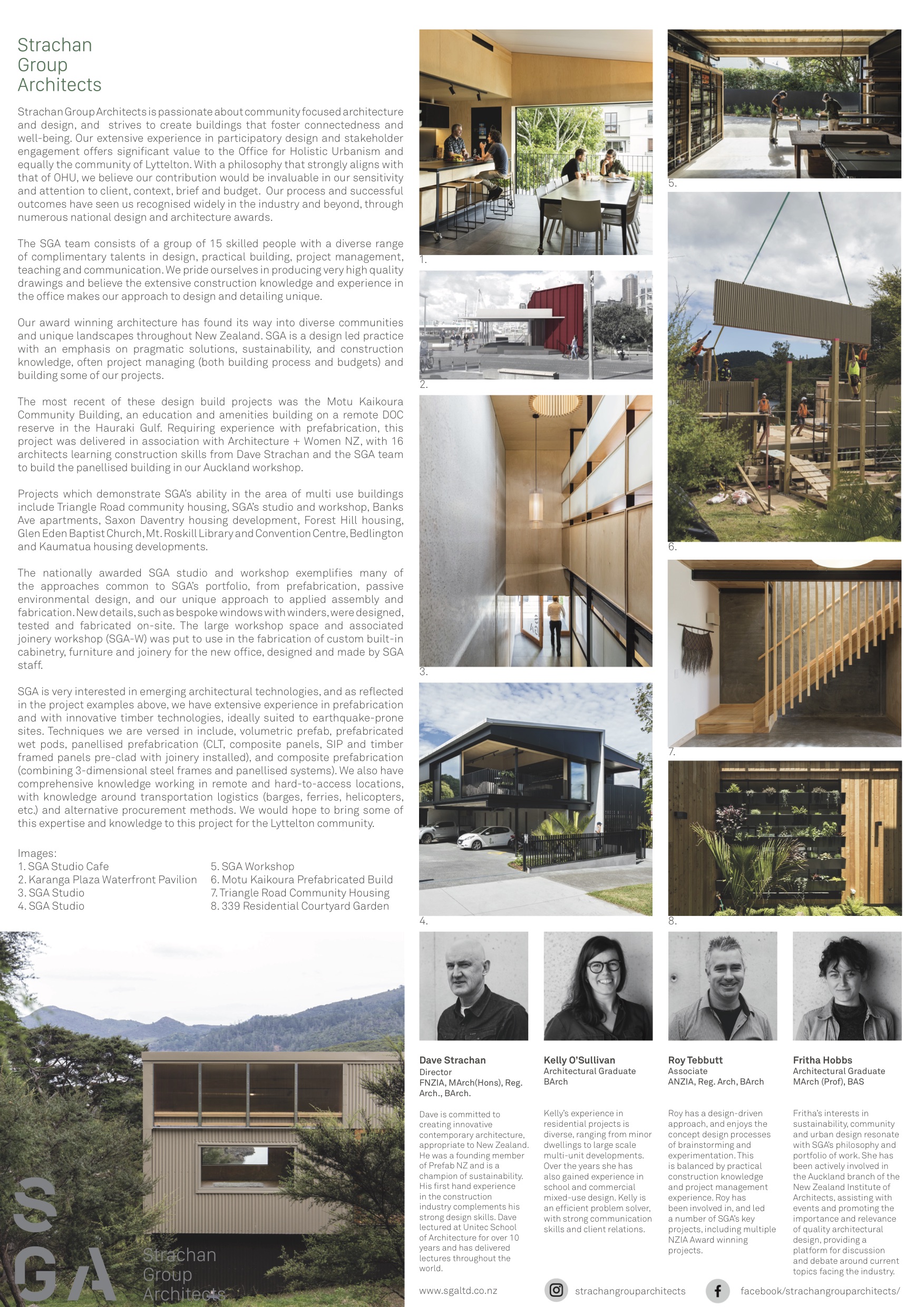
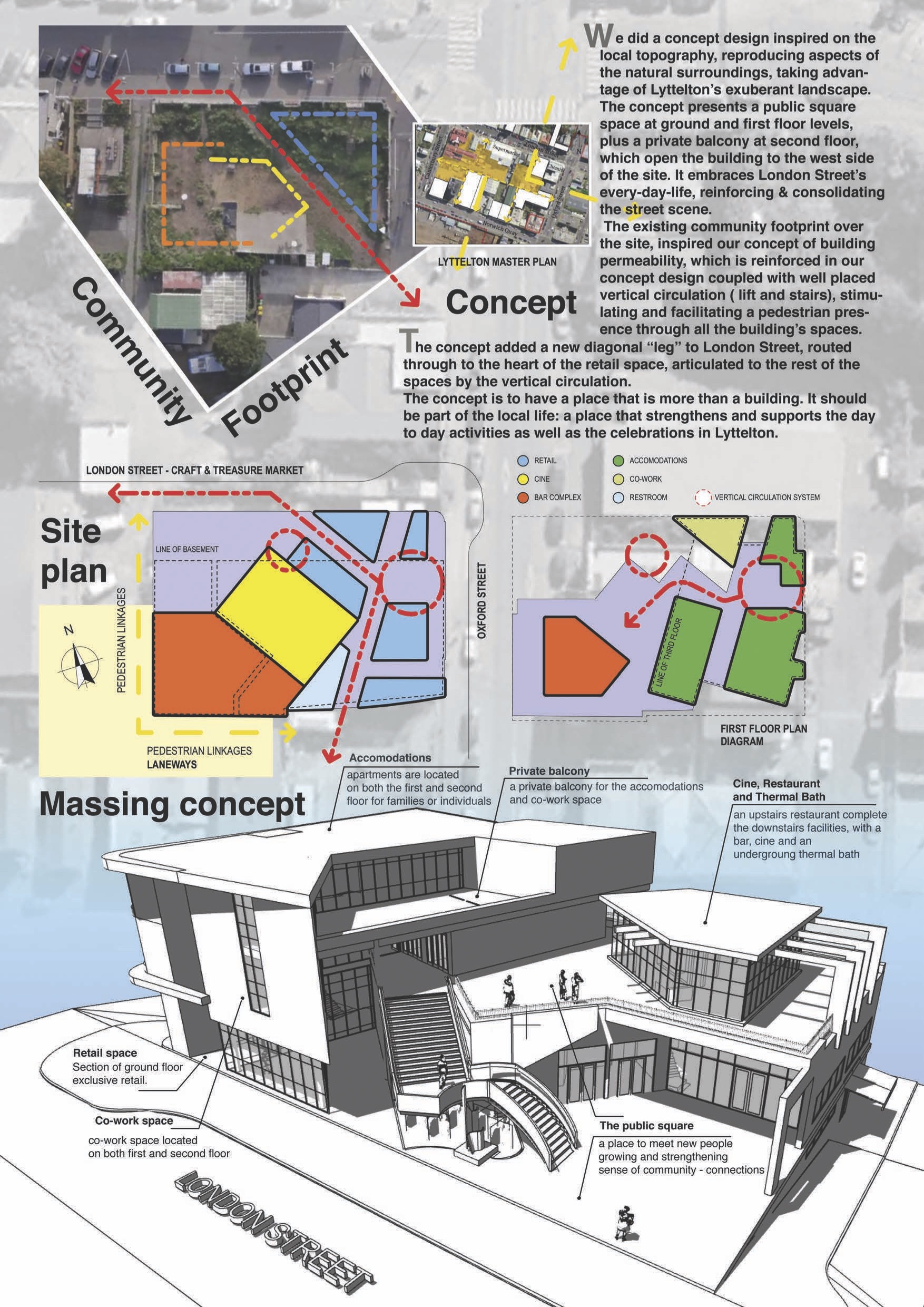


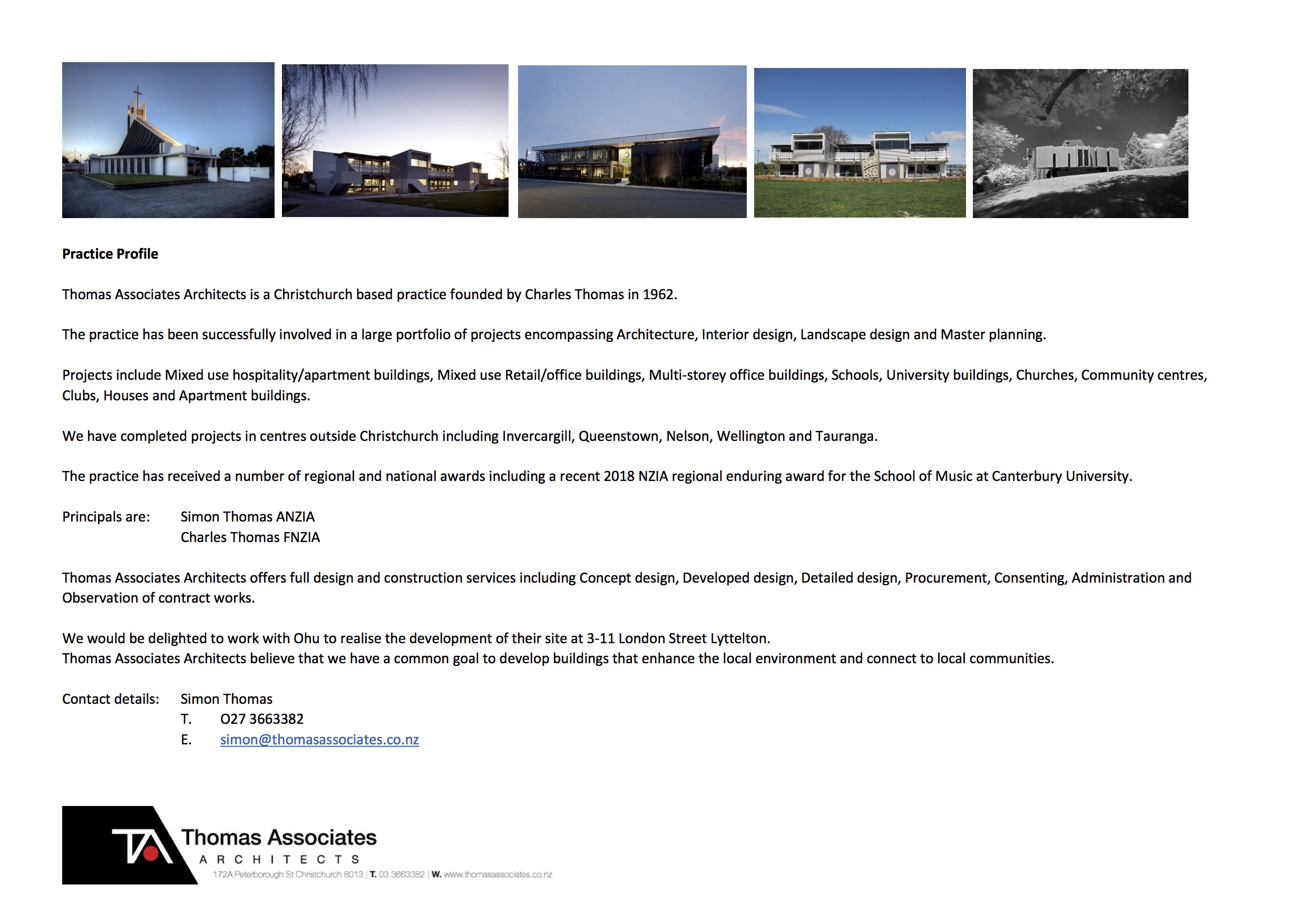
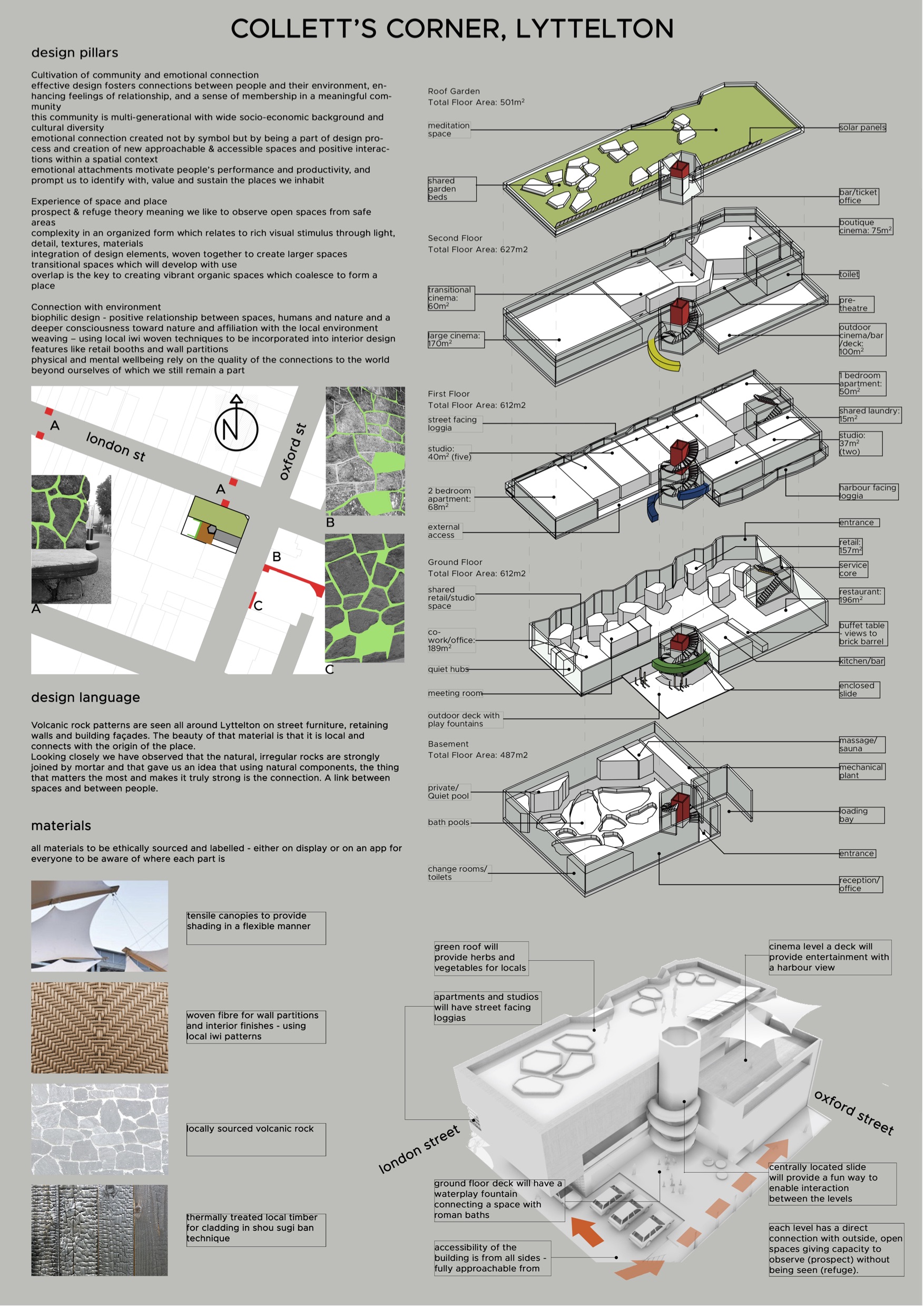
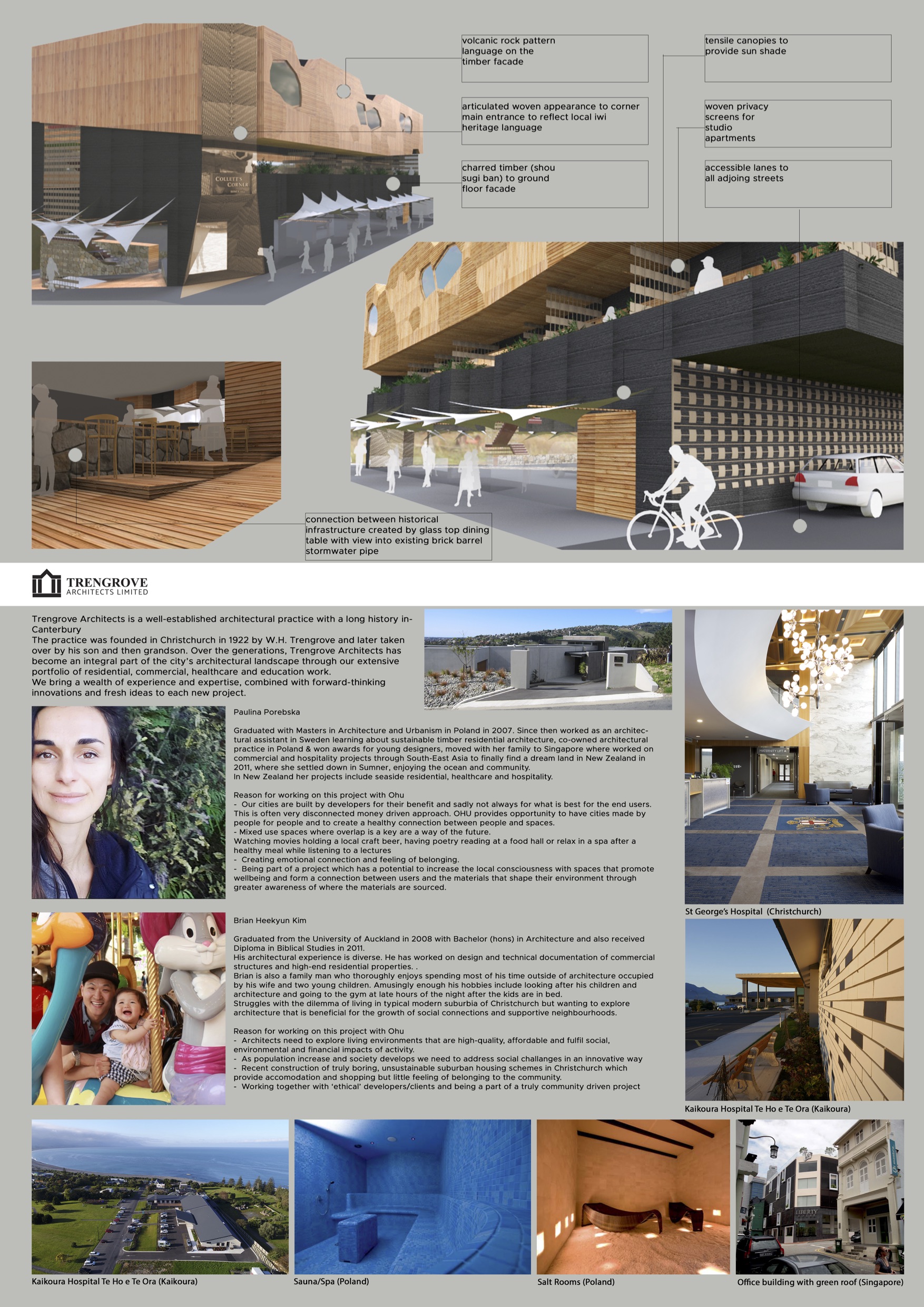
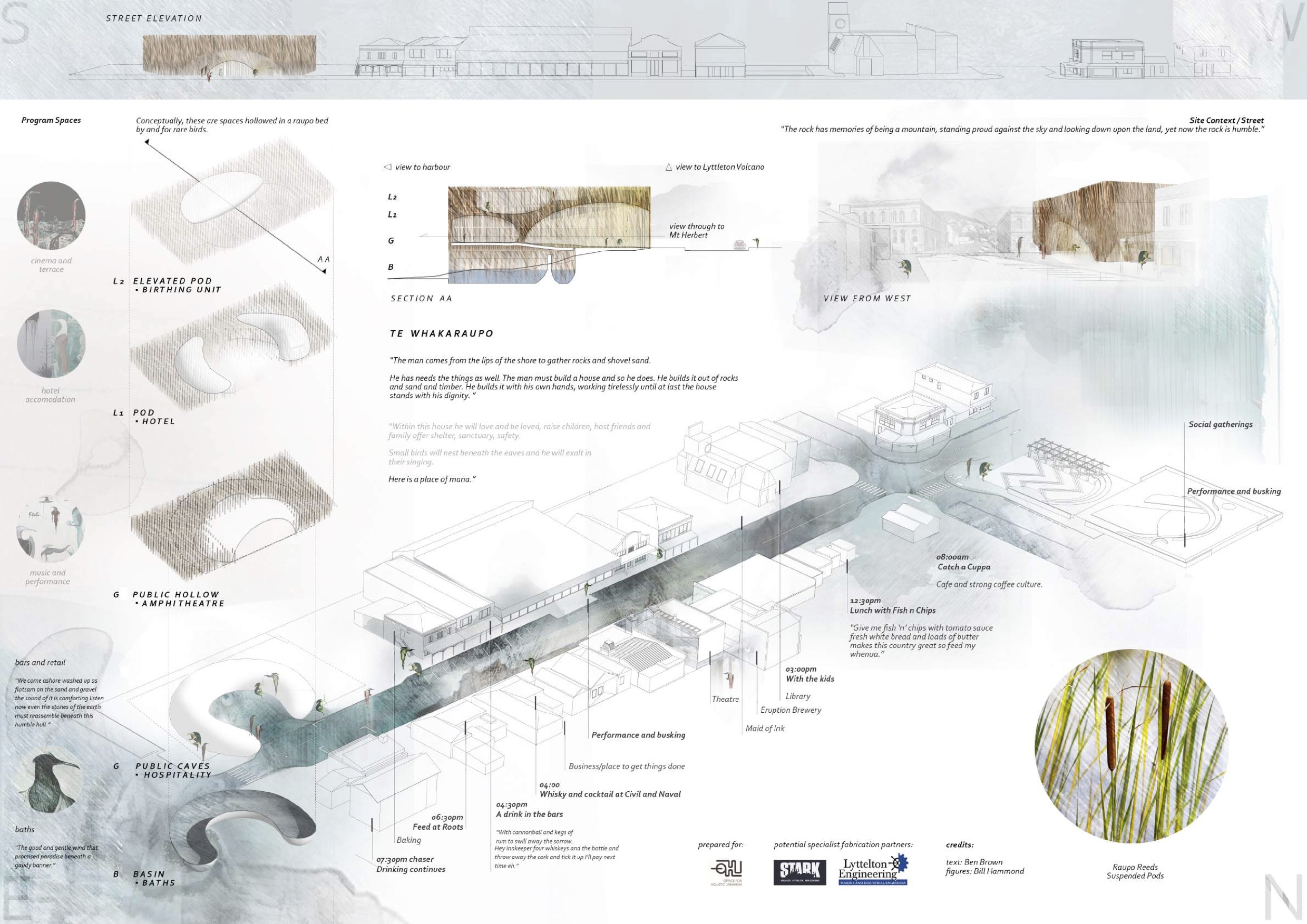
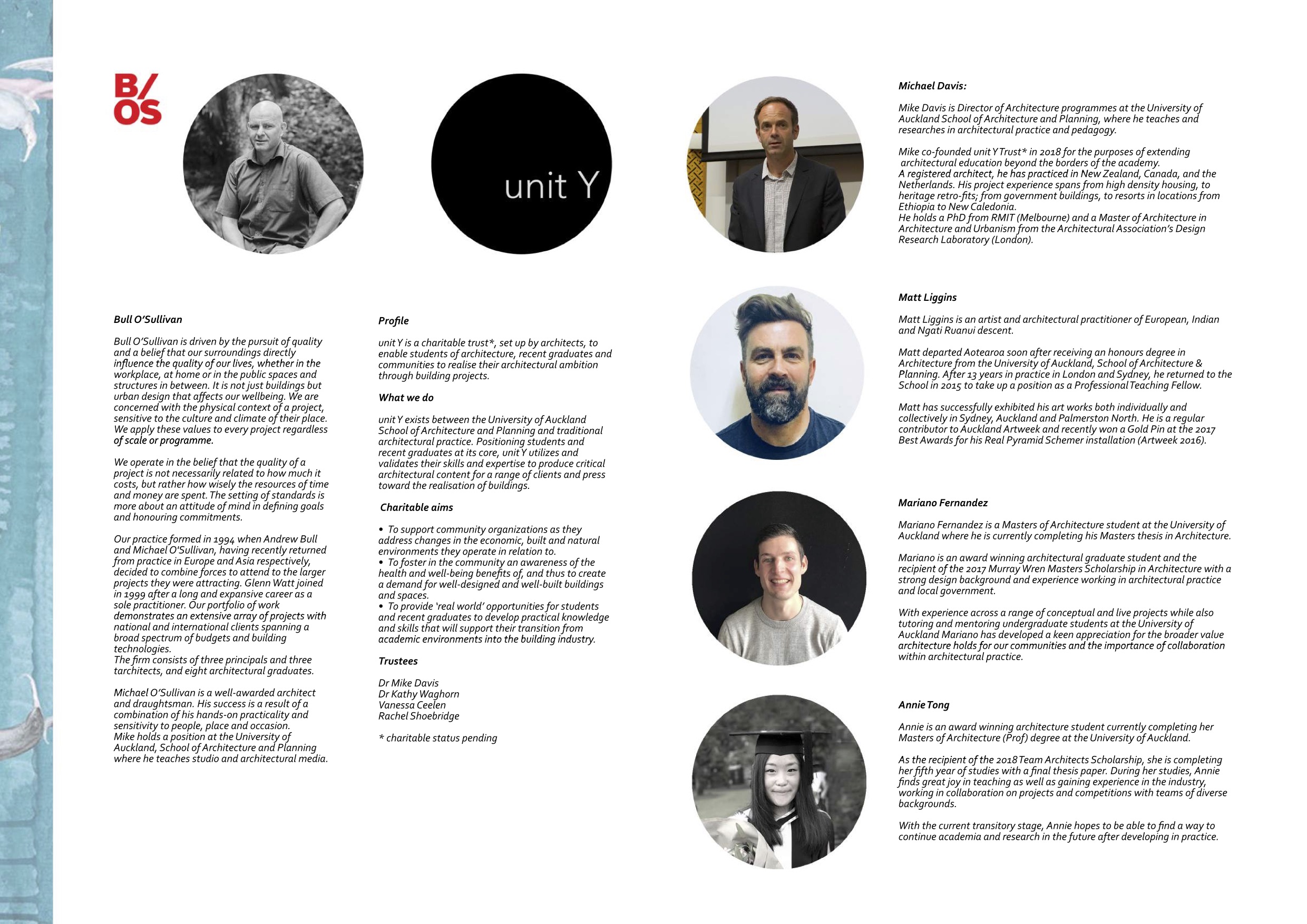





42 Comments
love
Love this one!
Innovative and references Lyttleton’s maritime history . Love the idea of local architects being involved in this development and their understanding of the towns unique qualities and how spaces work within that context will bring an equally unique perspective..
More than apartments I think short-term accommodation is more appropriate for the location, love the pod hotel idea.
This plan has real appeal and great practical application
Wow, what a compilation. Thanks also for allowing multiple selections!
Awesome!!! I love it
All projects are good in their own way, but “It’s Social!” caught my eye the most.
Many great idea’s .Lucky Littleton.
Amazing
Fantastic design
Bowline knot is a great idea on a lot of levels – community / function / structure / design / even texture. Would love to see development of this idea.
A lot of great ideas! Looking forward to experiencing the final outcome!
The Wharf and Jetty have potential.
a real education opportunity
Very nice!
Amazing!!
Very innovate and inclusive concepts with the Bowline idea.
Great
Very interesting event.
What a very beautiful harmony with glass and bricks – ” THE LODESTAR” is very nice !
Great idea lov it
Tihei Kauri ora would engage well with the street
Good to see many ideas, wonder though how it’s going to pass as a modern design with the CC heritage design rules for London St?
The Bowline Knot, with its link to things maritime and representations and feelings of connection, is an ideal design for this space.
Love these ideas. It’s Social fits the area IMO
Bowline Knot project appeals to me because like the knot, the space would be practical, commodious and pleasing to inhabit.
Well done all. Wish all contestants the best
Tihei Mauri Ora !! (literally means mauri alive or life force)
Very intresting event, nice.
The Bowline Knot is a very innovative design, which fits the brief perfectly. It emphasizes the connection with Lyttelton as a maritime town and provides very flexible spaces for a wide variety of uses.
The Bowline Knot: Te Herenga Tangata presents a clever linkage of Maoritanga with naval and Roman references and is a fascinating reflection of Lyttelton’s rich heritage and community. .
Vote made
Great designs
Tough choice so many good ideas, but vote made.
Many great projects, “Its social” seems like to have a good proposal.
Love AKAU
Love Rangitahi!
I only needed one vote…and that was for The Grid.
Love the Rangatahi Project by Akau. They are the future.
THE LODESTAR for me ! Wonderful !
Lots of exciting designs with a strong sense of environment and community. Well done! Didn’t make our top 3, but we specially liked Connections – my 9 year picked up on the slide instantly.